
Richard Branson
Sir Richard Charles Nicholas Branson is a British billionaire, entrepreneur, and business magnate. In the 1970s he founded the Virgin Group, which today controls more than 400 companies in various fields.
Richard Branson becomes the first civilian to be launched into space via his Virgin Galactic spacecraft.

Sir Richard Charles Nicholas Branson is a British billionaire, entrepreneur, and business magnate. In the 1970s he founded the Virgin Group, which today controls more than 400 companies in various fields.

Virgin Galactic is an American spaceflight company founded by Richard Branson and his British Virgin Group retains an 11.9% stake through Virgin Investments Limited. It is headquartered in California, and operates from New Mexico. The company is developing commercial spacecraft and aims to provide suborbital spaceflights to space tourists. Virgin Galactic's suborbital spacecraft are air launched from beneath a carrier airplane known as White Knight Two. Virgin Galactic‘s maiden spaceflight occurred in 2018 with its VSS Unity spaceship. Branson had originally hoped to see a maiden spaceflight by 2010, but the date was delayed for several years, primarily due to the October 2014 crash of VSS Enterprise.
Italy defeats England in the UEFA Euro 2020 Final to win their second European title.

The Italy national football team has represented Italy in international football since its first match in 1910. The national team is controlled by the Italian Football Federation (FIGC), the governing body for football in Italy, which is a co-founder and member of UEFA. Italy's home matches are played at various stadiums throughout Italy, and its primary training ground and technical headquarters, Centro Tecnico Federale di Coverciano, is located in Florence. Italy are the reigning European champions, having won UEFA Euro 2020.

The England national football team has represented England in international football since the first international match in 1872. It is controlled by The Football Association (FA), the governing body for football in England, which is affiliated with UEFA and comes under the global jurisdiction of world football's governing body FIFA. England competes in the three major international tournaments contested by European nations: the FIFA World Cup, the UEFA European Championship, and the UEFA Nations League.

The UEFA Euro 2020 Final was a football match between England and Italy that took place at Wembley Stadium in London, England, on 11 July 2021 to determine the winner of UEFA Euro 2020. It was the 16th final of the UEFA European Championship, a quadrennial tournament contested by the senior men's national teams of the member associations of UEFA to decide the champions of Europe. Originally scheduled for 12 July 2020, the match had been postponed along with the rest of the tournament due to the COVID-19 pandemic in Europe.

The UEFA European Football Championship, less formally the European Championship and informally the Euro, is the primary association football tournament organised by the Union of European Football Associations (UEFA). The competition is contested by UEFA members' senior men's national teams, determining the continental champion of Europe. The competition has been held every four years since 1960, except for 2020, when it was postponed until 2021 due to the COVID-19 pandemic in Europe, but kept the name Euro 2020. Scheduled to be in the even-numbered year between FIFA World Cup tournaments, it was originally called the European Nations' Cup, changing to the current name in 1968. Since 1996, the individual events have been branded as "UEFA Euro [year]".
Joaquín "El Chapo" Guzmán escapes from the maximum security Altiplano prison in Mexico, his second escape.

Joaquín Archivaldo Guzmán Loera, commonly known as "El Chapo", is a Mexican former drug lord and a former leader within the Sinaloa Cartel, an international crime syndicate. He is considered to have been one of the most powerful drug traffickers in the world.
The Federal Social Readaptation Center No. 1 "Altiplano" is the maximum security federal prison of the Secretariat of Public Security in Mexico. This facility is located in the Santa Juana Centro neighborhood of Almoloya de Juárez, in the State of Mexico, 25 kilometers (16 mi) from Toluca.
An explosion at the Evangelos Florakis Naval Base killed 13 people, including the head of the Cyprus Navy.

On 11 July 2011, at Evangelos Florakis Naval Base, situated at Mari, Larnaca in Cyprus, a large amount of ammunition and military explosives self-detonated, killing 13 people, including the Commander of the Cyprus Navy, Andreas Ioannides, the base commander, Lambros Lambrou, and six firefighters. A further 62 people were injured. The explosion was the worst peacetime military accident ever recorded in Cyprus, with a yield of approximately 481 tons TNT equivalent, as determined by the official investigation into the accident. It was the largest artificial non-nuclear explosion of the 21st century until the 2020 Beirut explosions.
The Evangelos Florakis Naval Base is a Cyprus Navy base, situated on the island's southern coast adjacent to the Vasilikos industrial area and power plant, near Zygi, between Limassol and Larnaca.

The Cyprus Naval Command is the armed sea wing of the Cyprus National Guard. The Cypriot Navy has the primary mission of defending the maritime borders of the Republic of Cyprus, but is currently unable to access the waters around Northern Cyprus, which have been controlled by the Turkish Navy since the 1974 Turkish invasion of Cyprus. This force does not possess any capital ships or other major warships, but is equipped with patrol boats, landing craft, surface-to-surface missile systems and integrated radar systems, as well as SEALs-type naval underwater demolitions units.
Ninety-eight containers of explosives self-detonate killing 13 people in Zygi, Cyprus.

On 11 July 2011, at Evangelos Florakis Naval Base, situated at Mari, Larnaca in Cyprus, a large amount of ammunition and military explosives self-detonated, killing 13 people, including the Commander of the Cyprus Navy, Andreas Ioannides, the base commander, Lambros Lambrou, and six firefighters. A further 62 people were injured. The explosion was the worst peacetime military accident ever recorded in Cyprus, with a yield of approximately 481 tons TNT equivalent, as determined by the official investigation into the accident. It was the largest artificial non-nuclear explosion of the 21st century until the 2020 Beirut explosions.
Zygi is a small village on the south coast of Cyprus, between Limassol and Larnaca. Before 1974, Zygi had a mixed Greek- and Turkish-Cypriot population.
The Islamist militia group Al-Shabaab carried out multiple suicide bombings in Kampala, Uganda, killing 74 people and injuring 85 others.
Islamism is a political ideology which posits that modern states and regions should be reconstituted in constitutional, economic and judicial terms, in accordance with what is conceived as a revival or a return to authentic Islamic practice in its totality.
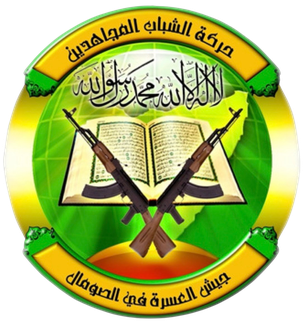
Harakat al-Shabaab al-Mujahideen, more commonly known as al-Shabaab, is an Islamic fundamentalist Salafi jihadist group which is based in Somalia and active elsewhere in East Africa. It is actively involved in the ongoing Somali Civil War. Even though its membership incorporates Somali nationalist elements, al-Shabaab's central aims are Salafi jihadist. Allegiant to the militant pan-Islamist organization al-Qaeda since 2012, it has also been suspected of forging ties with Boko Haram, al-Qaeda in the Islamic Maghreb, and al-Qaeda in the Arabian Peninsula.

On 11 July 2010, suicide bombings were carried out against crowds watching a screening of the 2010 FIFA World Cup Final at two locations in Kampala, the capital city of Uganda. The attacks left 74 dead and 85 injured. Al-Shabaab, an Islamist militia based in Somalia that has ties to al-Qaeda, claimed responsibility for the blasts as retaliation for Ugandan support for AMISOM. In March 2015, the trial of 13 Kenyan, Ugandan and Tanzanian alleged perpetrators of the bombings began at the High Court of Uganda.

Kampala is the capital and largest city of Uganda. The city proper has a population of 1,680,000 and is divided into the five political divisions of Kampala Central Division, Kawempe Division, Makindye Division, Nakawa Division, and Rubaga Division.
The Islamist militia group Al-Shabaab carried out multiple suicide bombings in Kampala, Uganda, killing 74 people and injuring 85 others.
Islamism is a political ideology which posits that modern states and regions should be reconstituted in constitutional, economic and judicial terms, in accordance with what is conceived as a revival or a return to authentic Islamic practice in its totality.

Harakat al-Shabaab al-Mujahideen, more commonly known as al-Shabaab, is an Islamic fundamentalist Salafi jihadist group which is based in Somalia and active elsewhere in East Africa. It is actively involved in the ongoing Somali Civil War. Even though its membership incorporates Somali nationalist elements, al-Shabaab's central aims are Salafi jihadist. Allegiant to the militant pan-Islamist organization al-Qaeda since 2012, it has also been suspected of forging ties with Boko Haram, al-Qaeda in the Islamic Maghreb, and al-Qaeda in the Arabian Peninsula.

On 11 July 2010, suicide bombings were carried out against crowds watching a screening of the 2010 FIFA World Cup Final at two locations in Kampala, the capital city of Uganda. The attacks left 74 dead and 85 injured. Al-Shabaab, an Islamist militia based in Somalia that has ties to al-Qaeda, claimed responsibility for the blasts as retaliation for Ugandan support for AMISOM. In March 2015, the trial of 13 Kenyan, Ugandan and Tanzanian alleged perpetrators of the bombings began at the High Court of Uganda.

Kampala is the capital and largest city of Uganda. The city proper has a population of 1,680,000 and is divided into the five political divisions of Kampala Central Division, Kawempe Division, Makindye Division, Nakawa Division, and Rubaga Division.
Spain defeat the Netherlands to win the 2010 FIFA World Cup in Johannesburg.

The Spain national football team has represented Spain in international men's football competitions since 1920. It is governed by the Royal Spanish Football Federation, the governing body for football in Spain.

The Netherlands national football team has represented the Netherlands in international men's football matches since 1905. The men's national team is controlled by the Royal Dutch Football Association (KNVB), the governing body for football in the Netherlands, which is a part of UEFA, and under the jurisdiction of FIFA. They are widely considered one of the best national teams in world football and widely regarded as one of the greatest national teams of all time. Most of the Netherlands' home matches are played at the Johan Cruyff Arena, De Kuip, Philips Stadion and De Grolsch Veste.

The 2010 FIFA World Cup, also branded as South Africa 2010, was the 19th FIFA World Cup, the world championship for men's national football teams. It took place in South Africa from 11 June to 11 July 2010. The bidding process for hosting the tournament finals was open only to African nations. In 2004, the international football federation, FIFA, selected South Africa over Egypt and Morocco to become the first African nation to host the finals.
Mumbai train bombings: Two hundred nine people are killed in a series of bomb attacks in Mumbai, India.

The 2006 Mumbai train bombings were a series of seven bomb blasts on 11 July. They took place over a period of 11 minutes on the Suburban Railway in Mumbai, the capital of the Indian state of Maharashtra and the nation's financial capital. The bombs were set off in pressure cookers on trains plying on the Western Line Suburban Section of the Mumbai Division of Western Railway. The blasts killed 209 people and injured over 700 more.

Mumbai is the capital city of the Indian state of Maharashtra and the de facto financial centre of India. According to the United Nations, as of 2018, Mumbai is the second-most populous city in India after Delhi and the eighth-most populous city in the world with a population of roughly 20 million ). As per the Indian government population census of 2011, Mumbai was the most populous city in India with an estimated city proper population of 12.5 million (1.25 crore) living under the Brihanmumbai Municipal Corporation. Mumbai is the centre of the Mumbai Metropolitan Region, the sixth most populous metropolitan area in the world with a population of over 23 million. Mumbai lies on the Konkan coast on the west coast of India and has a deep natural harbour. In 2008, Mumbai was named an alpha world city. It has the highest number of millionaires and billionaires among all cities in India.
Yugoslav Wars: Srebrenica massacre begins; lasts until 22 July.

The Yugoslav Wars were a series of separate but related ethnic conflicts, wars of independence, and insurgencies that took place in the SFR Yugoslavia from 1991 to 2001. The conflicts both led up to and resulted from the breakup of Yugoslavia, which began in mid-1991, into six independent countries matching the six entities known as republics which previously composed Yugoslavia: Slovenia, Croatia, Bosnia and Herzegovina, Montenegro, Serbia, and North Macedonia. Yugoslavia's constituent republics declared independence due to unresolved tensions between ethnic minorities in the new countries, which fuelled the wars. While most of the conflicts ended through peace accords that involved full international recognition of new states, they resulted in a massive loss of life as well as severe economic damage to the region.

The Srebrenica massacre, also known as the Srebrenica genocide, was the July 1995 genocidal killing of more than 8,000 Bosniak Muslim men and boys in and around the town of Srebrenica, during the Bosnian War.
Shortly after taking off from Jeddah, Saudi Arabia, Nigeria Airways Flight 2120 caught fire and crashed, killing all 261 people on board.

Jeddah, also spelled Jedda, Jiddah or Jidda, is a city in the Hejaz region of the Kingdom of Saudi Arabia (KSA) and the country's commercial center. Established in the 6th century BC as a fishing village, Jeddah's prominence grew in 647 when the Caliph Osman made it a major port for Indian Ocean trade routes, channelling goods to Mecca, and to serve Muslim travelers for Islamic pilgrimage. Since those times, Jeddah has served as the gateway for millions of pilgrims who have arrived in Saudi Arabia, traditionally by sea and recently by air. With a population of about 4,697,000 people as of 2021, Jeddah is the largest city in Makkah Province, the largest city in Hejaz, the second-largest city in the Saudi Arabia, and the ninth-largest in the Middle East. Jeddah Islamic Port, on the Red Sea, is the thirty-sixth largest seaport in the world and the second-largest and second-busiest seaport in the Middle East.

Nigeria Airways Flight 2120 was a chartered passenger flight from Jeddah, Saudi Arabia, to Sokoto, Nigeria, on 11 July 1991, which caught fire shortly after takeoff from King Abdulaziz International Airport and crashed while attempting to return for an emergency landing, killing all 247 passengers and 14 crew members on board. The aircraft was a Douglas DC-8 operated by Nationair Canada for Nigeria Airways. Flight 2120 is the deadliest accident involving a DC-8 and remains the deadliest aviation disaster involving a Canadian airline.
Nigeria Airways Flight 2120 crashes in Jeddah, Saudi Arabia killing all 261 passengers and crew on board.

Nigeria Airways Flight 2120 was a chartered passenger flight from Jeddah, Saudi Arabia, to Sokoto, Nigeria, on 11 July 1991, which caught fire shortly after takeoff from King Abdulaziz International Airport and crashed while attempting to return for an emergency landing, killing all 247 passengers and 14 crew members on board. The aircraft was a Douglas DC-8 operated by Nationair Canada for Nigeria Airways. Flight 2120 is the deadliest accident involving a DC-8 and remains the deadliest aviation disaster involving a Canadian airline.

Jeddah, also spelled Jedda, Jiddah or Jidda, is a city in the Hejaz region of the Kingdom of Saudi Arabia (KSA) and the country's commercial center. Established in the 6th century BC as a fishing village, Jeddah's prominence grew in 647 when the Caliph Osman made it a major port for Indian Ocean trade routes, channelling goods to Mecca, and to serve Muslim travelers for Islamic pilgrimage. Since those times, Jeddah has served as the gateway for millions of pilgrims who have arrived in Saudi Arabia, traditionally by sea and recently by air. With a population of about 4,697,000 people as of 2021, Jeddah is the largest city in Makkah Province, the largest city in Hejaz, the second-largest city in the Saudi Arabia, and the ninth-largest in the Middle East. Jeddah Islamic Port, on the Red Sea, is the thirty-sixth largest seaport in the world and the second-largest and second-busiest seaport in the Middle East.

Saudi Arabia, officially the Kingdom of Saudi Arabia (KSA), is a country in Western Asia. It covers the bulk of the Arabian Peninsula, and has a land area of about 2,150,000 km2 (830,000 sq mi), making it the fifth-largest country in Asia, the second-largest in the Arab world, and the largest in Western Asia and the Middle East. It is bordered by the Red Sea to the west; Jordan, Iraq, and Kuwait to the north; the Persian Gulf, Qatar and the United Arab Emirates to the east; Oman to the southeast; and Yemen to the south. Bahrain is an island country off the east coast. The Gulf of Aqaba in the northwest separates Saudi Arabia from Egypt. Saudi Arabia is the only country with a coastline along both the Red Sea and the Persian Gulf, and most of its terrain consists of arid desert, lowland, steppe, and mountains. Its capital and largest city is Riyadh. The country is home to Mecca and Medina, the two holiest cities in Islam.
Oka Crisis: First Nations land dispute in Quebec, Canada begins.
The Oka Crisis, also known as the Kanehsatà:ke Resistance, was a land dispute between a group of Mohawk people and the town of Oka, Quebec, Canada, which began on July 11, 1990, and lasted 78 days until September 26, 1990, with two fatalities. The dispute was the first well-publicized violent conflict between First Nations and provincial governments in the late 20th century.
First Nations is a term used to identify those Indigenous Canadian peoples who are neither Inuit nor Métis. Traditionally, First Nations in Canada were peoples who lived south of the tree line, and mainly south of the Arctic Circle. There are 634 recognized First Nations governments or bands across Canada. Roughly half are located in the provinces of Ontario and British Columbia.
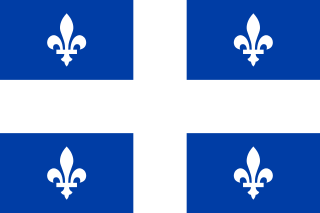
Quebec is one of the thirteen provinces and territories of Canada. It is the largest province by area and the second-largest by population. Much of the population lives in urban areas along the St. Lawrence River, between the most populous city, Montreal, and the provincial capital, Quebec City. Quebec is the home of the Québécois nation. Located in Central Canada, the province shares land borders with Ontario to the west, Newfoundland and Labrador to the northeast, New Brunswick to the southeast, and a coastal border with Nunavut; in the south it borders Maine, New Hampshire, Vermont, and New York in the United States.
A TAME airline Boeing 737–200 crashes near Cuenca, Ecuador, killing all 119 passengers and crew on board.

TAME or TAME EP Linea Aerea del Ecuador was an airline founded in Ecuador in 1962. TAME was the flag carrier and the largest airline of Ecuador. TAME headquarters were in Quito, Pichincha Province and the main hub was Mariscal Sucre International Airport in Quito. The airline was formed by the Air Force of Ecuador. In 2011, it became a commercial entity and provided domestic, international and charter flights. On May 20, 2020, the Ecuador government decided to cease all the operations and liquidate the airline.

The Boeing 737 is a narrow-body aircraft produced by Boeing at its Renton Factory in Washington. Developed to supplement the Boeing 727 on short and thin routes, the twinjet retains the 707 fuselage width and six abreast seating with two underwing turbofans. Envisioned in 1964, the initial 737-100 made its first flight in April 1967 and entered service in February 1968 with Lufthansa. The lengthened 737-200 entered service in April 1968, and evolved through four generations, offering several variants for 85 to 215 passengers.

The 1983 TAME Boeing 737 crash is an remaining deadliest aviation accident in the Ecuador, which a Boeing 737-2V2 Advanced, operated by the Ecuadorian national airline TAME, which was flying on a domestic route from the now-closed Mariscal Sucre International Airport in Quito to Mariscal Lamar Airport in Cuenca, crashed into a hill during final approach just 1 mile from its final destination, killing all 119 people on board.

Santa Ana de los Cuatro Ríos de Cuenca, commonly referred to as Cuenca is the capital and largest city of the Azuay Province of Ecuador. Cuenca is located in the highlands of Ecuador at about 2,560 metres above sea level, with an urban population of approximately 329,928 and 661,685 inhabitants in the larger metropolitan area.
The Italy National Football Team defeats West Germany at Santiago Bernabéu Stadium to capture the 1982 FIFA World Cup.

The Italy national football team has represented Italy in international football since its first match in 1910. The national team is controlled by the Italian Football Federation (FIGC), the governing body for football in Italy, which is a co-founder and member of UEFA. Italy's home matches are played at various stadiums throughout Italy, and its primary training ground and technical headquarters, Centro Tecnico Federale di Coverciano, is located in Florence. Italy are the reigning European champions, having won UEFA Euro 2020.
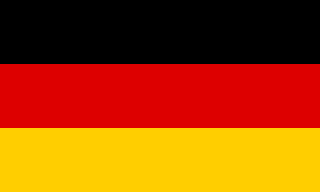
This is a list of international football matches of the Germany national football team during its period as West Germany from 1950 until 1990.

The Santiago Bernabéu Stadium is a football stadium in Madrid, Spain. With a current seating capacity of 81,044, it has been the home stadium of Real Madrid since its completion in 1947. It is the second-largest stadium in Spain and third-largest home to a top-flight European club after Camp Nou and Westfalenstadion.

The 1982 FIFA World Cup Final was a football match contested between Italy and West Germany. It was the final match of the 1982 FIFA World Cup tournament and was played on 11 July 1982 at the Santiago Bernabéu Stadium in the Spanish capital and largest city of Madrid.
America's first space station, Skylab, is destroyed as it re-enters the Earth's atmosphere over the Indian Ocean.

Skylab was the first United States space station, launched by NASA, occupied for about 24 weeks between May 1973 and February 1974. It was operated by three separate three-astronaut crews: Skylab 2, Skylab 3, and Skylab 4. Major operations included an orbital workshop, a solar observatory, Earth observation, and hundreds of experiments.
Los Alfaques disaster: A truck carrying liquid gas crashes and explodes at a coastal campsite in Tarragona, Spain killing 216 tourists.

The Los Alfaques disaster was a road accident and tanker explosion that occurred on Tuesday July 11, 1978 in Alcanar, near Tarragona, in Spain. The tanker truck was loaded with 23 tons of highly flammable liquefied propylene. 217 people were killed and 200 more severely burned.

Tarragona is a port city located in northeast Spain on the Costa Daurada by the Mediterranean Sea. Founded before the fifth century BC, it is the capital of the Province of Tarragona, and part of Tarragonès and Catalonia. Geographically, it is bordered on the north by the Province of Barcelona and the Province of Lleida. The city has a population of 201,199 (2014).
Martin Luther King Jr., assassinated in 1968, is awarded the Presidential Medal of Freedom.

Martin Luther King Jr. was an American Baptist minister and activist, one of the most prominent leaders in the civil rights movement from 1955 until his assassination in 1968. An African American church leader and the son of early civil rights activist and minister Martin Luther King Sr., King advanced civil rights for people of color in the United States through nonviolence and civil disobedience. Inspired by his Christian beliefs and the nonviolent activism of Mahatma Gandhi, he led targeted, nonviolent resistance against Jim Crow laws and other forms of discrimination.

Martin Luther King Jr., an African-American clergyman and civil rights leader, was fatally shot at the Lorraine Motel in Memphis, Tennessee, on April 4, 1968, at 6:01 p.m. CST. He was rushed to St. Joseph's Hospital, where he died at 7:05 p.m. He was a prominent leader of the civil rights movement and a Nobel Peace Prize laureate who was known for his use of nonviolence and civil disobedience.
The Presidential Medal of Freedom is the highest civilian award of the United States, along with the Congressional Gold Medal. It is an award bestowed by the president of the United States to recognize people who have made "an especially meritorious contribution to the security or national interests of the United States, world peace, cultural or other significant public or private endeavors." The award is not limited to U.S. citizens and, while it is a civilian award, it can also be awarded to military personnel and worn on the uniform. It was established in 1963 by President John F. Kennedy, superseding the Medal of Freedom that was established by President Harry S. Truman in 1945 to honor civilian service during World War II.
Varig Flight 820 crashes near Paris, France on approach to Orly Airport, killing 123 of the 134 on board. In response, the FAA bans smoking in airplane lavatories.
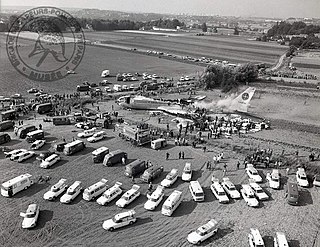
Varig Flight 820 was a flight of the Brazilian airline Varig that departed from Galeão International Airport in Rio de Janeiro, Brazil, on July 11, 1973, for Orly Airport, in Paris, France. The plane, a Boeing 707, registration PP-VJZ, made an emergency landing on onion fields about four kilometers from Orly Airport, due to smoke in the cabin from a fire in a lavatory. The fire caused 123 deaths; there were only 11 survivors.

Paris Orly Airport, commonly referred to as Orly, is one of two international airports serving the French capital, Paris, the other one being Charles de Gaulle Airport (CDG). It is located partially in Orly and partially in Villeneuve-le-Roi, 13 km (8.1 mi) south of Paris, France. It serves as a secondary hub for domestic and overseas territories flights of Air France and as the homebase for Transavia France. Flights operate to destinations in Europe, the Middle East, Africa, the Caribbean and North America.
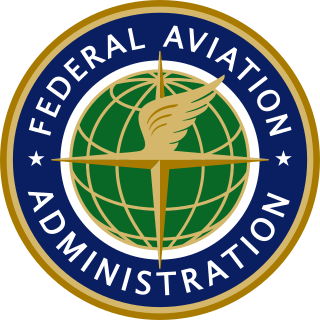
The Federal Aviation Administration (FAA) is the largest transportation agency of the U.S. government and regulates all aspects of civil aviation in the country as well as over surrounding international waters. Its powers include air traffic management, certification of personnel and aircraft, setting standards for airports, and protection of U.S. assets during the launch or re-entry of commercial space vehicles. Powers over neighboring international waters were delegated to the FAA by authority of the International Civil Aviation Organization.
The first game of the World Chess Championship 1972 between challenger Bobby Fischer and defending champion Boris Spassky starts.

The World Chess Championship 1972 was a match for the World Chess Championship between challenger Bobby Fischer of the United States and defending champion Boris Spassky of the Soviet Union. The match took place in the Laugardalshöll arena in Reykjavík, Iceland, and has been dubbed the Match of the Century. Fischer became the first American born in the United States to win the world title, and the second American overall. Fischer's win also ended, for a short time, 24 years of Soviet domination of the World Championship.

Robert James Fischer was an American chess grandmaster and the eleventh World Chess Champion. A chess prodigy, he won his first of a record eight US Championships at the age of 14. In 1964, he won with an 11–0 score, the only perfect score in the history of the tournament. Qualifying for the 1972 World Championship, Fischer swept matches with Mark Taimanov and Bent Larsen by 6–0 scores. After another qualifying match against Tigran Petrosian, Fischer won the title match against Boris Spassky of the USSR, in Reykjavík, Iceland. Publicized as a Cold War confrontation between the US and USSR, the match attracted more worldwide interest than any chess championship before or since.
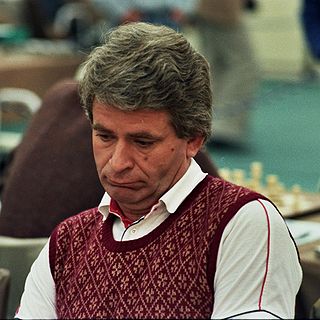
Boris Vasilievich Spassky is a Russian chess grandmaster who was the tenth World Chess Champion, holding the title from 1969 to 1972. Spassky played three world championship matches: he lost to Tigran Petrosian in 1966; defeated Petrosian in 1969 to become world champion; then lost to Bobby Fischer in a famous match in 1972.
Copper mines in Chile are nationalized.

Copper is a chemical element with the symbol Cu and atomic number 29. It is a soft, malleable, and ductile metal with very high thermal and electrical conductivity. A freshly exposed surface of pure copper has a pinkish-orange color. Copper is used as a conductor of heat and electricity, as a building material, and as a constituent of various metal alloys, such as sterling silver used in jewelry, cupronickel used to make marine hardware and coins, and constantan used in strain gauges and thermocouples for temperature measurement.
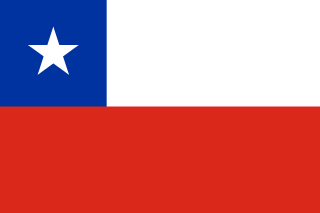
Chile, officially the Republic of Chile, is a country in the western part of South America. It is the southernmost country in the world, and the closest to Antarctica, occupying a long and narrow strip of land between the Andes to the east and the Pacific Ocean to the west. Chile covers an area of 756,096 square kilometers (291,930 sq mi), with a population of 17.5 million as of 2017. It shares land borders with Peru to the north, Bolivia to the north-east, Argentina to the east, and the Drake Passage in the far south. Chile also controls the Pacific islands of Juan Fernández, Isla Salas y Gómez, Desventuradas, and Easter Island in Oceania. It also claims about 1,250,000 square kilometers (480,000 sq mi) of Antarctica under the Chilean Antarctic Territory. The country's capital and largest city is Santiago, and its national language is Spanish.
First transatlantic satellite television transmission.

Satellite television is a service that delivers television programming to viewers by relaying it from a communications satellite orbiting the Earth directly to the viewer's location. The signals are received via an outdoor parabolic antenna commonly referred to as a satellite dish and a low-noise block downconverter.
Project Apollo: At a press conference, NASA announces lunar orbit rendezvous as the means to land astronauts on the Moon, and return them to Earth.

The Apollo program, also known as Project Apollo, was the third United States human spaceflight program carried out by the National Aeronautics and Space Administration (NASA), which succeeded in preparing and landing the first humans on the Moon from 1968 to 1972. It was first conceived in 1960 during President Dwight D. Eisenhower's administration as a three-person spacecraft to follow the one-person Project Mercury, which put the first Americans in space. Apollo was later dedicated to President John F. Kennedy's national goal for the 1960s of "landing a man on the Moon and returning him safely to the Earth" in an address to Congress on May 25, 1961. It was the third US human spaceflight program to fly, preceded by the two-person Project Gemini conceived in 1961 to extend spaceflight capability in support of Apollo.

The National Aeronautics and Space Administration is an independent agency of the US federal government responsible for the civil space program, aeronautics research, and space research.

Lunar orbit rendezvous (LOR) is a process for landing humans on the Moon and returning them to Earth. It was utilized for the Apollo program missions in the 1960s and 1970s. In a LOR mission, a main spacecraft and a smaller lunar lander travel to lunar orbit. The lunar lander then independently descends to the surface of the Moon, while the main spacecraft remains in lunar orbit. After completion of the mission there, the lander returns to lunar orbit to rendezvous and re-dock with the main spacecraft, then is discarded after transfer of crew and payload. Only the main spacecraft returns to Earth.

An astronaut is a person trained, equipped, and deployed by a human spaceflight program to serve as a commander or crew member aboard a spacecraft. Although generally reserved for professional space travelers, the term is sometimes applied to anyone who travels into space, including scientists, politicians, journalists, and tourists.
To Kill a Mockingbird, a novel by Harper Lee featuring themes of racial injustice and the loss of innocence in the Deep South of America, was published.

To Kill a Mockingbird is a novel by the American author Harper Lee. It was published in 1960 and was instantly successful. In the United States, it is widely read in high schools and middle schools. To Kill a Mockingbird has become a classic of modern American literature, winning the Pulitzer Prize. The plot and characters are loosely based on Lee's observations of her family, her neighbors and an event that occurred near her hometown of Monroeville, Alabama, in 1936, when she was ten.

Nelle Harper Lee was an American novelist best known for her 1960 novel To Kill a Mockingbird. It won the 1961 Pulitzer Prize and has become a classic of modern American literature. Lee has received numerous accolades and honorary degrees, including the Presidential Medal of Freedom in 2007 which was awarded for her contribution to literature. She assisted her close friend Truman Capote in his research for the book In Cold Blood (1966). Capote was the basis for the character Dill Harris in To Kill a Mockingbird.
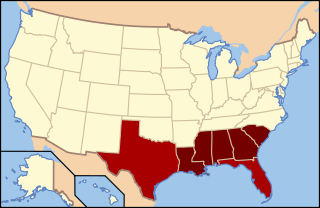
The Deep South or the Lower South is a cultural and geographic subregion in the Southern United States. The term was first used to describe the states most dependent on plantations and slavery prior to the American Civil War. Following the war, the region suffered economic hardship and was a major site of racial tension during and after the Reconstruction era. Before 1945, the Deep South was often referred to as the "Cotton States" since cotton was the primary cash crop for economic production. The Civil rights movement in the 1950s and 1960s helped usher in a new era, sometimes referred to as the New South.
France legislates for the independence of Dahomey (later Benin), Upper Volta (later Burkina Faso) and Niger.
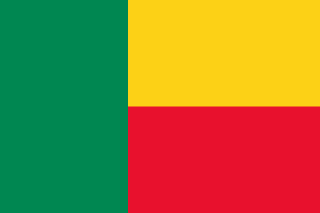
The Republic of Dahomey, simply known as Dahomey, was established on 4 December 1958, as a self-governing colony within the French Community. Prior to attaining autonomy, it had been French Dahomey, part of the French Union. On 1 August 1960, it attained full independence from France.

Benin, officially the Republic of Benin, and formerly Dahomey, is a country in West Africa. It is bordered by Togo to the west, Nigeria to the east, Burkina Faso to the north-west, and Niger to the north-east. The majority of its population lives on the southern coastline of the Bight of Benin, part of the Gulf of Guinea in the northernmost tropical portion of the Atlantic Ocean. The capital is Porto-Novo, and the seat of government is in Cotonou, the most populous city and economic capital. Benin covers an area of 114,763 square kilometres (44,310 sq mi) and its population in 2021 was estimated to be approximately 13 million. It is a tropical nation, dependent on agriculture, and is an exporter of palm oil and cotton. Some employment and income arise from subsistence farming.
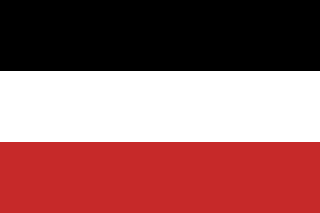
The Republic of Upper Volta was a landlocked West African country established on 11 December 1958 as a self-governing colony within the French Community. Before becoming autonomous, it had been part of the French Union as the French Upper Volta. On 5 August 1960, it gained full independence from France. On 4 August 1984, it changed its name to Burkina Faso.
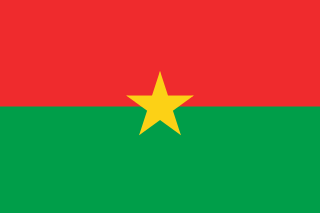
Burkina Faso is a landlocked country in West Africa with an area of 274,200 km2 (105,900 sq mi), bordered by Mali to the northwest, Niger to the northeast, Benin to the southeast, Togo and Ghana to the south, and the Ivory Coast to the southwest. It has a population of 20,321,378. Previously called Republic of Upper Volta (1958–1984), it was renamed Burkina Faso by President Thomas Sankara. Its citizens are known as Burkinabè, and its capital and largest city is Ouagadougou.
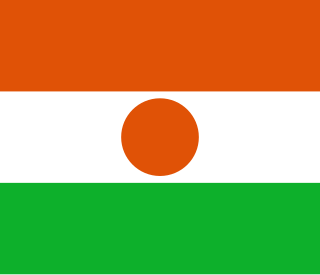
Niger or the Niger, officially the Republic of the Niger, is a landlocked country in West Africa. It is a unitary state bordered by Libya to the northeast, Chad to the east, Nigeria to the south, Benin and Burkina Faso to the southwest, Mali to the west, and Algeria to the northwest. It covers a land area of almost 1,270,000 km2 (490,000 sq mi), making it the second-largest landlocked country in West Africa, after Chad. Over 80% of its land area lies in the Sahara. Its predominantly Muslim population of about 25 million live mostly in clusters in the further south and west of the country. The capital Niamey is located in Niger's southwest corner.
Congo Crisis: The State of Katanga breaks away from the Democratic Republic of the Congo.
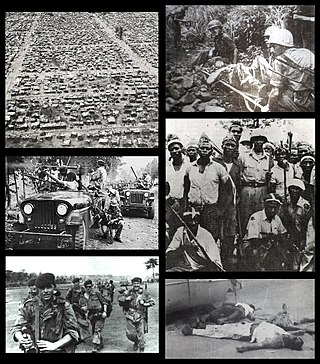
The Congo Crisis was a period of political upheaval and conflict between 1960 and 1965 in the Republic of the Congo. The crisis began almost immediately after the Congo became independent from Belgium and ended, unofficially, with the entire country under the rule of Joseph-Désiré Mobutu. Constituting a series of civil wars, the Congo Crisis was also a proxy conflict in the Cold War, in which the Soviet Union and the United States supported opposing factions. Around 100,000 people are believed to have been killed during the crisis.
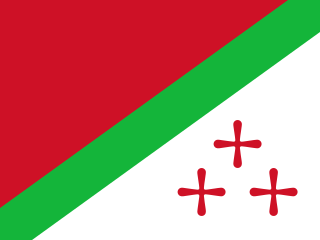
The State of Katanga also sometimes denoted as the Republic of Katanga, was a breakaway state that proclaimed its independence from Congo-Léopoldville on 11 July 1960 under Moise Tshombe, leader of the local Confédération des associations tribales du Katanga (CONAKAT) political party. The new Katangese state did not enjoy full support throughout the province and was constantly plagued by ethnic strife in its northernmost region. It was dissolved in 1963 following an invasion by United Nations Operation in the Congo (ONUC) forces, and reintegrated with the rest of the country as Katanga Province.
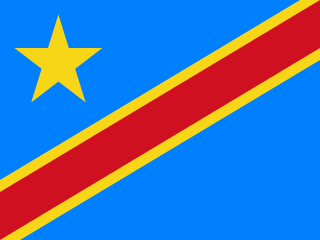
The Democratic Republic of the Congo, informally Congo-Kinshasa, DR Congo, the DRC, the DROC, or the Congo, and formerly and also colloquially Zaire, is a country in Central Africa. It is bordered to the northwest by the Republic of the Congo, to the north by the Central African Republic, to the northeast by South Sudan, to the east by Uganda, Rwanda, and Burundi, and by Tanzania, to the south and southeast by Zambia, to the southwest by Angola, and to the west by the South Atlantic Ocean and the Cabinda exclave of Angola. By area, it is the second-largest country in Africa and the 11th-largest in the world. With a population of around 108 million, the Democratic Republic of the Congo is the most populous officially Francophone country in the world. The national capital and largest city is Kinshasa, which is also the nation's economic center.
To Kill a Mockingbird by Harper Lee is first published, in the United States.

To Kill a Mockingbird is a novel by the American author Harper Lee. It was published in 1960 and was instantly successful. In the United States, it is widely read in high schools and middle schools. To Kill a Mockingbird has become a classic of modern American literature, winning the Pulitzer Prize. The plot and characters are loosely based on Lee's observations of her family, her neighbors and an event that occurred near her hometown of Monroeville, Alabama, in 1936, when she was ten.

Nelle Harper Lee was an American novelist best known for her 1960 novel To Kill a Mockingbird. It won the 1961 Pulitzer Prize and has become a classic of modern American literature. Lee has received numerous accolades and honorary degrees, including the Presidential Medal of Freedom in 2007 which was awarded for her contribution to literature. She assisted her close friend Truman Capote in his research for the book In Cold Blood (1966). Capote was the basis for the character Dill Harris in To Kill a Mockingbird.
Prince Karim Husseini Aga Khan IV inherits the office of Imamat as the 49th Imam of Shia Imami Ismai'li worldwide, after the death of Sir Sultan Mahommed Shah Aga Khan III.

Shāh Karim al-Husayni, known by the religious title Mawlānā Hazar Imam by his Ismaili followers and elsewhere as Aga Khan IV, is the 49th and current Imam of Nizari Ismailis, a denomination within Shia Islam. He has held the position of imam and the title of Aga Khan since 11 July 1957, when, at the age of 20, he succeeded his grandfather, Sir Sultan Muhammad Shah Aga Khan III. The Aga Khan claims direct lineal descent from the Islamic prophet Muhammad through Muhammad's cousin and son-in-law, Ali, considered an imam in Shia Islam, and Ali's wife Fatima, Muhammad's daughter from his first marriage.

Isma'ilism is a branch or sub-sect of Shia Islam. The Isma'ili get their name from their acceptance of Imam Isma'il ibn Jafar as the appointed spiritual successor (imām) to Ja'far al-Sadiq, wherein they differ from the Twelver Shia, who accept Musa al-Kadhim, the younger brother of Isma'il, as the true Imām.

Sir Sultan Mahomed Shah, Aga Khan III was the 48th Imam of the Nizari Ismaili sect of Islam. He was one of the founders and the first permanent president of the All-India Muslim League (AIML). His goal was the advancement of Muslim agendas and protection of Muslim rights in British India. The League, until the late 1930s, was not a large organisation but represented the landed and commercial Muslim interests as well as advocating for British education during the British Raj. There were similarities in the Aga Khan's views on education with those of other Muslim social reformers, but the scholar Shenila Khoja-Moolji argues that he also expressed distinct interest in advancing women's education for women themselves. Aga Khan called on the British Raj to consider Muslims to be a separate nation within India, the famous 'Two Nation Theory'. Even after he resigned as president of the AIML in 1912, he still exerted a major influence on its policies and agendas. He was nominated to represent India to the League of Nations in 1932 and served as President of the League of Nations from 1937 to 1938.
Pakistan joins the International Monetary Fund and the International Bank.

Pakistan, officially the Islamic Republic of Pakistan, is a country in South Asia. It is the world's fifth-most populous country, with a population of almost 243 million people, and has the world's second-largest Muslim population just behind Indonesia. Pakistan is the 33rd-largest country in the world by area and 2nd largest in South Asia, spanning 881,913 square kilometres. It has a 1,046-kilometre (650-mile) coastline along the Arabian Sea and Gulf of Oman in the south, and is bordered by India to the east, Afghanistan to the west, Iran to the southwest, and China to the northeast. It is separated narrowly from Tajikistan by Afghanistan's Wakhan Corridor in the north, and also shares a maritime border with Oman. Islamabad is the nation's capital, while Karachi is its largest city and financial centre.

The International Monetary Fund (IMF) is a major financial agency of the United Nations, and an international financial institution, headquartered in Washington, D.C., consisting of 190 countries. Its stated mission is "working to foster global monetary cooperation, secure financial stability, facilitate international trade, promote high employment and sustainable economic growth, and reduce poverty around the world." Formed in 1944, started on 27 December 1945, at the Bretton Woods Conference primarily by the ideas of Harry Dexter White and John Maynard Keynes, it came into formal existence in 1945 with 29 member countries and the goal of reconstructing the international monetary system. It now plays a central role in the management of balance of payments difficulties and international financial crises. Countries contribute funds to a pool through a quota system from which countries experiencing balance of payments problems can borrow money. As of 2016, the fund had XDR 477 billion. The IMF is regarded as the global lender of last resort.
The Exodus 1947 heads to Palestine from France.

Exodus 1947 was a packet steamship that was built in the United States in 1928 as President Warfield for the Baltimore Steam Packet Company. From her completion in 1928 until 1942 she carried passengers and freight across Chesapeake Bay between Norfolk, Virginia and Baltimore, Maryland.
The bloodiest day of a massive ethnic cleansing operation took place, where units of the Ukrainian Insurgent Army attacked and burned various Polish villages in the Volhynia region of present-day Ukraine.

The massacres of Poles in Volhynia and Eastern Galicia, were carried out in German-occupied Poland by the Ukrainian Insurgent Army, or the UPA, with the support of parts of the local Ukrainian population against the Polish minority in Volhynia, Eastern Galicia, parts of Polesia and Lublin region from 1943 to 1945. The peak of the massacres took place in July and August 1943. Most of the victims were women and children. Many of the Polish victims regardless of age or gender were tortured before being killed; some of the methods included rape, dismemberment or immolation, among others. The UPA's actions resulted in between 50,000 and 100,000 deaths.

The Ukrainian Insurgent Army was a Ukrainian nationalist paramilitary and later partisan formation. During World War II, it was engaged in guerrilla warfare against the Soviet Union, the Polish Underground State, Communist Poland, and Nazi Germany. It was established by the Organization of Ukrainian Nationalists. The insurgent army arose out of separate militant formations of the Organization of Ukrainian Nationalists—Bandera faction, other militant national-patriotic formations, some former defectors of the Ukrainian Auxiliary Police, mobilization of local populations and others. The political leadership of the army belonged to the OUN-B. It was the primary perpetrator of the ethnic cleansing of Poles in Volhynia and Eastern Galicia. Its official date of creation is 14 October 1942, the day of the Intercession of the Theotokos feast. From December 1941 to July 1943, the Ukrainian People's Revolutionary Army shared the same name.

On Sunday July 11, 1943, the OUN-UPA death squads aided by the local Ukrainian peasants simultaneously attacked at least 99 Polish settlements within the Wołyń Voivodeship of the prewar Second Polish Republic under the German occupation. It was a well-orchestrated attack on people gathered for a Sunday mass at Catholic churches. The towns affected included Kisielin, Poryck, Chrynów, Zabłoćce, Krymn, with dozens of other towns attacked at different dates with tens of churches and chapels burned to the ground. The Volhynian massacres spread over four prewar voivodeships including Wołyń with 40,000- 60,000 victims, as well as Lwów, Stanisławów and Tarnopol in Lesser Poland with 30,000- 40,000 Poles murdered for the total of 100,000 Polish victims of UPA terror. The Bloody Sunday of July 11, 1943 is not to be confused with the Stanisławów Ghetto Bloody Sunday massacre of 10,000 to 12,000 Polish Jews on October 12, 1941, before the Stanisławów Ghetto announcement.
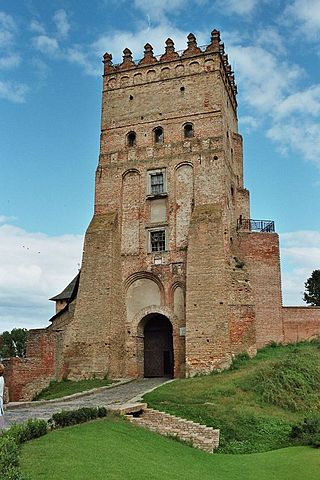
Volhynia, is a historic region in Central and Eastern Europe, between south-eastern Poland, south-western Belarus, and western Ukraine. The borders of the region are not clearly defined, but the territory that still carries the name is Volyn Oblast, in western Ukraine. Volhynia has changed hands numerous times throughout history and been divided among conquering neighbours. For centuries it was, by conquest, part of the Polish-Lithuanian Commonwealth. After the Russian annexation, all of Volhynia was part of the Pale of Settlement designated by Imperial Russia on its south-western-most border.
Massacres of Poles in Volhynia and Eastern Galicia by the Ukrainian Insurgent Army within the Reichskommissariat Ukraine (Volhynia) peak.

The massacres of Poles in Volhynia and Eastern Galicia, were carried out in German-occupied Poland by the Ukrainian Insurgent Army, or the UPA, with the support of parts of the local Ukrainian population against the Polish minority in Volhynia, Eastern Galicia, parts of Polesia and Lublin region from 1943 to 1945. The peak of the massacres took place in July and August 1943. Most of the victims were women and children. Many of the Polish victims regardless of age or gender were tortured before being killed; some of the methods included rape, dismemberment or immolation, among others. The UPA's actions resulted in between 50,000 and 100,000 deaths.

The Ukrainian Insurgent Army was a Ukrainian nationalist paramilitary and later partisan formation. During World War II, it was engaged in guerrilla warfare against the Soviet Union, the Polish Underground State, Communist Poland, and Nazi Germany. It was established by the Organization of Ukrainian Nationalists. The insurgent army arose out of separate militant formations of the Organization of Ukrainian Nationalists—Bandera faction, other militant national-patriotic formations, some former defectors of the Ukrainian Auxiliary Police, mobilization of local populations and others. The political leadership of the army belonged to the OUN-B. It was the primary perpetrator of the ethnic cleansing of Poles in Volhynia and Eastern Galicia. Its official date of creation is 14 October 1942, the day of the Intercession of the Theotokos feast. From December 1941 to July 1943, the Ukrainian People's Revolutionary Army shared the same name.

During World War II, Reichskommissariat Ukraine was the civilian occupation regime of much of Nazi German-occupied Ukraine. It was governed by the Reich Ministry for the Occupied Eastern Territories headed by Alfred Rosenberg. Between September 1941 and August 1944, the Reichskommissariat was administered by Erich Koch as the Reichskommissar. The administration's tasks included the pacification of the region and the exploitation, for German benefit, of its resources and people. Adolf Hitler issued a Führer Decree defining the administration of the newly occupied Eastern territories on 17 July 1941.

Volhynia, is a historic region in Central and Eastern Europe, between south-eastern Poland, south-western Belarus, and western Ukraine. The borders of the region are not clearly defined, but the territory that still carries the name is Volyn Oblast, in western Ukraine. Volhynia has changed hands numerous times throughout history and been divided among conquering neighbours. For centuries it was, by conquest, part of the Polish-Lithuanian Commonwealth. After the Russian annexation, all of Volhynia was part of the Pale of Settlement designated by Imperial Russia on its south-western-most border.
World War II: Allied invasion of Sicily: German and Italian troops launch a counter-attack on Allied forces in Sicily.

The Allied invasion of Sicily, also known as Operation Husky, was a major campaign of World War II in which the Allied forces invaded the island of Sicily in July 1943 and took it from the Axis powers. It began with a large amphibious and airborne operation, followed by a six-week land campaign, and initiated the Italian campaign.

Nazi Germany was the German state between 1933 and 1945, when Adolf Hitler and the Nazi Party controlled the country, transforming it into a dictatorship. Under Hitler's rule, Germany quickly became a totalitarian state where nearly all aspects of life were controlled by the government. The Third Reich, meaning "Third Realm" or "Third Empire", alluded to the Nazi claim that Nazi Germany was the successor to the earlier Holy Roman Empire (800–1806) and German Empire (1871–1918). The Third Reich, which Hitler and the Nazis referred to as the Thousand-Year Reich, ended in May 1945 after just 12 years when the Allies defeated Germany, ending World War II in Europe.
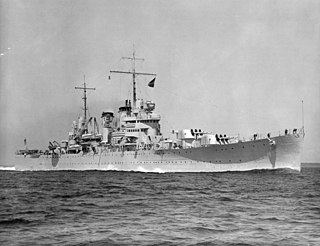
The amphibious Battle of Gela was the opening engagement of the American portion of the Allied Invasion of Sicily during World War II. United States Navy ships landed United States Army troops along the eastern end of the south coast of Sicily; and withstood attacks by Luftwaffe and Regia Aeronautica aircraft while defending the beachhead against German tanks and Italian tanks of the Livorno Division until the Army captured the Ponte Olivo Airfield for use by United States Army Air Forces planes. The battle convinced United States Army officers of the value of naval artillery support, and revealed problems coordinating air support from autonomous air forces during amphibious operations.

The Allies, formally referred to as the United Nations from 1942, were an international military coalition formed during the Second World War (1939–1945) to oppose the Axis powers, led by Nazi Germany, Imperial Japan, and Fascist Italy. Its principal members by 1941 were the United Kingdom, United States, Soviet Union, and China.

Sicily is the largest island in the Mediterranean Sea and one of the 20 regions of Italy. The Strait of Messina divides it from the region of Calabria in Southern Italy. It is one of the five Italian autonomous regions and is officially referred to as Regione Siciliana. The region has 5 million inhabitants. Its capital city is Palermo.
The Northern Rhodesian Labour Party holds its first congress in Nkana.

The Northern Rhodesian Labour Party was a political party in Northern Rhodesia.
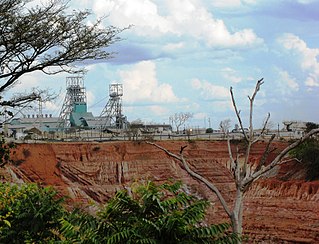
Nkana is a section of the city of Kitwe, Copperbelt Province, Zambia which started off in the early part of the 20th century as a railway station to support the growing complex of copper mining operations. It was named after Chief Nkana, the local traditional ruler. The copper mines of Nkana were originally owned by the Anglo-American Corporation of South Africa. A large smelter was built at the site of the Nkana Mine. The mines in Nkana were among the largest copper mines in the world, employing in excess of 20,000 people. The city of Kitwe grew up as a service town for the Nkana mines but soon swallowed them up, leading to the name Kitwe-Nkana sometimes being used to refer to the city.
World War II: Vichy France regime is formally established. Philippe Pétain becomes Chief of the French State.

World War II or the Second World War, often abbreviated as WWII or WW2, was a world war that lasted from 1939 to 1945. It involved the vast majority of the world's countries—including all of the great powers—forming two opposing military alliances: the Allies and the Axis powers. World War II was a total war that directly involved more than 100 million personnel from more than 30 countries.

Vichy France, officially the French State, was the authoritarian French state headed by Marshal Philippe Pétain during World War II. Officially independent, but with half of its territory occupied under harsh terms of the armistice, it adopted a policy of collaboration with Nazi Germany, which occupied the northern and western portions before occupying the remainder of Metropolitan France in November 1942. Though Paris was ostensibly its capital, the collaborationist Vichy government established itself in the resort town of Vichy in the unoccupied "Free Zone", where it remained responsible for the civil administration of France as well as its colonies.

Henri Philippe Benoni Omer Pétain, commonly known as Philippe Pétain or Marshal Pétain, was a French general who attained the position of Marshal of France at the end of World War I, during which he became known as The Lion of Verdun. From 1940 to 1944, during World War II, he served as head of the collaborationist regime of Vichy France. Pétain, who was 84 years old in 1940, remains the oldest person to become the head of state of France.
New York City's Triborough Bridge (pictured), the "biggest traffic machine ever built", opened to traffic.

The Robert F. Kennedy Bridge is a complex of bridges and elevated expressway viaducts in New York City. The bridges link the boroughs of Manhattan, Queens, and the Bronx. The viaducts cross Randalls and Wards Islands, previously two islands and now joined by landfill.
The Triborough Bridge in New York City is opened to traffic.

The Robert F. Kennedy Bridge is a complex of bridges and elevated expressway viaducts in New York City. The bridges link the boroughs of Manhattan, Queens, and the Bronx. The viaducts cross Randalls and Wards Islands, previously two islands and now joined by landfill.
Engelbert Zaschka of Germany flies his large human-powered aircraft, the Zaschka Human-Power Aircraft, about 20 meters at Berlin Tempelhof Airport without assisted take-off.

Engelbert Zaschka was a German chief engineer, chief designer and inventor. Zaschka is one of the first German helicopter pioneers and he is a pioneer of flying with muscle power and the folding car. Zaschka devoted himself primarily to aviation and automotive topics, but his work was not limited to them.

A human-powered aircraft (HPA) is an aircraft belonging to the class of vehicles known as human-powered transport.

Berlin Tempelhof Airport was one of the first airports in Berlin, Germany. Situated in the south-central Berlin borough of Tempelhof-Schöneberg, the airport ceased operating in 2008 amid controversy, leaving Tegel and Schönefeld as the two main airports serving the city until both were replaced by Berlin Brandenburg Airport in 2020.
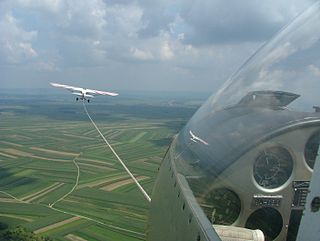
In aviation, assisted takeoff is any system for helping aircraft to get into the air. The reason it might be needed is due to the aircraft's weight exceeding the normal maximum takeoff weight, insufficient power, insufficient available runway length, or a combination of all three factors. Assisted takeoff is also required for gliders, which do not have an engine and are unable to take off by themselves.
Eric Liddell won the gold medal in 400m at the 1924 Paris Olympics, after refusing to run in the heats for 100m, his favoured distance, on a Sunday.
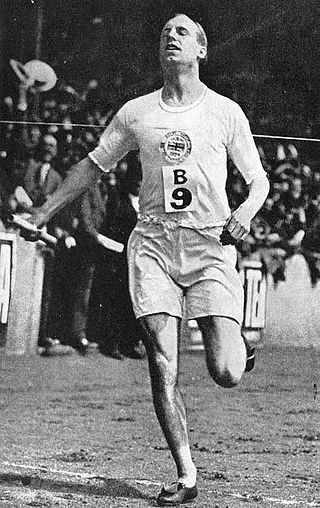
Eric Henry Liddell was a Scottish sprinter, rugby player, and Christian missionary. Born in Qing China to Scottish missionary parents, he attended boarding school near London, spending time when possible with his family in Edinburgh, and afterwards attended the University of Edinburgh.
The Hollywood Bowl opens.

The Hollywood Bowl is an amphitheatre in the Hollywood Hills neighborhood of Los Angeles, California. It was named one of the 10 best live music venues in America by Rolling Stone magazine in 2018.
A truce in the Irish War of Independence comes into effect.

The Irish War of Independence or Anglo-Irish War was a guerrilla war fought in Ireland from 1919 to 1921 between the Irish Republican Army and British forces: the British Army, along with the quasi-military Royal Irish Constabulary (RIC) and its paramilitary forces the Auxiliaries and Ulster Special Constabulary (USC). It was part of the Irish revolutionary period.
The Red Army captures Mongolia from the White Army and establishes the Mongolian People's Republic.

The Workers' and Peasants' Red Army, often shortened to the Red Army, was the army and air force of the Russian Soviet Federative Socialist Republic and, after 1922, the Union of Soviet Socialist Republics. The army was established in January 1918. The Bolsheviks raised an army to oppose the military confederations of their adversaries during the Russian Civil War. Starting in February 1946, the Red Army, along with the Soviet Navy, embodied the main component of the Soviet Armed Forces; taking the official name of "Soviet Army", until its dissolution in 1991.

Mongolia is a landlocked country in East Asia, bordered by Russia to the north and China to the south. It covers an area of 1,564,116 square kilometres, with a population of just 3.3 million, making it the world's most sparsely populated sovereign nation. Mongolia is the world's largest landlocked country that does not border a closed sea, and much of its area is covered by grassy steppe, with mountains to the north and west and the Gobi Desert to the south. Ulaanbaatar, the capital and largest city, is home to roughly half of the country's population.

The White movement also known as the Whites, was a loose confederation of anti-communist forces that fought the communist Bolsheviks, also known as the Reds, in the Russian Civil War (1917–1923) and that to a lesser extent continued operating as militarized associations of insurrectionists both outside and within Russian borders in Siberia until roughly World War II (1939–1945). The movement's military arm was the White Army, also known as the White Guard or White Guardsmen.
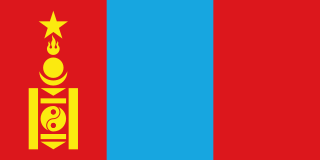
The Mongolian People's Republic was a socialist state which existed from 1924 to 1992, located in the historical region of Outer Mongolia in East Asia. It was ruled by the Mongolian People's Revolutionary Party and maintained close links with the Soviet Union throughout its history.
Former president of the United States William Howard Taft is sworn in as 10th chief justice of the U.S. Supreme Court, becoming the only person ever to hold both offices.

The president of the United States (POTUS) is the head of state and head of government of the United States of America. The president directs the executive branch of the federal government and is the commander-in-chief of the United States Armed Forces.
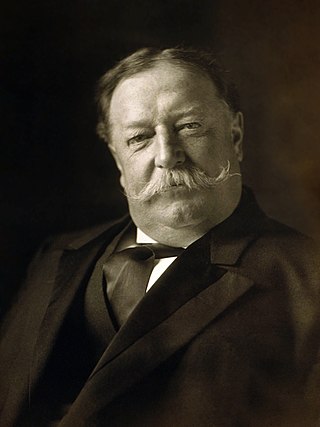
William Howard Taft was the 27th president of the United States (1909–1913) and the tenth chief justice of the United States (1921–1930), the only person to have held both offices. Taft was elected president in 1908, the chosen successor of Theodore Roosevelt, but was defeated for reelection in 1912 by Woodrow Wilson after Roosevelt split the Republican vote by running as a third-party candidate. In 1921, President Warren G. Harding appointed Taft to be chief justice, a position he held until a month before his death.

The chief justice of the United States is the chief judge of the Supreme Court of the United States and the highest-ranking officer of the U.S. federal judiciary. Article II, Section 2, Clause 2 of the U.S. Constitution grants plenary power to the president of the United States to nominate, and with the advice and consent of the United States Senate, appoint "Judges of the supreme Court", who serve until they resign, retire, are impeached and convicted, or die. The existence of a chief justice is explicit in Article One, Section 3, Clause 6 which states that the chief justice shall preside on the impeachment trial of the president.

The Supreme Court of the United States (SCOTUS) is the highest court in the federal judiciary of the United States. It has ultimate appellate jurisdiction over all U.S. federal court cases, and over state court cases that involve a point of federal law. It also has original jurisdiction over a narrow range of cases, specifically "all Cases affecting Ambassadors, other public Ministers and Consuls, and those in which a State shall be Party." The court holds the power of judicial review, the ability to invalidate a statute for violating a provision of the Constitution. It is also able to strike down presidential directives for violating either the Constitution or statutory law. However, it may act only within the context of a case in an area of law over which it has jurisdiction. The court may decide cases having political overtones, but has ruled that it does not have power to decide non-justiciable political questions.
In the East Prussian plebiscite the local populace decides to remain with Weimar Germany.

The East Prussian plebiscite, also known as the Allenstein and Marienwerder plebiscite or Warmia, Masuria and Powiśle plebiscite, was a plebiscite organised in accordance with Articles 94 to 97 of the Treaty of Versailles for the self-determination of the ethnocultural regions of southern Warmia (Ermland), Masuria and Lower Vistula Plains, located in the historical territories of Malbork Land and Upper Prussia, all of which had been parts of the historical Prussia. They were at the time governed as parts of East Prussia or of the West Prussian.

The Weimar Republic, officially named the German Reich, was the government of Germany from 1918 to 1933, during which it was a constitutional federal republic for the first time in history; hence it is also referred to, and unofficially proclaimed itself, as the German Republic. The state's informal name is derived from the city of Weimar, which hosted the constituent assembly that established its government. In English, the state was usually simply called "Germany", with "Weimar Republic" not commonly used until the 1930s.
The eight-hour day and free Sunday become law for workers in the Netherlands.
The eight-hour day movement was a social movement to regulate the length of a working day, preventing excesses and abuses.
Babe Ruth makes his debut in Major League Baseball.

George Herman "Babe" Ruth Jr. was an American professional baseball player whose career in Major League Baseball (MLB) spanned 22 seasons, from 1914 through 1935. Nicknamed "the Bambino" and "the Sultan of Swat", he began his MLB career as a star left-handed pitcher for the Boston Red Sox, but achieved his greatest fame as a slugging outfielder for the New York Yankees. Ruth is regarded as one of the greatest sports heroes in American culture and is considered by many to be the greatest baseball player of all time. In 1936, Ruth was elected into the Baseball Hall of Fame as one of its "first five" inaugural members.

Major League Baseball (MLB) is a professional baseball organization and the oldest major professional sports league in the world. MLB is composed of 30 total teams, divided equally between the National League (NL) and the American League (AL), with 29 in the United States and 1 in Canada. The NL and AL were formed in 1876 and 1901, respectively. Beginning in 1903, the two leagues signed the National Agreement and cooperated but remained legally separate entities until 2000, when they merged into a single organization led by the Commissioner of Baseball. MLB is headquartered in Midtown Manhattan. It is also included as one of the major professional sports leagues in the United States and Canada.
USS Nevada (BB-36) is launched.

USS Nevada (BB-36), the third United States Navy ship to be named after the 36th state, was the lead ship of the two Nevada-class battleships. Launched in 1914, Nevada was a leap forward in dreadnought technology; four of her new features would be included on almost every subsequent US battleship: triple gun turrets, oil in place of coal for fuel, geared steam turbines for greater range, and the "all or nothing" armor principle. These features made Nevada, alongside her sister ship Oklahoma, the first US Navy "standard-type" battleships.
Murder of Grace Brown by Chester Gillette in the United States, inspiration for Theodore Dreiser's An American Tragedy.

Grace Mae Brown was an American woman who was murdered by her boyfriend, Chester Gillette, on Big Moose Lake, New York, after she told him she was pregnant. The events and trial of the suspect attracted national newspaper attention.

Chester Ellsworth Gillette, an American convicted murderer, became the basis for the fictional character Clyde Griffiths in Theodore Dreiser's novel An American Tragedy, which was the basis of the 1931 film An American Tragedy and the 1951 film A Place in the Sun.

Theodore Herman Albert Dreiser was an American novelist and journalist of the naturalist school. His novels often featured main characters who succeeded at their objectives despite a lack of a firm moral code, and literary situations that more closely resemble studies of nature than tales of choice and agency. Dreiser's best known novels include Sister Carrie (1900) and An American Tragedy (1925).

An American Tragedy is a 1925 novel by American writer Theodore Dreiser. He began the manuscript in the summer of 1920, but a year later abandoned most of that text. It was based on the notorious murder of Grace Brown in 1906 and the trial of her lover. In 1923 Dreiser returned to the project, and with the help of his wife Helen and two editor-secretaries, Louise Campbell and Sally Kusell, he completed the massive novel in 1925. The book entered the public domain in the United States on January 1, 2021.
Fiat founded by Giovanni Agnelli in Turin, Italy.

Fiat Automobiles S.p.A. is an Italian automobile manufacturer, formerly part of Fiat Chrysler Automobiles, and since 2021 a subsidiary of Stellantis through its Italian division Stellantis Italy. Fiat Automobiles was formed in January 2007 when Fiat S.p.A. reorganized its automobile business, and traces its history back to 1899 when the first Fiat automobile, the Fiat 4 HP, was produced.
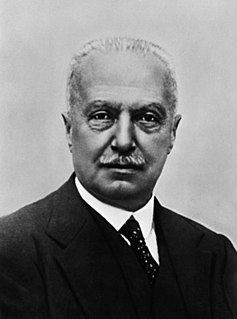
Giovanni Agnelli was an Italian businessman, who founded Fiat car manufacturing in 1899.
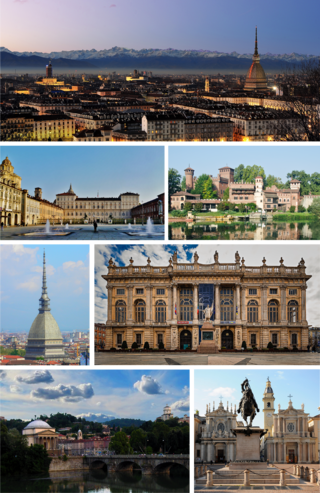
Turin is a city and an important business and cultural centre in Northern Italy. It is the capital city of Piedmont and of the Metropolitan City of Turin, and was the first Italian capital from 1861 to 1865. The city is mainly on the western bank of the Po River, below its Susa Valley, and is surrounded by the western Alpine arch and Superga Hill. The population of the city proper is 847,287 while the population of the urban area is estimated by Eurostat to be 1.7 million inhabitants. The Turin metropolitan area is estimated by the OECD to have a population of 2.2 million.
Salomon August Andrée leaves Spitsbergen to attempt to reach the North Pole by balloon.

Salomon August Andrée, during his lifetime most often known as S. A. Andrée, was a Swedish engineer, physicist, aeronaut and polar explorer who died while leading an attempt to reach the Geographic North Pole by hydrogen balloon. The balloon expedition was unsuccessful in reaching the Pole and resulted in the deaths of all three of its participants.

Spitsbergen is the largest and only permanently populated island of the Svalbard archipelago in northern Norway.

The North Pole, also known as the Geographic North Pole or Terrestrial North Pole, is the point in the Northern Hemisphere where the Earth's axis of rotation meets its surface. It is called the True North Pole to distinguish from the Magnetic North Pole.

A balloon is a flexible bag that can be inflated with a gas, such as helium, hydrogen, nitrous oxide, oxygen, and air. For special tasks, balloons can be filled with smoke, liquid water, granular media, or light sources. Modern day balloons are made from materials such as rubber, latex, polychloroprene, or a nylon fabric, and can come in many different colors. Some early balloons were made of dried animal bladders, such as the pig bladder. Some balloons are used for decorative purposes or entertaining purposes, while others are used for practical purposes such as meteorology, medical treatment, military defense, or transportation. A balloon's properties, including its low density and low cost, have led to a wide range of applications.
The first cultured pearl is obtained by Kōkichi Mikimoto.

A pearl is a hard, glistening object produced within the soft tissue of a living shelled mollusk or another animal, such as fossil conulariids. Just like the shell of a mollusk, a pearl is composed of calcium carbonate in minute crystalline form, which has deposited in concentric layers. The ideal pearl is perfectly round and smooth, but many other shapes, known as baroque pearls, can occur. The finest quality of natural pearls have been highly valued as gemstones and objects of beauty for many centuries. Because of this, pearl has become a metaphor for something rare, fine, admirable and valuable.

Mikimoto Kōkichi was a Japanese entrepreneur who is credited with creating the first cultured pearl and subsequently starting the cultured pearl industry with the establishment of his luxury pearl company Mikimoto.
A revolution led by the liberal general and politician José Santos Zelaya takes over state power in Nicaragua.
In political science, a revolution is a fundamental and relatively sudden change in political power and political organization which occurs when the population revolts against the government, typically due to perceived oppression or political incompetence.

José Santos Zelaya López was the President of Nicaragua from 25 July 1893 to 21 December 1909.

Nicaragua, officially the Republic of Nicaragua, is the largest country in the Central American isthmus, bordered by Honduras to the northwest, the Caribbean to the east, Costa Rica to the south, and the Pacific Ocean to the southwest. Managua is the country's capital and largest city. As of 2015, it was estimated to be the second largest city in Central America. The multi-ethnic population of six million includes people of mestizo, indigenous, European and African heritage. The main language is Spanish. Indigenous tribes on the Mosquito Coast speak their own languages and English.
Tijuana, Mexico, is founded.

Tijuana, commonly known by its initials T.J., is a city and municipal seat of Tijuana Municipality, Baja California, located on the Pacific Coast of Mexico. It is part of the San Diego-Tijuana metro area and the larger Southern California megapolitan area.
The British Mediterranean Fleet begins the Bombardment of Alexandria in Egypt as part of the Anglo-Egyptian War.

The British Mediterranean Fleet, also known as the Mediterranean Station, was a formation of the Royal Navy. The Fleet was one of the most prestigious commands in the navy for the majority of its history, defending the vital sea link between the United Kingdom and the majority of the British Empire in the Eastern Hemisphere. The first Commander-in-Chief for the Mediterranean Fleet was the appointment of General at Sea Robert Blake in September 1654. The Fleet was in existence until 1967.

The Bombardment of Alexandria in Egypt by the British Mediterranean Fleet took place on 11–13 July 1882.

The British conquest of Egypt (1882), also known as Anglo-Egyptian War, occurred in 1882 between Egyptian and Sudanese forces under Ahmed ‘Urabi and the United Kingdom. It ended a nationalist uprising against the Khedive Tewfik Pasha. It established firm British influence over Egypt at the expense of the Egyptians, the French, and the Ottoman Empire, whose already weak authority became nominal.
American Civil War: Confederate forces under Jubal Early began an unsuccessful attempt to capture Washington, D.C..

The American Civil War was a civil war in the United States. It was fought between the Union and the Confederacy, the latter formed by states that had seceded. The central cause of the war was the dispute over whether slavery would be permitted to expand into the western territories, leading to more slave states, or be prevented from doing so, which was widely believed would place slavery on a course of ultimate extinction.

The Confederate States Army, also called the Confederate Army or the Southern Army, was the military land force of the Confederate States of America during the American Civil War (1861–1865), fighting against the United States forces in order to win the independence of the Southern states and uphold the institution of slavery. On February 28, 1861, the Provisional Confederate Congress established a provisional volunteer army and gave control over military operations and authority for mustering state forces and volunteers to the newly chosen Confederate president, Jefferson Davis. Davis was a graduate of the U.S. Military Academy, and colonel of a volunteer regiment during the Mexican–American War. He had also been a United States senator from Mississippi and U.S. Secretary of War under President Franklin Pierce. On March 1, 1861, on behalf of the Confederate government, Davis assumed control of the military situation at Charleston, South Carolina, where South Carolina state militia besieged Fort Sumter in Charleston harbor, held by a small U.S. Army garrison. By March 1861, the Provisional Confederate Congress expanded the provisional forces and established a more permanent Confederate States Army.

Jubal Anderson Early was a Virginia lawyer and politician who became a Confederate general during the American Civil War. Trained at the United States Military Academy, Early resigned his U.S. Army commission after the Second Seminole War and his Virginia military commission after the Mexican–American War, in both cases to practice law and participate in politics. Accepting a Virginia and later Confederate military commission as the American Civil War began, Early fought in the Eastern Theater throughout the conflict. He commanded a division under Generals Stonewall Jackson and Richard Ewell, and later commanded a corps. A key Confederate defender of the Shenandoah Valley, during the Valley Campaigns of 1864, Early made daring raids to the outskirts of Washington, D.C., and as far as York, Pennsylvania, but was crushed by Union forces under General Philip Sheridan, losing over half his forces and leading to the destruction of much of the South's food supply. After the war, Early fled to Mexico, then Cuba and Canada, and upon returning to the United States took pride as an "unrepentant rebel." Particularly after the death of Gen. Robert E. Lee in 1870, Early delivered speeches establishing the Lost Cause position. Early helped found the Southern Historical Society and memorial associations.

The Battle of Fort Stevens was an American Civil War battle fought July 11–12, 1864, in what is now Northwest Washington, D.C., as part of the Valley Campaigns of 1864 between forces under Confederate Lieutenant General Jubal Early and Union Major General Alexander McDowell McCook.
American Civil War: Battle of Fort Stevens; Confederate forces attempt to invade Washington, D.C.

The American Civil War was a civil war in the United States. It was fought between the Union and the Confederacy, the latter formed by states that had seceded. The central cause of the war was the dispute over whether slavery would be permitted to expand into the western territories, leading to more slave states, or be prevented from doing so, which was widely believed would place slavery on a course of ultimate extinction.

The Battle of Fort Stevens was an American Civil War battle fought July 11–12, 1864, in what is now Northwest Washington, D.C., as part of the Valley Campaigns of 1864 between forces under Confederate Lieutenant General Jubal Early and Union Major General Alexander McDowell McCook.

The Confederate States of America (CSA), commonly referred to as the Confederate States, the Confederacy, or "the South", was an unrecognized breakaway republic in North America that existed from February 8, 1861, to May 9, 1865. The Confederacy comprised U.S. states that declared secession and warred against the United States during the American Civil War. Eleven U.S. states, nicknamed Dixie, declared secession and formed the main part of the CSA. They were South Carolina, Mississippi, Florida, Alabama, Georgia, Louisiana, Texas, Virginia, Arkansas, Tennessee, and North Carolina. Kentucky, and Missouri also had declarations of secession and full representation in the Confederate Congress during their Union army occupation.
London Waterloo station, Britain's busiest railway station by passenger usage, was opened by the London and South Western Railway.

Waterloo station, also known as London Waterloo, is a central London terminus on the National Rail network in the United Kingdom, in the Waterloo area of the London Borough of Lambeth. It is connected to a London Underground station of the same name and is adjacent to Waterloo East station on the South Eastern Main Line. The station is the terminus of the South West Main Line to Weymouth via Southampton, the West of England main line to Exeter via Salisbury, the Portsmouth Direct line to Portsmouth Harbour which connects with ferry services to the Isle of Wight, and several commuter services around west and south-west London, Surrey, Hampshire and Berkshire.

This is a list of the busiest railway stations in Great Britain on the National Rail network. The figures are collected by the Office of Rail and Road, and are estimates based on ticket usage data use of an Origin Destination Matrix, a comprehensive matrix of rail flows between stations throughout Great Britain in the financial year of 2020–21. The data count entries and exits at any station. Note that the data covers mainland Great Britain and surrounding small islands, not the United Kingdom, and so exclude tickets within Northern Ireland and Eurostar. There are various further limits to the data due to the variety of ticketing options available on rail services within the UK; these are outlined in full in the report on the data.
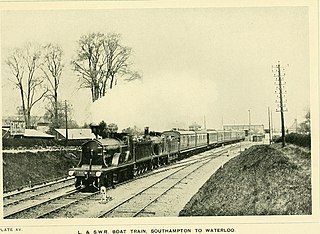
The London and South Western Railway was a railway company in England from 1838 to 1922. Originating as the London and Southampton Railway, its network extended to Dorchester and Weymouth, to Salisbury, Exeter and Plymouth, and to Padstow, Ilfracombe and Bude. It developed a network of routes in Hampshire, Surrey and Berkshire, including Portsmouth and Reading.
Waterloo railway station in London opens.

Waterloo station, also known as London Waterloo, is a central London terminus on the National Rail network in the United Kingdom, in the Waterloo area of the London Borough of Lambeth. It is connected to a London Underground station of the same name and is adjacent to Waterloo East station on the South Eastern Main Line. The station is the terminus of the South West Main Line to Weymouth via Southampton, the West of England main line to Exeter via Salisbury, the Portsmouth Direct line to Portsmouth Harbour which connects with ferry services to the Isle of Wight, and several commuter services around west and south-west London, Surrey, Hampshire and Berkshire.
The Fly-fisher's Entomology is published by Alfred Ronalds. The book transformed the sport and went to many editions.

The Fly-Fisher's Entomology, Illustrated by Coloured Representations of the Natural and Artificial Insect and Accompanied by a Few Observations and Instructions Relative to Trout-and-Grayling Fishing, first published in 1836 by Alfred Ronalds (1802–1860), was the first comprehensive work related to the entomology associated with fly fishing. Although the work was Ronalds' only book, it was published in 11 editions between 1836 and 1913 and has been extensively reprinted in the last 100 years.
Alfred Ronalds was an English author, artisan and Australian pioneer, best known for his book The Fly-fisher's Entomology.
Yagan, a Noongar warrior wanted for leading attacks on British colonists in Western Australia, was killed, becoming a symbol of the unjust and sometimes brutal treatment of indigenous Australians by colonial settlers.

Yagan was an Aboriginal Australian warrior from the Noongar people. Yagan was pursued by the local authorities after he killed Erin Entwhistle, a servant of farmer Archibald Butler. It was an act of retaliation after Thomas Smedley, another of Butler's servants, shot at a group of Noongar people stealing potatoes and fowls, killing one of them. The government offered a bounty for Yagan's capture, dead or alive, and a young settler, William Keats, shot and killed him. He is considered a legendary figure by the Noongar.

The Noongar are Aboriginal Australian peoples who live in the south-west corner of Western Australia, from Geraldton on the west coast to Esperance on the south coast. There are 14 different Noongar groups: Amangu, Ballardong, Yued, Kaneang, Koreng, Mineng, Njakinjaki, Njunga, Pibelmen, Pindjarup, Wadandi, Whadjuk, Wiilman and Wudjari. The Noongar people refer to their land as Noongar boodja.

Western Australia is a state of Australia occupying the western 33 percent of the land area of Australia excluding external territories. It is bounded by the Indian Ocean to the north and west, the Southern Ocean to the south, the Northern Territory to the north-east, and South Australia to the south-east. Western Australia is Australia's largest state, with a total land area of 2,527,013 square kilometres (975,685 sq mi). It is the second-largest country subdivision in the world, surpassed only by Russia's Sakha Republic. As of 2021, the state has 2.76 million inhabitants – 11 percent of the national total. The vast majority live in the south-west corner; 79 percent of the population lives in the Perth area, leaving the remainder of the state sparsely populated.
Indigenous Australians or Australian First Nations are people with familial heritage from, and membership in, the ethnic groups that lived in Australia before British colonisation. They consist of two distinct groups: the Aboriginal peoples of the Australian mainland and Tasmania, and the Torres Strait Islander peoples from the seas between Queensland and Papua New Guinea. The term Aboriginal and Torres Strait Islander peoples or the person's specific cultural group, is often preferred, though the terms First Nations of Australia, First Peoples of Australia and First Australians are also increasingly common; 812,728 people self-identified as being of Aboriginal and/or Torres Strait Islander origin in the 2021 Australian Census, representing 3.2% of the total population of Australia. Of these indigenous Australians, 91.4% identified as Aboriginal; 4.2% identified as Torres Strait Islander; while 4.4% identified with both groups. Since 1995, the Australian Aboriginal flag and the Torres Strait Islander flag have been among the official flags of Australia.
Noongar Australian aboriginal warrior Yagan, wanted for the murder of white colonists in Western Australia, is killed.

The Noongar are Aboriginal Australian peoples who live in the south-west corner of Western Australia, from Geraldton on the west coast to Esperance on the south coast. There are 14 different Noongar groups: Amangu, Ballardong, Yued, Kaneang, Koreng, Mineng, Njakinjaki, Njunga, Pibelmen, Pindjarup, Wadandi, Whadjuk, Wiilman and Wudjari. The Noongar people refer to their land as Noongar boodja.
Indigenous Australians or Australian First Nations are people with familial heritage from, and membership in, the ethnic groups that lived in Australia before British colonisation. They consist of two distinct groups: the Aboriginal peoples of the Australian mainland and Tasmania, and the Torres Strait Islander peoples from the seas between Queensland and Papua New Guinea. The term Aboriginal and Torres Strait Islander peoples or the person's specific cultural group, is often preferred, though the terms First Nations of Australia, First Peoples of Australia and First Australians are also increasingly common; 812,728 people self-identified as being of Aboriginal and/or Torres Strait Islander origin in the 2021 Australian Census, representing 3.2% of the total population of Australia. Of these indigenous Australians, 91.4% identified as Aboriginal; 4.2% identified as Torres Strait Islander; while 4.4% identified with both groups. Since 1995, the Australian Aboriginal flag and the Torres Strait Islander flag have been among the official flags of Australia.

Yagan was an Aboriginal Australian warrior from the Noongar people. Yagan was pursued by the local authorities after he killed Erin Entwhistle, a servant of farmer Archibald Butler. It was an act of retaliation after Thomas Smedley, another of Butler's servants, shot at a group of Noongar people stealing potatoes and fowls, killing one of them. The government offered a bounty for Yagan's capture, dead or alive, and a young settler, William Keats, shot and killed him. He is considered a legendary figure by the Noongar.
A duel occurs in which the Vice President of the United States Aaron Burr mortally wounds former Secretary of the Treasury Alexander Hamilton.

The Burr–Hamilton duel took place in Weehawken, New Jersey, between Aaron Burr, the Vice President of the United States, and Alexander Hamilton, the first and former Secretary of the Treasury, on the morning of July 11, 1804. The duel was the culmination of a bitter rivalry that had developed between both men, who had become high-profile politicians in post-colonial America. In the duel, Burr fatally shot Hamilton, while Hamilton fired into a tree branch above and behind Burr's head. Hamilton was taken back across the Hudson River, and he died the following day in New York.

The vice president of the United States (VPOTUS) is the second-highest officer in the executive branch of the U.S. federal government, after the president of the United States, and ranks first in the presidential line of succession. The vice president is also an officer in the legislative branch, as the president of the Senate. In this capacity, the vice president is empowered to preside over Senate deliberations at any time, but may not vote except to cast a tie-breaking vote. The vice president is indirectly elected together with the president to a four-year term of office by the people of the United States through the Electoral College.

Aaron Burr Jr. was an American politician and lawyer who served as the third vice president of the United States from 1801 to 1805. Burr's legacy is defined by his famous personal conflict with Alexander Hamilton that culminated in Burr killing Hamilton in a duel in 1804, while Burr was vice president.

The United States secretary of the treasury is the head of the United States Department of the Treasury, and is the chief financial officer of the federal government of the United States. The secretary of the treasury serves as the principal advisor to the president of the United States on all matters pertaining to economic and fiscal policy. The secretary is a statutory member of the Cabinet of the United States, and is fifth in the presidential line of succession.

Alexander Hamilton was an American military officer, statesman, and Founding Father who served as the first United States secretary of the treasury from 1789 to 1795.
French astronomer Jean-Louis Pons co-discovered the first of his 37 comets, more than any other person in history.
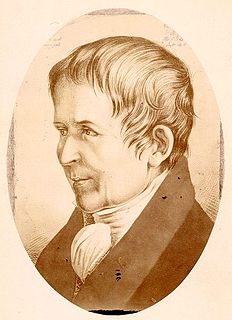
Jean-Louis Pons was a French astronomer. Despite humble beginnings and being self-taught, he went on to become the greatest visual comet discoverer of all time: between 1801 and 1827 Pons discovered thirty-seven comets, more than any other person in history.
French astronomer Jean-Louis Pons makes his first comet discovery. In the next 27 years he discovers another 36 comets, more than any other person in history.

Jean-Louis Pons was a French astronomer. Despite humble beginnings and being self-taught, he went on to become the greatest visual comet discoverer of all time: between 1801 and 1827 Pons discovered thirty-seven comets, more than any other person in history.

A comet is an icy, small Solar System body that, when passing close to the Sun, warms and begins to release gases, a process that is called outgassing. This produces a visible atmosphere or coma, and sometimes also a tail. These phenomena are due to the effects of solar radiation and the solar wind acting upon the nucleus of the comet. Comet nuclei range from a few hundred meters to tens of kilometers across and are composed of loose collections of ice, dust, and small rocky particles. The coma may be up to 15 times Earth's diameter, while the tail may stretch beyond one astronomical unit. If sufficiently bright, a comet may be seen from Earth without the aid of a telescope and may subtend an arc of 30° across the sky. Comets have been observed and recorded since ancient times by many cultures and religions.
The United States Marine Corps is re-established; they had been disbanded after the American Revolutionary War.

The United States Marine Corps (USMC), also referred to as the United States Marines, is the maritime land force service branch of the United States Armed Forces responsible for conducting expeditionary and amphibious operations through combined arms, implementing its own infantry, artillery, aerial, and special operations forces. The U.S. Marine Corps is one of the eight uniformed services of the United States.

The American Revolutionary War, also known as the Revolutionary War or American War of Independence, secured American independence from Great Britain. Fighting began on April 19, 1775, followed by the Lee Resolution on July 2, 1776, and the Declaration of Independence on July 4, 1776. The American Patriots were supported by the Kingdom of France and, to a lesser extent, the Dutch Republic and the Spanish Empire, in a conflict taking place in North America, the Caribbean, and the Atlantic Ocean.
The United States takes possession of Detroit from Great Britain under terms of the Jay Treaty.

Detroit is the largest city in the U.S. state of Michigan. It is also the largest U.S. city on the United States–Canada border, and the seat of government of Wayne County. The City of Detroit had a population of 639,111 at the 2020 census, making it the 27th-most populous city in the United States. The metropolitan area, known as Metro Detroit, is home to 4.3 million people, making it the second-largest in the Midwest after the Chicago metropolitan area, and the 14th-largest in the United States. Regarded as a major cultural center, Detroit is known for its contributions to music, art, architecture and design, in addition to its historical automotive background. Time named Detroit as one of the fifty World's Greatest Places of 2022 to explore.

The Kingdom of Great Britain was a sovereign country in Western Europe from 1 May 1707 to the end of 31 December 1800. The state was created by the 1706 Treaty of Union and ratified by the Acts of Union 1707, which united the kingdoms of England and Scotland to form a single kingdom encompassing the whole island of Great Britain and its outlying islands, with the exception of the Isle of Man and the Channel Islands. The unitary state was governed by a single parliament at the Palace of Westminster, but distinct legal systems – English law and Scots law – remained in use.

The Treaty of Amity, Commerce, and Navigation, Between His Britannic Majesty and the United States of America, commonly known as the Jay Treaty, and also as Jay's Treaty, was a 1794 treaty between the United States and Great Britain that averted war, resolved issues remaining since the Treaty of Paris of 1783, and facilitated ten years of peaceful trade between the United States and Britain in the midst of the French Revolutionary Wars, which began in 1792. The Treaty was designed by Alexander Hamilton and supported by President George Washington. It angered France and bitterly divided Americans. It inflamed the new growth of two opposing parties in every state, the pro-Treaty Federalists and the anti-Treaty Jeffersonian Republicans.
French Revolution: Jacques Necker was dismissed as Director-General of Finances of France, sparking public demonstrations in Paris that led to the storming of the Bastille.

The French Revolution was a period of radical political and societal change in France that began with the Estates General of 1789 and ended with the formation of the French Consulate in November 1799. Many of its ideas are considered fundamental principles of liberal democracy, while phrases like liberté, égalité, fraternité reappeared in other revolts, such as the 1917 Russian Revolution, and inspired campaigns for the abolition of slavery and universal suffrage. The values and institutions it created dominate French politics to this day.

Jacques Necker was a Genevan banker and statesman who served as finance minister for Louis XVI. He was a reformer, but his innovations sometimes caused great discontent. Necker was a constitutional monarchist, a political economist, and a moralist, who wrote a severe critique of the new principle of equality before the law.
This is a list of Ministers of Finance of France, including the equivalent positions of Superintendent of Finances and Controller-General of Finances during the Ancien Régime. The position of Superintendent of Finances was abolished following the arrest of Nicolas Fouquet; his powers were transferred to First Minister Jean-Baptiste Colbert, who would become ex officio Controller-General of Finances four years later after the elevation of the office.

The Storming of the Bastille occurred in Paris, France, on 14 July 1789, when revolutionary insurgents stormed and seized control of the medieval armoury, fortress, and political prison known as the Bastille. At the time, the Bastille represented royal authority in the centre of Paris. The prison contained only seven inmates at the time of its storming, but was seen by the revolutionaries as a symbol of the monarchy's abuse of power; its fall was the flashpoint of the French Revolution.
Jacques Necker is dismissed as France's Finance Minister sparking the Storming of the Bastille.

Jacques Necker was a Genevan banker and statesman who served as finance minister for Louis XVI. He was a reformer, but his innovations sometimes caused great discontent. Necker was a constitutional monarchist, a political economist, and a moralist, who wrote a severe critique of the new principle of equality before the law.

The Storming of the Bastille occurred in Paris, France, on 14 July 1789, when revolutionary insurgents stormed and seized control of the medieval armoury, fortress, and political prison known as the Bastille. At the time, the Bastille represented royal authority in the centre of Paris. The prison contained only seven inmates at the time of its storming, but was seen by the revolutionaries as a symbol of the monarchy's abuse of power; its fall was the flashpoint of the French Revolution.
Mathematical calculations suggest that it is on this day that dwarf planet Pluto moved inside the orbit of Neptune for the last time before 1979.

A dwarf planet is a small planetary-mass object that is in direct orbit of the Sun, smaller than any of the eight classical planets but still a world in its own right. The prototypical dwarf planet is Pluto. The interest of dwarf planets to planetary geologists is that, since they are possibly differentiated and geologically active bodies, they may display planetary geology, an expectation that was borne out by the Dawn mission to Ceres and the New Horizons mission to Pluto, both in 2015.

Pluto is a dwarf planet in the Kuiper belt, a ring of bodies beyond the orbit of Neptune. It is the ninth-largest and tenth-most-massive known object to directly orbit the Sun. It is the largest known trans-Neptunian object by volume, by a small margin, but is slightly less massive than Eris. Like other Kuiper belt objects, Pluto is made primarily of ice and rock and is much smaller than the inner planets. Compared to Earth's moon, Pluto has only one sixth its mass and one third its volume.

Neptune is the eighth planet from the Sun and the farthest known planet in the Solar System. It is the fourth-largest planet in the Solar System by diameter, the third-most-massive planet, and the densest giant planet. It is 17 times the mass of Earth, and slightly more massive than its near-twin Uranus. Neptune is denser and physically smaller than Uranus because its greater mass causes more gravitational compression of its atmosphere. It is referred to as one of the solar system's two ice giant planets. Being composed primarily of gases and liquids, it has no well-defined "solid surface". The planet orbits the Sun once every 164.8 years at an average distance of 30.1 AU. It is named after the Roman god of the sea and has the astronomical symbol , representing Neptune's trident.
Samuel de Champlain returns to Quebec.

Samuel de Champlain was a French colonist, navigator, cartographer, draftsman, soldier, explorer, geographer, ethnologist, diplomat, and chronicler. He made between 21 and 29 trips across the Atlantic Ocean, and founded Quebec, and New France, on 3 July 1608. An important figure in Canadian history, Champlain created the first accurate coastal map during his explorations, and founded various colonial settlements.

Quebec is one of the thirteen provinces and territories of Canada. It is the largest province by area and the second-largest by population. Much of the population lives in urban areas along the St. Lawrence River, between the most populous city, Montreal, and the provincial capital, Quebec City. Quebec is the home of the Québécois nation. Located in Central Canada, the province shares land borders with Ontario to the west, Newfoundland and Labrador to the northeast, New Brunswick to the southeast, and a coastal border with Nunavut; in the south it borders Maine, New Hampshire, Vermont, and New York in the United States.
While exploring the North Atlantic Ocean in an attempt to find the Northwest Passage, Martin Frobisher sights Greenland, mistaking it for the hypothesized (but non-existent) island of "Frisland".

The Atlantic Ocean is the second-largest of the world's five oceans, with an area of about 106,460,000 km2 (41,100,000 sq mi). It covers approximately 20% of Earth's surface and about 29% of its water surface area. It is known to separate the "Old World" of Africa, Europe and Asia from the "New World" of the Americas in the European perception of the World.

The Northwest Passage (NWP) is the sea route between the Atlantic and Pacific oceans through the Arctic Ocean, along the northern coast of North America via waterways through the Canadian Arctic Archipelago. The eastern route along the Arctic coasts of Norway and Siberia is accordingly called the Northeast Passage (NEP). The various islands of the archipelago are separated from one another and from Mainland Canada by a series of Arctic waterways collectively known as the Northwest Passages, Northwestern Passages or the Canadian Internal Waters.

Sir Martin Frobisher was an English seaman and privateer who made three voyages to the New World looking for the North-west Passage. He probably sighted Resolution Island near Labrador in north-eastern Canada, before entering Frobisher Bay and landing on present-day Baffin Island. On his second voyage, Frobisher found what he thought was gold ore and carried 200 tons of it home on three ships, where initial assaying determined it to be worth a profit of £5.20 per ton. Encouraged, Frobisher returned to Canada with an even larger fleet and dug several mines around Frobisher Bay. He carried 1,350 tons of the ore back to England, where, after years of smelting, it was realized that the ore was a worthless rock containing the mineral hornblende. As an English privateer, he plundered riches from French ships. He was later knighted for his service in repelling the Spanish Armada in 1588.

Greenland is an island country in North America that is part of the Kingdom of Denmark. It is located between the Arctic and Atlantic oceans, east of the Canadian Arctic Archipelago. Greenland is the world's largest island. It is one of three constituent countries that form the Kingdom of Denmark, along with Denmark and the Faroe Islands; the citizens of these countries are all citizens of Denmark and the European Union. Greenland's capital is Nuuk.
Giuliano della Rovere is appointed bishop of Coutances.

Pope Julius II was head of the Catholic Church and ruler of the Papal States from 1503 to his death in February 1513. Nicknamed the Warrior Pope or the Fearsome Pope, he chose his papal name not in honour of Pope Julius I but in emulation of Julius Caesar. One of the most powerful and influential popes, Julius II was a central figure of the High Renaissance and left a significant cultural and political legacy. As a result of his policies during the Italian Wars, the Papal States remained independent and centralized, and the office of the papacy continued to be crucial, diplomatically and politically, during the entirety of the 16th century in Italy and Europe.

Coutances is a commune in the Manche department in Normandy in north-western France.
Ottoman Interregnum: Süleyman Çelebi defeats his brother Musa Çelebi outside the Ottoman capital, Edirne.

The Ottoman Interregnum, or the Ottoman Civil War, was a civil war in the Ottoman Empire between the sons of Sultan Bayezid I following the defeat of their father at the Battle of Ankara on 20 July 1402. Although Mehmed Çelebi was confirmed as sultan by Timur, his brothers İsa Çelebi, Musa Çelebi, Süleyman Çelebi, and later, Mustafa Çelebi, refused to recognize his authority, each claiming the throne for himself. Civil war was the result. The Interregnum lasted a little under 11 years, until the Battle of Çamurlu on 5 July 1413, when Mehmed Çelebi emerged as victor, crowned himself Sultan Mehmed I, and restored the empire.

Süleyman Çelebi was an Ottoman prince and a co-ruler of the Ottoman Empire for several years during the Ottoman Interregnum. There is a tradition of western origin, according to which Suleiman the Magnificent was "Suleiman II", but that tradition has been based on an erroneous assumption that Süleyman Çelebi was to be recognised as a legitimate sultan.
The Battle of Edirne occurred on 11 July 1410, during the Ottoman Interregnum, and was fought between the forces of the rival brothers, Musa Çelebi and Süleyman Çelebi, outside the Ottoman capital, Edirne.

Musa Çelebi was an Ottoman prince and a co-ruler of the empire for three years during the Ottoman Interregnum.

Edirne, formerly known as Adrianople or Hadrianopolis, is a city in Turkey, in the northwestern part of the province of Edirne in Eastern Thrace. Situated 7 km (4.3 mi) from the Greek and 20 km (12 mi) from the Bulgarian borders, Edirne was the second capital city of the Ottoman Empire from 1369 to 1453, before Constantinople became its capital.
Marking the start of Ming China's treasure voyages, Admiral Zheng He's expeditionary fleet set sail towards foreign regions on the South China Sea and Indian Ocean.
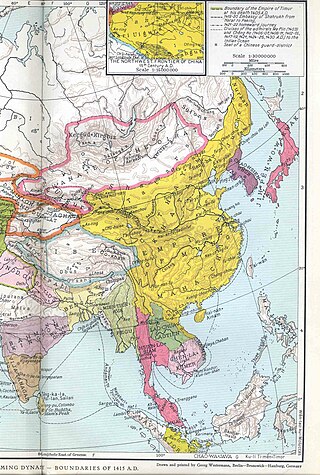
The Ming dynasty, officially the Great Ming, was an imperial dynasty of China, ruling from 1368 to 1644 following the collapse of the Mongol-led Yuan dynasty. The Ming dynasty was the last orthodox dynasty of China ruled by the Han people, the majority ethnic group in China. Although the primary capital of Beijing fell in 1644 to a rebellion led by Li Zicheng, numerous rump regimes ruled by remnants of the Ming imperial family—collectively called the Southern Ming—survived until 1662.

The Ming treasure voyages were the seven maritime expeditions undertaken by Ming China's treasure fleet between 1405 and 1433. The Yongle Emperor ordered the construction of the treasure fleet in 1403. The grand project resulted in far-reaching ocean voyages to the coastal territories and islands in and around the South China Sea, the Indian Ocean, and beyond. Admiral Zheng He was commissioned to command the treasure fleet for the expeditions. Six of the voyages occurred during the Yongle reign, while the seventh voyage occurred during the Xuande reign. The first three voyages reached up to Calicut on India's Malabar Coast, while the fourth voyage went as far as Hormuz in the Persian Gulf. In the last three voyages, the fleet traveled up to the Arabian Peninsula and East Africa.

Zheng He was a Chinese mariner, explorer, diplomat, fleet admiral, and court eunuch during China's early Ming dynasty. He was originally born as Ma He in a Muslim family and later adopted the surname Zheng conferred by the Yongle Emperor. Commissioned by the Yongle Emperor and later the Xuande Emperor, Zheng commanded seven expeditionary treasure voyages to Southeast Asia, South Asia, West Asia, and East Africa from 1405 to 1433. According to legend, his larger ships carried hundreds of sailors on four decks and were almost twice as long as any wooden ship ever recorded.
Ming admiral Zheng He sets sail to explore the world for the first time.

The Ming dynasty, officially the Great Ming, was an imperial dynasty of China, ruling from 1368 to 1644 following the collapse of the Mongol-led Yuan dynasty. The Ming dynasty was the last orthodox dynasty of China ruled by the Han people, the majority ethnic group in China. Although the primary capital of Beijing fell in 1644 to a rebellion led by Li Zicheng, numerous rump regimes ruled by remnants of the Ming imperial family—collectively called the Southern Ming—survived until 1662.

Zheng He was a Chinese mariner, explorer, diplomat, fleet admiral, and court eunuch during China's early Ming dynasty. He was originally born as Ma He in a Muslim family and later adopted the surname Zheng conferred by the Yongle Emperor. Commissioned by the Yongle Emperor and later the Xuande Emperor, Zheng commanded seven expeditionary treasure voyages to Southeast Asia, South Asia, West Asia, and East Africa from 1405 to 1433. According to legend, his larger ships carried hundreds of sailors on four decks and were almost twice as long as any wooden ship ever recorded.

The Ming treasure voyages were the seven maritime expeditions undertaken by Ming China's treasure fleet between 1405 and 1433. The Yongle Emperor ordered the construction of the treasure fleet in 1403. The grand project resulted in far-reaching ocean voyages to the coastal territories and islands in and around the South China Sea, the Indian Ocean, and beyond. Admiral Zheng He was commissioned to command the treasure fleet for the expeditions. Six of the voyages occurred during the Yongle reign, while the seventh voyage occurred during the Xuande reign. The first three voyages reached up to Calicut on India's Malabar Coast, while the fourth voyage went as far as Hormuz in the Persian Gulf. In the last three voyages, the fleet traveled up to the Arabian Peninsula and East Africa.
Charles IV, Count of Luxembourg and King of Bohemia, is elected King of the Romans.

Charles IV, also known as Charles of Luxembourg, born Wenceslaus, was the first King of Bohemia to become Holy Roman Emperor. He was a member of the House of Luxembourg from his father's side and the Bohemian House of Přemyslid from his mother's side; he emphasized the latter due to his lifelong affinity for the Bohemian side of his inheritance, and also because his direct ancestors in the Přemyslid line included two saints.
The territory of Luxembourg has been ruled successively by counts, dukes and grand dukes. It was part of the medieval Kingdom of Germany, and later the Holy Roman Empire until it became a sovereign state in 1815.

The Duchy of Bohemia was established in 870 and raised to the Kingdom of Bohemia in 1198. Several Bohemian monarchs ruled as non-hereditary kings beforehand, first gaining the title in 1085. From 1004 to 1806, Bohemia was part of the Holy Roman Empire, and its ruler was an elector. During 1526–1804 the Kingdom of Bohemia, together with the other lands of the Bohemian Crown, was ruled under a personal union as part of the Habsburg monarchy. From 1804 to 1918, Bohemia was part of the Austrian Empire, which itself was part of the dual monarchy of Austria-Hungary from 1867 to 1918. Following the dissolution of the monarchy, the Bohemian lands, now also referred to as Czech lands, became part of Czechoslovakia, and they have formed today's Czech Republic since 1993.

King of the Romans was the title used by the king of Germany following his election by the princes from the reign of Henry II (1002–1024) onward.
Flemish infantry defeated a large French army near Kortrijk at the Battle of the Golden Spurs.
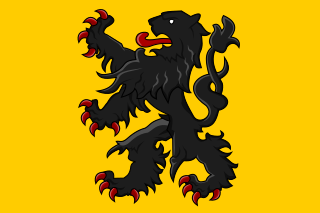
The County of Flanders was a historic territory in the Low Countries.

Kortrijk, sometimes known in English as Courtrai or Courtray, is a Belgian city and municipality in the Flemish province of West Flanders.
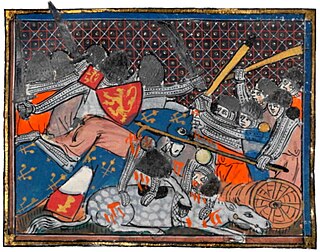
The Battle of the Golden Spurs was a military confrontation between the royal army of France and rebellious forces of the County of Flanders on 11 July 1302 during the Franco-Flemish War (1297–1305). It took place near the town of Kortrijk (Courtrai) in modern-day Belgium and resulted in an unexpected victory for the Flemish. It is sometimes referred to as the Battle of Courtrai.
Battle of the Golden Spurs (Guldensporenslag in Dutch): A coalition around the Flemish cities defeats the king of France's royal army.

The Battle of the Golden Spurs was a military confrontation between the royal army of France and rebellious forces of the County of Flanders on 11 July 1302 during the Franco-Flemish War (1297–1305). It took place near the town of Kortrijk (Courtrai) in modern-day Belgium and resulted in an unexpected victory for the Flemish. It is sometimes referred to as the Battle of Courtrai.

Flanders is the Flemish-speaking northern portion of Belgium and one of the communities, regions and language areas of Belgium. However, there are several overlapping definitions, including ones related to culture, language, politics, and history, and sometimes involving neighbouring countries. The demonym associated with Flanders is Fleming, while the corresponding adjective is Flemish. The official capital of Flanders is the City of Brussels, although the Brussels-Capital Region has an independent regional government. The powers of the government of Flanders consist, among others, of economic affairs in the Flemish Region and the community aspects of Flanders life in Brussels, such as Flemish culture and education.
Baldwin IV, 13, becomes King of Jerusalem, with Raymond III, Count of Tripoli as regent and William of Tyre as chancellor.

Baldwin IV, called the Leper, was King of Jerusalem from 1174 until his death in 1185. He was admired by his contemporaries and later historians for his willpower and dedication to the Latin kingdom in the face of debilitating leprosy, which eventually left him blind and unable to use either his hands or his feet. Choosing competent advisers, Baldwin ruled a thriving realm and succeeded in protecting it from the great Ayyubid Muslim ruler Saladin.

The King of Jerusalem was the supreme ruler of the Kingdom of Jerusalem, a Crusader state founded in Jerusalem by the Latin Catholic leaders of the First Crusade, when the city was conquered in 1099.
Raymond III was count of Tripoli from 1152 to 1187. He was a minor when Assassins murdered his father, Raymond II of Tripoli. Baldwin III of Jerusalem, who was staying in Tripoli, made Raymond's mother, Hodierna of Jerusalem, regent. Raymond spent the following years at the royal court in Jerusalem. He participated in a series of military campaigns against Nur ad-Din, the Zengid ruler of Damascus, after he reached the age of majority in 1155. Raymond hired pirates in 1161 to pillage the Byzantine coastline and islands to take vengeance on Byzantine Emperor Manuel I Komnenos, who had refused to marry his sister Melisende. Captured in the Battle of Harim by Nur ad-Din's troops on 10 August 1164, he was imprisoned in Aleppo for almost ten years. During his captivity, Amalric I of Jerusalem administered the county of Tripoli on his behalf.

William of Tyre was a medieval prelate and chronicler. As archbishop of Tyre, he is sometimes known as William II to distinguish him from his predecessor, William I, the Englishman, a former Prior of the Church of the Holy Sepulchre, who was Archbishop of Tyre from 1127 to 1135. He grew up in Jerusalem at the height of the Kingdom of Jerusalem, which had been established in 1099 after the First Crusade, and he spent twenty years studying the liberal arts and canon law in the universities of Europe.
Signing of the Treaty of Saint-Clair-sur-Epte between Charles the Simple and Rollo of Normandy.
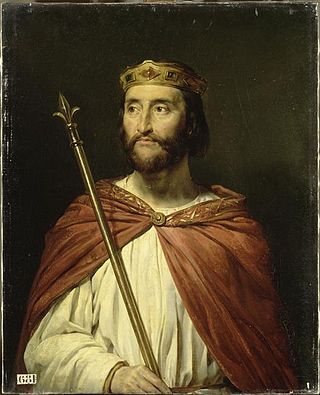
911 (CMXI) was a common year starting on Tuesday of the Julian calendar.

The treaty of Saint-Clair-sur-Epte (911) is the foundational document of the Duchy of Normandy, establishing Rollo, a Norse warlord and Viking leader, as the first Duke of Normandy in exchange for his loyalty to the king of West Francia, following the Siege of Chartres. The territory of Normandy centered on Rouen, a city in the Marches of Neustria which had been repeatedly raided by Vikings since the 840s, and which had finally been taken by Rollo in 876.
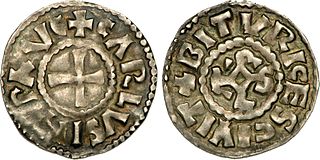
Charles III, called the Simple or the Straightforward, was King of West Francia from 898 until 922 and the king of Lotharingia from 911 until 919–923. He was a member of the Carolingian dynasty.

Rollo was a Viking who became the first ruler of Normandy, today a region in northern France. He emerged as the outstanding warrior among the Norsemen who had secured a permanent foothold on Frankish soil in the valley of the lower Seine. After the Siege of Chartres in 911, Charles the Simple, the king of West Francia, granted them lands between the mouth of the Seine and what is now Rouen in exchange for Rollo agreeing to end his brigandage, swearing allegiance to him, religious conversion and a pledge to defend the Seine's estuary from Viking raiders.
Byzantine emperor Michael I, under threat by conspiracies, abdicates in favor of his general Leo the Armenian, and becomes a monk (under the name Athanasius).

Michael I Rhangabe was Byzantine emperor from 811 to 813.

Leo V the Armenian was the Byzantine emperor from 813 to 820. A senior general, he forced his predecessor, Michael I Rangabe, to abdicate and assumed the throne. He ended the decade-long war with the Bulgars, and initiated the second period of Byzantine Iconoclasm. He was assassinated by supporters of Michael the Amorian, one of his most trusted generals, who succeeded him on the throne.

A monk is a person who practices religious asceticism by monastic living, either alone or with any number of other monks. A monk may be a person who decides to dedicate their life to serving other people and serving God, or to be an ascetic who voluntarily chooses to leave mainstream society and live their life in prayer and contemplation. The concept is ancient and can be seen in many religions and in philosophy.
After being besieged in Rome by his own generals, Western Roman Emperor Anthemius is captured in St. Peter's Basilica and put to death.

Procopius Anthemius was western Roman emperor from 467 to 472.

Old St. Peter's Basilica was the building that stood, from the 4th to 16th centuries, where the new St. Peter's Basilica stands today in Vatican City. Construction of the basilica, built over the historical site of the Circus of Nero, began during the reign of Emperor Constantine I. The name "old St. Peter's Basilica" has been used since the construction of the current basilica to distinguish the two buildings.
Charlie Robinson, American actor (b. 1945) deaths

Charles P. Robinson was an American stage, film and television actor. He is best known for his role on the NBC sitcom Night Court as Macintosh "Mac" Robinson, the clerk of the court and a Vietnam War veteran. Although his most frequent on-screen billing was Charlie Robinson, Night Court had credited him as Charles Robinson throughout his 1984–1992 stint as Mac. In two of his earliest film appearances, 1974's Sugar Hill and 1975's The Black Gestapo, he was credited as Charles P. Robinson. Some of his credits have been occasionally commingled with ones of older actor Charles Knox Robinson who, billed as Charles Robinson, was featured in numerous films and TV episodes between 1958 and 1971.
Renée Simonot, French actress (b. 1911) deaths
Jeanne Renée Deneuve, known professionally as Renée-Jeanne Simonot, was a French actress and voice artist. She was married to actor Maurice Dorléac, the mother of actresses Catherine Deneuve and Françoise Dorléac and the grandmother of actor Christian Vadim and actress Chiara Mastroianni.
Frank Bolling, American baseball second baseman (b. 1931) deaths

Francis Elmore Bolling was an American baseball second baseman who played twelve seasons in Major League Baseball (MLB). He played for the Detroit Tigers and Milwaukee/Atlanta Braves from 1954 until 1966. He batted and threw right-handed, and was the younger brother of shortstop Milt Bolling.
Jim Wong-Chu, Canadian poet (b.1949) deaths
Jim Wong-Chu was a Canadian activist, community organizer, poet, author, editor, and historian. Wong-Chu is one of Canada's most celebrated literary pioneers. He was a community organizer known for his work in establishing organizations that contributed to highlighting Asian arts and culture in Canada. He also co-edited several anthologies featuring Asian Canadian writers.
Giacomo Biffi, Italian cardinal (b. 1928) deaths

Giacomo Biffi was an Italian Cardinal of the Roman Catholic Church. He was Archbishop Emeritus of Bologna, having served as archbishop there from 1984 to 2003. he was elevated to the cardinalate in 1985.
Satoru Iwata, Japanese game programmer and businessman (b. 1959) deaths
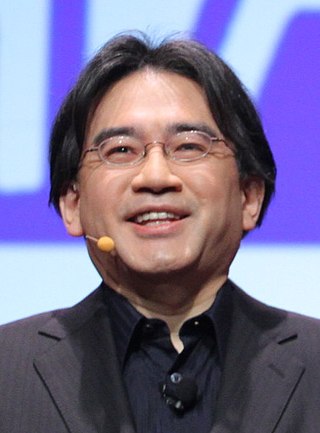
Satoru Iwata was a Japanese businessman, video game programmer, video game designer, and producer. He was the fourth president and chief executive officer (CEO) of Nintendo from 2002 until his death in 2015. He was a major contributor in broadening the appeal of video games by focusing on novel and entertaining games rather than top-of-the-line hardware.
André Leysen, Belgian businessman (b. 1927) deaths
André Leysen was a Belgian businessman. In 1951, he married Anne Ahlers, daughter of a shipping family from Bremen, Germany. Together they have four children: Bettina, Christian, Thomas, and Sabina.
Charlie Haden, American bassist and composer (b. 1937) deaths

Charles Edward Haden was an American jazz double bass player, bandleader, composer and educator whose career spanned more than 50 years. In the late 1950s, he was an original member of the ground-breaking Ornette Coleman Quartet.
Carin Mannheimer, Swedish author and screenwriter (b. 1934) deaths

Carin Mannheimer was a Swedish dramatist, screenwriter, author and film director, born in Osby, Sweden. She garnered acclaim with Rapport om kvinnor, which was published in 1969. The book is a collection of interviews with Swedish women from the working class. This was during a time period of awakening feminism in Sweden when women were assumed to want to work outside the home. The interviews, however, revealed that many women did not want to work outside the home, would have preferred to care for their children but had no economic choice. For this reason, Mannheimer was criticized by the women's movement in Sweden, and the book established her reputation as a social critic.
Bill McGill, American basketball player (b. 1939) deaths
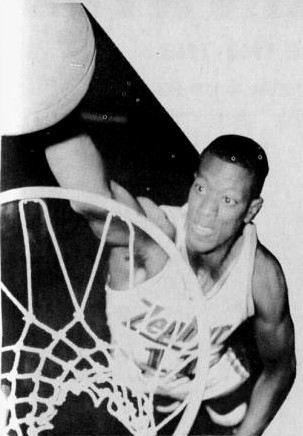
Bill "The Hill" McGill was an American basketball player best known for inventing the jump hook. McGill was the No. 1 overall pick of the 1962 NBA draft out of the University of Utah, with whom he led the NCAA in scoring with 38.8 points per game in the 1961–1962 season.
Tommy Ramone, Hungarian-American drummer and producer (b. 1949) deaths

Thomas Erdelyi, known professionally as Tommy Ramone, was a Hungarian American record producer and musician. He was the drummer for the influential punk rock band the Ramones for the first four years of the band's existence and was the longest-surviving original member of the Ramones.
John Seigenthaler, American journalist and academic (b. 1927) deaths

John Lawrence Seigenthaler was an American journalist, writer, and political figure. He was known as a prominent defender of First Amendment rights.
Randall Stout, American architect, designed the Taubman Museum of Art (b. 1958) deaths

Randall Paul Stout was a Los Angeles, California based architect.

The Taubman Museum of Art, formerly the Art Museum of Western Virginia, is an art museum in downtown Roanoke, Virginia, United States. It was designed by architect Randall Stout.
Emik Avakian, Iranian-American inventor (b. 1923) deaths

Emik Avakian was an Armenian American inventor and owner of numerous patents including breath-operated computer, a mechanism that facilitates putting wheelchairs on automobiles, and a self operating robotic wheel that converts manual wheel chairs into automatic. Many of his inventions were geared towards the improvement of disabled people's lives, and he won many awards recognizing these efforts.
Egbert Brieskorn, German mathematician and academic (b. 1936) deaths

Egbert Valentin Brieskorn was a German mathematician who introduced Brieskorn spheres and the Brieskorn–Grothendieck resolution.
Eugene P. Wilkinson, American admiral (b. 1918) deaths
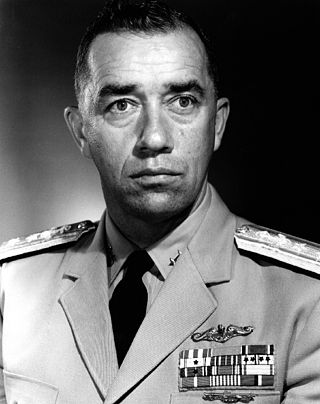
Eugene Parks "Dennis" Wilkinson was a United States Navy officer. He was selected for three historic command assignments. The first, in 1954, was as the first commanding officer of USS Nautilus, the world's first nuclear-powered submarine. The second was as the first commanding officer of USS Long Beach, America's first nuclear surface ship. The third was in 1980 when he was chosen as the first President and CEO of the Institute of Nuclear Power Operations (INPO) from which he retired in 1984.
Reg Fleming, Canadian-American ice hockey player (b. 1936) deaths

Reginald Stephen "Reggie, The Ruffian" Fleming was a professional hockey player in the National Hockey League with the Montreal Canadiens, Chicago Black Hawks, Boston Bruins, New York Rangers, Philadelphia Flyers and Buffalo Sabres. He also played for the Chicago Cougars of the World Hockey Association, as well as with a number of minor league teams in other professional leagues. His professional career spanned over 20 years. He was known as an aggressive and combative player who could play both forward and defence, as well as kill penalties.
Arturo Gatti, Italian-Canadian boxer (b. 1972) deaths

Arturo Gatti was an Italian-Canadian professional boxer who competed from 1991 to 2007. A world champion in two weight classes, Gatti held the IBF junior lightweight title from 1995 to 1998, and the WBC super lightweight title from 2004 to 2005. He also participated in The Ring magazine's Fight of the Year a total of four times. He announced his retirement on July 14, 2007. After his death in 2009, Gatti was inducted into the International Boxing Hall of Fame on December 10, 2012, in his first year of eligibility, becoming the tenth Canadian boxer to be so inducted.
Ji Xianlin, Chinese linguist and paleographer (b. 1911) deaths

Ji Xianlin was a Chinese Indologist, linguist, paleographer, historian and writer who has been honored by the governments of both India and China. Ji was proficient in many languages including Chinese, Sanskrit, Arabic, English, German, French, Russian, Pali and Tocharian, and translated many works. He published a memoir, The Cowshed: Memories of the Chinese Cultural Revolution, about his persecution during the Cultural Revolution.
Michael E. DeBakey, American surgeon and educator (b. 1908) deaths

Michael Ellis DeBakey was a Lebanese-American general and cardiovascular surgeon, scientist and medical educator who became Chairman of the Department of Surgery, President, and Chancellor of Baylor College of Medicine at the Texas Medical Center in Houston, Texas. His career spanned nearly eight decades.
Glenda Adams, Australian author and academic (b. 1939) deaths

Glenda Emilie Adams was an Australian novelist and short story writer, probably best known as the winner of the 1987 Miles Franklin Award for Dancing on Coral. She was a teacher of creative writing, and helped develop writing programs.
Lady Bird Johnson, American beautification activist; 43rd First Lady of the United States (b. 1912) deaths
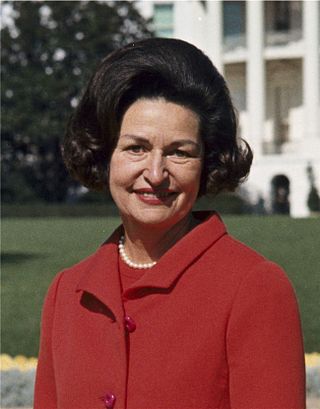
Claudia Alta "Lady Bird" Johnson was First Lady of the United States from 1963 to 1969 as the wife of President Lyndon B. Johnson. She previously served as Second Lady from 1961 to 1963 when her husband was vice president.

The first lady of the United States (FLOTUS) is the title held by the hostess of the White House, usually the wife of the president of the United States, concurrent with the president's term in office. Although the first lady's role has never been codified or officially defined, she figures prominently in the political and social life of the United States. Since the early 20th century, the first lady has been assisted by official staff, now known as the Office of the First Lady and headquartered in the East Wing of the White House.
Alfonso López Michelsen, Colombian lawyer and politician, 32nd President of Colombia (b. 1913) deaths
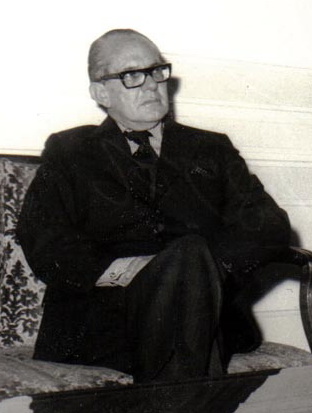
Alfonso López Michelsen was a Colombian politician and lawyer who served as the 24th President of Colombia from 1974 to 1978. He was nicknamed "El Pollo", a popular Colombian idiom for people with precocious careers.
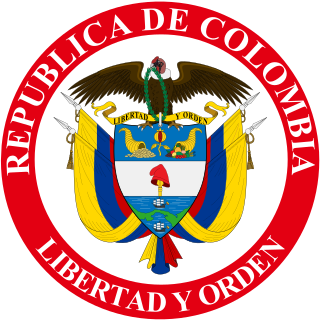
The president of Colombia, officially known as the president of the Republic of Colombia or president of the nation is the head of state and head of government of Colombia. The office of president was established upon the ratification of the Constitution of 1819, by the Congress of Angostura, convened in December 1819, when Colombia was the "Gran Colombia". The first president, General Simón Bolívar, took office in 1819. His position, initially self-proclaimed, was subsequently ratified by Congress.
Ed Mirvish, American-Canadian businessman and philanthropist, founded Honest Ed's (b. 1914) deaths
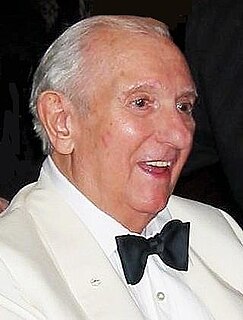
Edwin "Honest Ed" Mirvish, was an American-Canadian businessman, philanthropist and theatrical impresario who lived in Toronto, Ontario. He is known for his flagship business, Honest Ed's, a landmark discount store in downtown Toronto, and as a patron of the arts, instrumental in revitalizing the theatre scene in Toronto.

Honest Ed's was a landmark discount store in Toronto, Ontario, Canada. It was named for its proprietor, Ed Mirvish, who opened the store in 1948 and oversaw its operations for almost 60 years until his death in 2007. The store continued to operate until it permanently closed on December 31, 2016.
Barnard Hughes, American actor (b. 1915) deaths

Bernard Aloysius Kiernan Hughes, known professionally as Barnard Hughes, was an American actor of television, theater and film. Hughes became famous for a variety of roles; his most notable roles came after middle age, and he was often cast as a dithering authority figure or grandfatherly elder.
Bronwyn Oliver, Australian sculptor (b. 1959) deaths

Bronwyn Joy Oliver was an Australian sculptor whose work primarily consisted of metalwork. Oliver was raised in rural New South Wales. She trained at Sydney's Alexander Mackie College of Advanced Education and London's Chelsea School of Art. She had early success, winning a New South Wales Travelling Art Scholarship in 1981 and the Moet & Chandon Australian Art Fellowship in 1984. Oliver settled in Sydney, where she practised and taught until her death in 2006.
John Spencer, English snooker player and sportscaster (b. 1935) deaths

John Spencer was an English professional snooker player who won the World Snooker Championship title at his first attempt in 1969, the year that the event reverted to a knockout tournament. He won the world title for the second time in 1971, and was the first player to win the championship at the Crucible Theatre when it moved there in 1977. Spencer was the inaugural winner of both the Masters and the Irish Masters tournaments, and was the first player to make a maximum 147 break in competition, although this is not recognised as an official maximum because the pockets on the table did not meet the required specifications.
Gretchen Franklin, English actress and dancer (b. 1911) deaths

Gretchen Franklin was an English actress and dancer with a career in show business spanning over 70 years. She was born in Covent Garden, Central London. She played Ethel Skinner in the long-running BBC 1 soap opera EastEnders on a regular basis from 1985 until 1988. After this she returned to the show intermittently. These appearances became briefer and more widely spaced. Her final appearance was in 2000, when her character was killed off.
Jesús Iglesias, Argentinian racing driver (b. 1922) deaths

Jesús Ricardo Iglesias, was a racing driver from Argentina. He initially competed with some success in long distance races in Argentina with a Chevrolet Special, before being invited to drive one of the works Gordini Type 16s in the 1955 Argentine Grand Prix. He qualified 17th out of 22 competitors, but had to retire on lap 38 due to transmission failure, although he also seemed to be on the brink of exhaustion because of the boiling heat.
Frances Langford, American actress and singer (b. 1913) deaths

Julia Frances Newbern-Langford was an American singer and actress who was popular during the Golden Age of Radio and made film and television appearances for over two decades.
Laurance Rockefeller, American financier and philanthropist (b. 1910) deaths

Laurance Spelman Rockefeller was an American businessman, financier, philanthropist, and conservationist. Rockefeller was the third son and fourth child of John D. Rockefeller Jr. and Abby Aldrich Rockefeller. As a trustee of the Rockefeller Brothers Fund, he provided venture capital for Intel, Apple Computer and many other successful start-ups. Rockefeller was known for his involvement in wilderness preservation, ecology and the protection of wildlife. His crusade was the establishing of a conservation ethic, and he was declared America's leading conservationist by Lady Bird Johnson.
Renée Saint-Cyr, French actress and producer (b. 1904) deaths

Renée Saint-Cyr was a French actress. She appeared in more than 60 films between 1933 and 1994. She was the mother of Georges Lautner, who also achieved fame in the film business, albeit as a director.
Zahra Kazemi, Iranian-Canadian freelance photographer (b. 1948) deaths

Zahra "Ziba" Kazemi-Ahmadabadi was an Iranian-Canadian freelance photojournalist. She gained notoriety for her arrest in Iran and the circumstances in which she was held by Iranian authorities, in whose custody she was killed. Kazemi's autopsy report revealed that she had been raped and tortured by Iranian officials while she was at Evin Prison, located within the capital city of Tehran.
Amad Diallo, Ivorian footballer births

Amad Diallo is an Ivorian professional footballer who plays as a winger for EFL Championship club Sunderland, on loan from Premier League club Manchester United, and the Ivory Coast national team.
Herman Brood, Dutch musician and painter (b. 1946) deaths

Hermanus "Herman" Brood was a Dutch musician, painter, actor and poet. As a musician he achieved artistic and commercial success in the 1970s and 1980s, and was called "the greatest and only Dutch rock 'n' roll star". Later in life he started a successful career as a painter.
Pedro Mir, Dominican lawyer, author, and poet (b. 1913) deaths
Pedro Julio Mir Valentín was Dominican poet and writer, named Poet Laureate of the Dominican Republic by Congress in 1984, and a member of the generation of "Independent poets of the 1940s" in Dominican poetry.
Robert Runcie, English archbishop (b. 1921) deaths

Robert Alexander Kennedy Runcie, Baron Runcie, was an English Anglican bishop. He was the Archbishop of Canterbury from 1980 to 1991, having previously been Bishop of St Albans. He travelled the world widely to spread ecumenicism and worked to foster relations with both Protestant and Catholic churches across Europe. He was a leader of the Liberal Anglo-Catholicism movement. He came under attack for expressing compassion towards bereaved Argentines after the Falklands War of 1982, and generated controversy by supporting women's ordination.
Helen Forrest, American singer (b. 1917) deaths

Helen Forrest was an American singer of traditional pop and swing music. She served as the "girl singer" for three of the most popular big bands of the Swing Era, thereby earning a reputation as "the voice of the name bands."
Jan Sloot, Dutch computer scientist and electronics technician (b. 1945) deaths
The Sloot Digital Coding System was a data sharing technique that its inventor claimed could store a complete digital movie file in 8 kilobytes of data — violating Shannon's source coding theorem by many orders of magnitude. The alleged technique was developed in 1995 by Romke Jan Bernhard Sloot, a Dutch electronics engineer. In 1999, just days before the conclusion of a contract to sell his invention, Sloot died suddenly of a heart attack. The source code was never recovered, and the technique and claim have never been reproduced or verified.
Panagiotis Kondylis, Greek philosopher and author (b. 1943) deaths

Panagiotis Kondylis was a Greek philosopher, intellectual historian, translator and publications manager who principally wrote in German, in addition to translating most of his work into Greek. He can be placed in a tradition of thought best exemplified by Thucydides, Niccolò Machiavelli and Max Weber.
Alessia Cara, Canadian singer-songwriter births
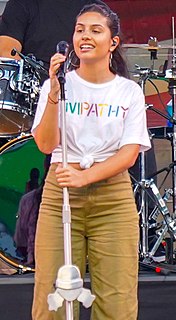
Alessia Caracciolo, known professionally as Alessia Cara, is a Canadian singer-songwriter. Born in Mississauga, Ontario, to Italian Canadian parents, she began posting covers of songs on YouTube at age 13. After uploading acoustic covers of songs such as "Love Yourself" and "Sweater Weather" online, she signed with EP Entertainment and Def Jam Recordings in 2014 and released her debut single, "Here", the following year. It peaked at number 19 on the Canadian Hot 100 chart and was a sleeper hit in the US, peaking at number 5 on the Billboard Hot 100 chart.
Joey Bosa, American football player births
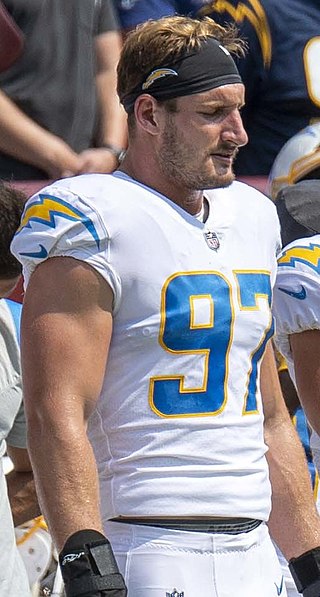
Joseph Anthony Bosa is an American football outside linebacker for the Los Angeles Chargers of the National Football League (NFL). He played college football at Ohio State and was selected third overall by the Chargers in the 2016 NFL Draft, where he was named NFL Defensive Rookie of the Year. Bosa has since been cited as among the best pass rushers in the NFL. He is the son of former NFL player John Bosa and the older brother of current NFL player Nick Bosa.
Tyler Medeiros, Canadian singer-songwriter and dancer births
Tyler Medeiros is a Canadian singer, songwriter, and dancer.
Bartłomiej Kalinkowski, Polish footballer births
Bartłomiej Kalinkowski is a Polish professional footballer who plays as a midfielder for Polish club Chojniczanka Chojnice. He started his senior career with Legia Warsaw.
Anthony Milford, Australian rugby league player births

Anthony Milford is a Samoan international rugby league footballer who plays as a five-eighth for the Dolphins in the NRL.
Nina Nesbitt, Scottish singer-songwriter and guitarist births

Nina Nesbitt is a Scottish singer and songwriter. She has two top 40 singles, and is known for her single "Stay Out", which peaked at No. 21 on the UK Singles Chart in April 2013.
Lucas Ocampos, Argentinian footballer births

Lucas Ariel Ocampos is an Argentine professional footballer who plays as a winger for Eredivisie side Ajax, on loan from La Liga club Sevilla, and the Argentina national team.
Gary Kildall, American computer scientist, founded Digital Research (b. 1942) deaths

Gary Arlen Kildall was an American computer scientist and microcomputer entrepreneur.

Digital Research, Inc. was a company created by Gary Kildall to market and develop his CP/M operating system and related 8-bit, 16-bit and 32-bit systems like MP/M, Concurrent DOS, FlexOS, Multiuser DOS, DOS Plus, DR DOS and GEM. It was the first large software company in the microcomputer world. Digital Research was originally based in Pacific Grove, California, later in Monterey, California.
Rebecca Bross, American gymnast births

Rebecca Marie Bross is an American former artistic gymnast and six-time World Championship medalist.
Heini Salonen, Finnish tennis player births
Heini Salonen is a Finnish tennis player.
Mokhtar Dahari, Malaysian footballer and coach (b. 1953) deaths

Dato' Mohd Mokhtar bin Dahari was a Malaysian football player from Setapak, Kuala Lumpur, he played for F.A. Selangor for most of his life. He is considered a legendary footballer in Malaysian football history, especially with F.A. Selangor. A prolific forward, he was nicknamed Supermokh due to his playing skills and strength.
Mona Barthel, German tennis player births

Mona Barthel is a German tennis player.
Connor Paolo, American actor births
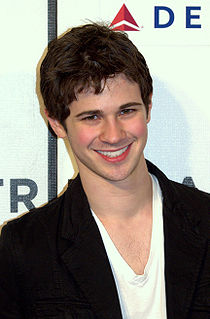
Connor Paolo is an American actor. He is known for his roles as Eric van der Woodsen on The CW's teen drama series Gossip Girl and Declan Porter on the ABC drama series Revenge. He has also appeared in two Oliver Stone films, Alexander (2004) and World Trade Center (2006).
Adam Jezierski, Polish-Spanish actor and singer births
Adam Jezierski Ros is a Polish actor based in Spain. He is known for playing lead role in the series Física o Química as Gorka Martínez Mora.
Patrick Peterson, American football player births

Patrick De'mon Peterson Jr. is an American football cornerback for the Minnesota Vikings of the National Football League (NFL). He played college football at LSU, where he won the Chuck Bednarik Award as the best defensive player in the country and the Jim Thorpe Award as the best defensive back.
Caroline Wozniacki, Danish tennis player births

Caroline Wozniacki is a Danish former professional tennis player. She was ranked world No. 1 in singles for a total of 71 weeks, including at the end of 2010 and 2011. She achieved the top ranking for the first time on 11 October 2010, becoming the 20th player in the Open Era and the first woman from a Scandinavian country to hold the top position. In 2018, she became the first Dane to win a Grand Slam singles title, after winning the 2018 Australian Open.
Tobias Sana, Swedish footballer births
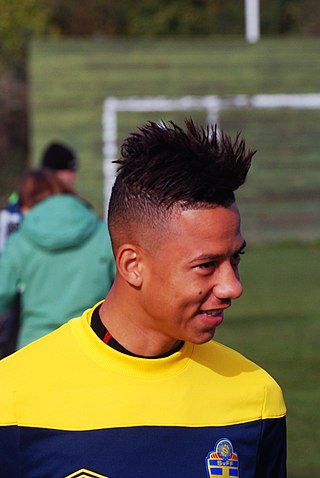
Tobias Tigjani Sana is a Swedish professional footballer who plays as an attacking midfielder for Allsvenskan club BK Häcken.
Travis Waddell, Australian rugby league player births

Travis Waddell is an Australian professional rugby league footballer who plays for the Souths Logan Magpies in the Intrust Super Cup. He plays as a hooker. He previously played for the Canberra Raiders, Newcastle Knights and most recently the Brisbane Broncos in the National Rugby League.
Shimanoumi Koyo, Japanese sumo wrestler births

Shimanoumi Koyo is a Japanese professional sumo wrestler from Shima, Mie. He debuted in sumo wrestling in July 2012 and made his makuuchi debut in May 2019. His highest rank has been maegashira 3. He wrestles for Kise stable.
Laurence Olivier, English actor, director, and producer (b. 1907) deaths

Laurence Kerr Olivier, Baron Olivier, was an English actor and director who, along with his contemporaries Ralph Richardson and John Gielgud, was one of a trio of male actors who dominated the British stage of the mid-20th century. He also worked in films throughout his career, playing more than fifty cinema roles. Late in his career, he had considerable success in television roles.
Étienne Capoue, French footballer births

Étienne René Capoue is a French professional footballer who plays as a defensive midfielder for La Liga club Villarreal.
Natalie La Rose, Dutch singer, songwriter and dancer births
Natalie Monica La Rose is a Surinamese–Dutch singer, songwriter and dancer. In 2013, she signed a recording contract with American rapper Flo Rida's International Music Group imprint and Republic Records.
Shigeaki Kato, Japanese singer births
Shigeaki Kato is a member of the J-pop group NEWS, from Johnny's Entertainment, Inc.
Avi Ran, Israeli footballer (b. 1963) deaths

Avi Ran was a goalkeeper at the Israeli football club Maccabi Haifa. Widely considered one of the greatest football players in Israel, he had a promising future which was cut short by a fatal accident.
Yaakov Yitzchok Ruderman, American rabbi and scholar (b. 1901) deaths
Yaakov Yitzchok Ruderman was a prominent Talmudic scholar and rabbi who founded and served as rosh yeshiva of Yeshivas Ner Yisroel in Baltimore.
Raúl García, Spanish footballer births

Raúl García Escudero is a Spanish professional footballer who plays for La Liga club Athletic Bilbao mainly as an attacking midfielder or second striker.
Yoann Gourcuff, French footballer births

Yoann Miguel Gourcuff is a French former professional footballer who played mainly as an attacking midfielder. He could also be utilized as a withdrawn striker, and was described as a "playmaker of real quality" who "is an accomplished passer of the ball". Gourcuff was described by former France international player David Ginola as the best French player of his generation. His talent, elegant playing style, tenacity on the pitch, technical skills and precocious ability have drawn comparisons to French legend Zinedine Zidane.
Ryan Jarvis, English footballer births

Ryan Robert Jarvis is an English footballer who plays for Southern League Premier Division Central side Leiston, where he plays as a midfielder.
Robert Adamson, American actor, director, and producer births
Robert Gillespie Adamson IV is an American actor. He has portrayed the roles of Phil Sanders on the television series Hollywood Heights and Charles Antoni on Lincoln Heights. He starred as Noah Newman on The Young and the Restless from 2012 to 2020.
Orestis Karnezis, Greek footballer births

Orestis-Spyridon Karnezis is a Greek former professional footballer who played as a goalkeeper.
Yorman Bazardo, Venezuelan baseball player births

Yorman Michael Bazardo Osorio is a Venezuelan former professional baseball pitcher. He played in Major League Baseball (MLB) for the Florida Marlins, Detroit Tigers and Houston Astros.
Tanith Belbin, Canadian-American ice dancer births

Tanith Jessica Louise Belbin is a Canadian-American ice dancer and Olympic program host for NBC Sports. Though born in Canada, she holds dual citizenship and has competed for the United States since she began skating with Benjamin Agosto in 1998. With Agosto, Belbin is the 2006 Olympic silver medalist, four-time World medalist, three-time Four Continents champion (2004–2006), and five-time U.S. champion (2004–2008).
Jacoby Jones, American football player births
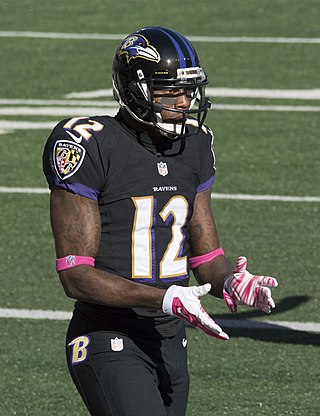
Jacoby Rashi'd Jones is a former American football wide receiver and return specialist. He played college football at Lane College, and was drafted by the Houston Texans in the third round of the 2007 NFL Draft. He played for the Texans from 2007 to 2011. Jones then played for the Baltimore Ravens from 2012 to 2014, and was selected for the Pro Bowl in 2012. He is known for two of the most memorable plays in the 2012 NFL playoffs as a member of the Ravens: catching a 70-yard game-tying touchdown pass in the final seconds of regulation in the AFC Divisional playoff game against the Denver Broncos, which helped lead the Ravens to an eventual 38–35 double overtime victory; and a 108-yard kickoff return for a touchdown in Super Bowl XLVII against the San Francisco 49ers, the longest play in Super Bowl history. He also played for the San Diego Chargers and Pittsburgh Steelers in 2015 and the Monterrey Steel of the National Arena League in 2017.
Joe Pavelski, American ice hockey player births

Joseph James Pavelski is an American professional ice hockey player and alternate captain for the Dallas Stars of the National Hockey League (NHL). He previously played for the San Jose Sharks for the first thirteen years of his NHL career and served as captain during his final four years with the team. He attended University of Wisconsin and played for the Wisconsin Badgers men's ice hockey team.
Morné Steyn, South African rugby player births

Morné Steyn is a South African rugby union player who plays as a fly-half for the Bulls and played for the South Africa national team, up until his retirement from international test rugby in October 2021.
Engin Baytar, German-Turkish footballer births

Engin Baytar is a Turkish professional footballer who plays as a winger for İstanbul Siirtgücüspor.
Peter Cincotti, American singer-songwriter and pianist births

Peter Cincotti is an American singer-songwriter. He began playing piano at the age of three. While in high school, he regularly performed in clubs throughout Manhattan. In 2003, Cincotti's debut album, produced by Phil Ramone, reached No. 1 on the Billboard jazz chart, making Cincotti the youngest musician to do so. This led to performances at Carnegie Hall, Lincoln Center, Radio City Music Hall, L'Olympia, Queen Elizabeth Hall, and the Montreux Jazz Festival where he won an award in the piano competition. Cincotti's style blends pop, rock, blues, and jazz.
Marie Serneholt, Swedish singer and dancer births

Marie Eleonor Serneholt is a Swedish singer and model. She was a member of the Swedish pop band A*Teens from 1998 to 2004, and briefly pursued a solo recording career after the band dissolved.
Ross Macdonald, American-Canadian author (b. 1915) deaths
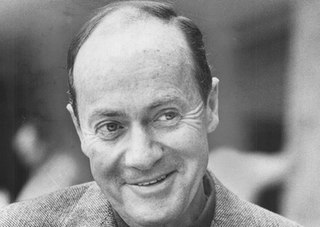
Ross Macdonald was the main pseudonym used by the American-Canadian writer of crime fiction Kenneth Millar. He is best known for his series of hardboiled novels set in Southern California and featuring private detective Lew Archer. Since the 1970s, Macdonald's works have received attention in academic circles for their psychological depth, sense of place, use of language, sophisticated imagery and integration of philosophy into genre fiction.
Chris Cooley, American football player births
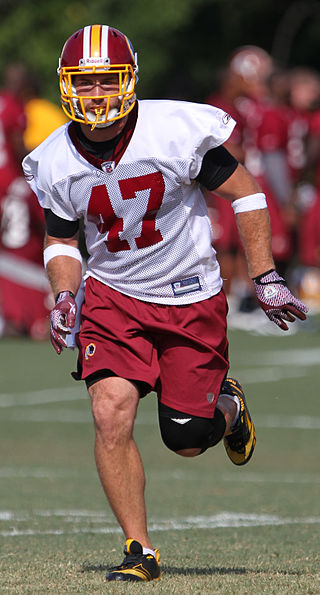
Christopher Ken Cooley is a former American football tight end who played for the Washington Redskins of the National Football League (NFL). He played college football for Utah State University, and was drafted by the Redskins in the third round of the 2004 NFL draft.
Andre Johnson, American football player births
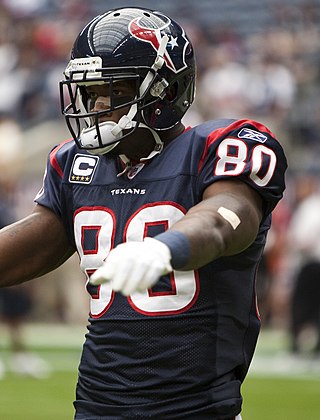
Andre Lamont Johnson is a former American football wide receiver who played most of his 14-year career with the Houston Texans of the National Football League (NFL). He played college football at Miami, and was drafted by the Texans third overall in the 2003 NFL Draft. He is 11th all-time in NFL career receptions, and in NFL receiving yards. Johnson holds nearly every Texans receiving record. He was also a member of the Indianapolis Colts and Tennessee Titans. During his career, Johnson was named to the Pro Bowl seven times, the All-Pro team four times, and emerged as one of the NFL's most productive wide receivers of the 21st century.
Susana Barreiros, Venezuelan judge births
Susana Virginia Barreiros Rodríguez is a Venezuelan judge, most notable for leading the case and sentencing against the opposition leader Leopoldo López. She was provisionally designated as Public Defender of Venezuela in 2015, until the role was given to Carmen Marisela Castro on 8 January 2019.
Tyson Kidd, Canadian wrestler births

Theodore James "TJ" Wilson is a Canadian retired professional wrestler better known by the ring name Tyson Kidd. He is currently signed to WWE, where he works as a producer.
Kevin Powers, American soldier and author births
Kevin Powers is an American fiction writer, poet, and Iraq War veteran.
Raio Piiroja, Estonian footballer births
Raio Piiroja is an Estonian former professional footballer. He played as a centre-back for Pärnu/Kalev, Lelle, Flora, Vålerenga, Fredrikstad, Vitesse and Chengdu Blades.
Claude Wagner, Canadian lawyer, judge, and politician (b. 1925) deaths
Claude Wagner was a Canadian judge and politician in the province of Quebec, Canada. Throughout his career, he was a Crown prosecutor, professor of criminal law and judge.
Kathleen Edwards, Canadian singer-songwriter and guitarist births

Kathleen Edwards is a Canadian singer-songwriter and musician. Her 2002 debut album, Failer, contained the singles "Six O'Clock News" and "Hockey Skates". Her next two albums – Back to Me and Asking for Flowers – both made the Billboard 200 list and reached the top 10 of Billboard's Top Heatseekers chart. In 2012, Edwards' fourth studio album, Voyageur, became Edwards' first album to crack the top 100 and top 40 in the U.S., peaking at #39 on the U.S. Billboard 200 and #2 in Canada. In 2012, Edwards' song "A Soft Place To Land" won the SOCAN Songwriting Prize, an annual competition that honours the best song written and released by 'emerging' songwriters over the past year, as voted by the public. Her musical sound has been compared to Suzanne Vega meets Neil Young.
Massimiliano Rosolino, Italian swimmer births
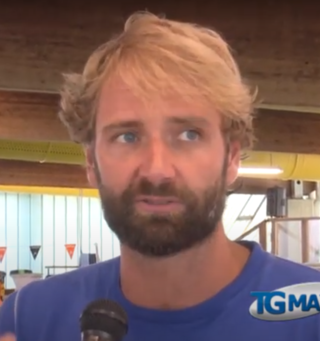
Massimiliano "Massi" Rosolino is an Italian retired competitive swimmer.
Brandon Short, American football player and sportscaster births
Brandon Darrell Short is a former American college and professional football player who was a linebacker in the National Football League (NFL) for seven seasons. He played college football for Penn State University, and was recognized as an All-American. He played professionally for the New York Giants and Carolina Panthers of the NFL, and was a member the Giants' team that played in Super Bowl XXXV. He is currently Director of Mergers and Acquisitions at Round Hill Capital in London and a member of the Pennsylvania State University's Board of Trustees.
Eduardo Nájera, Mexican-American basketball player and coach births
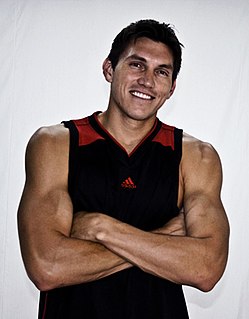
Eduardo Alonso Nájera Pérez is a Mexican former professional basketball player who is currently a scout for the Dallas Mavericks of the National Basketball Association (NBA). He is also a pregame and postgame analyst on Mavericks Live on Fox Sports Southwest, where he is identified as Eddie. Before being promoted to a scout with the Mavs, he was head coach of the Texas Legends of the NBA D-League.
León de Greiff, Colombian poet and educator (b. 1895) deaths
Francisco de Asís León Bogislao de Greiff Haeusler, was a Colombian poet known for his stylistic innovations and deliberately eclectic use of obscure lexicon. Best known simply as León de Greiff, he often used different pen names. The most popular were Leo le Gris and Gaspar Von Der Nacht. De Greiff was one of the founders of Los Panidas, a literary and artistic group established in 1915 in the city of Medellín.
Willie Anderson, American football player births
Willie Aaron Anderson is a former American football player who was an offensive tackle for the Cincinnati Bengals and Baltimore Ravens of the National Football League (NFL). He played college football for Auburn University. He was drafted by the Bengals 10th overall in the 1996 NFL Draft. A four-time Pro Bowler and three-time First-team All-Pro selection, Anderson played his first 12 seasons with the Bengals.
Rubén Baraja, Spanish footballer and manager births

Rubén Baraja Vegas is a Spanish retired footballer, currently a manager.
Lil' Kim, American rapper and producer births

Kimberly Denise Jones, better known by her stage name Lil' Kim, is an American rapper and reality television personality. Born and raised in Brooklyn, New York City, she lived much of her adolescent life on the streets after being expelled from home. In her teens, Jones would freestyle rap, influenced by fellow female hip hop artists like MC Lyte and the Lady of Rage. In 1994, she was discovered by fellow rapper The Notorious B.I.G., who invited her to join his group Junior M.A.F.I.A.; their debut album, Conspiracy, generated two top 20 singles in the United States and was certified gold by the Recording Industry Association of America (RIAA).
Alanas Chošnau, Lithuanian singer-songwriter births
Alanas Chošnau is a Lithuanian singer and songwriter of Lithuanian and Iraqi Kurdish origin. In 1992 – 2001 and 2014 – 2018 he was the frontman of the band Naktinės Personos. In 2001 – 2009 and since 2019 Chošnau successfully develops solo career. He owns the 'Best Performer of the Year', 'Best Song', 'Best Video', 'Golden Disc' national awards. Chošnau is continuously named as one of the most played and most performing artists of Lithuania.
Hermann Hreiðarsson, Icelandic footballer and manager births

Hermann Hreiðarsson is an Icelandic former professional football player and coach. He played as a defender and spent 15 seasons in England, gaining a total of 315 appearances in the Premier League.
André Ooijer, Dutch footballer and coach births
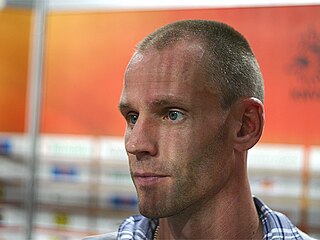
André Antonius Maria Ooijer is a former Dutch footballer who played as a defender. He played his last professional game for Ajax against Vitesse on 6 May 2012.
Pär Lagerkvist, Swedish novelist, playwright, and poet Nobel Prize laureate (b. 1891) deaths

Pär Fabian Lagerkvist was a Swedish author who received the 1951 Nobel Prize in Literature.

The Nobel Prize in Literature is a Swedish literature prize that is awarded annually, since 1901, to an author from any country who has, in the words of the will of Swedish industrialist Alfred Nobel, "in the field of literature, produced the most outstanding work in an idealistic direction". Though individual works are sometimes cited as being particularly noteworthy, the award is based on an author's body of work as a whole. The Swedish Academy decides who, if anyone, will receive the prize. The academy announces the name of the laureate in early October. It is one of the five Nobel Prizes established by the will of Alfred Nobel in 1895. Literature is traditionally the final award presented at the Nobel Prize ceremony. On some occasions the award has been postponed to the following year, most recently in 2018 as of May 2022.
Konstantinos Kenteris, Greek runner births
Konstantinos "Kostas" Kenteris, also spelled as Konstadinos "Costas" Kederis is a Greek former athlete. He won gold medals in the 200 metres at the 2000 Summer Olympics, the 2001 World Championships in Athletics and the 2002 European Championships in Athletics, making him the only European sprinter to win the gold medal in all three major competitions and the only European World Champion in the 200 metres races. Additionally, he has won two gold, three silver and two bronze medals in the European Cup, as well as three gold medals in the 200 metres at the Athens Grand Prix Tsiklitiria. He is also a 14-time golden medalist at the Greek Athletics Championships and a five-time golden medalist at the Greek Indoor Athletics Championships. He withdrew from the 2004 Summer Olympics, held in his home country, after a doping violation. He was named the Greek Male Athlete of the Year, for the years 2000, 2001, and 2002.
Cormac Battle, English-Irish singer-songwriter, guitarist, and producer births
Cormac Battle is an Irish musician and radio presenter/producer. He is the vocalist and lead guitarist for the bands Kerbdog, Wilt, Jonny's Boys, and On the turn. He is also the current presenter of RTÉ 2fm's alternative music programme, The Battle Axe.
Leisha Hailey, Japanese-American singer-songwriter and actress births

Leisha Hailey is an American actress and musician known for playing Alice Pieszecki in the Showtime Networks series The L Word and The L Word: Generation Q. Hailey first came to the public's attention as a musician in the pop duo The Murmurs and has continued her music career as part of the band Uh Huh Her.
John W. Campbell, American journalist and author (b. 1910) deaths

John Wood Campbell Jr. was an American science fiction writer and editor. He was editor of Astounding Science Fiction from late 1937 until his death and was part of the Golden Age of Science Fiction. Campbell wrote super-science space opera under his own name and stories under his primary pseudonym, Don A. Stuart. Campbell also used the pen names Karl Van Kampen and Arthur McCann. His novella Who Goes There? was adapted as the films The Thing from Another World (1951), The Thing (1982), and The Thing (2011).
Pedro Rodríguez, Mexican racing driver (b. 1940) deaths

Pedro Rodríguez de la Vega was a Mexican sports car and Grand Prix motor racing driver. He was the older brother of Ricardo Rodríguez. Both brothers started racing at an early age, first on motorbikes and then moving to cars. Following his brother's death in a racing accident in 1962, Pedro briefly considered retiring from racing, but decided to carry on.
Justin Chambers, American actor births

Justin Willman Chambers is an American actor and former model. He is best known for his role as Dr. Alex Karev in the ABC television drama Grey's Anatomy from 2005 to 2020. Born in Ohio, he went to Southeastern High School, South Charleston, and later studied acting at New York's HB Studio. Chambers began modeling after being approached by a modeling scout in Paris. He went on to represent fashion brands including Calvin Klein, Armani, and Dolce & Gabbana. Chambers began his acting career with a recurring role in the soap opera Another World and made his feature film debut with a supporting role in 1999's comedy drama Liberty Heights. His breakthrough role came in 2005 when he was cast as Dr. Alex Karev in the ABC medical drama series Grey's Anatomy. Chambers gained widespread recognition as the series progressed and the character became one of the most popular from the hit series, earning multiple nominations and the 2017 Best TV Network Drama Actor at the People's Choice Awards as well as nominations for the Screen Actors Guild Award.
Sajjad Karim, English lawyer and politician births

Sajjad Haider Karim is a British politician. He served as a Member of the European Parliament for the North West England between 2004 and 2019. Sajjad is one of 10 members of the executive of European Movement UK and Chair of Conservative European Forum Trade.
Eric Owens, American opera singer births
Eric Owens is an American operatic bass-baritone. He has performed both in new works and reinterpreted classic repertoire. In 1996 he won the Metropolitan Opera National Council Auditions.
Ned Boulting, British sports journalist and television presenter births

Norris Edward Boulting is a British sports journalist and television presenter best known for his coverage of football, cycling and darts.
Michael Geist, Canadian journalist and academic births
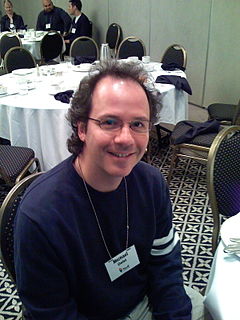
Michael Allen Geist is a Canadian academic, the Canada Research Chair in Internet and E-Commerce Law at the University of Ottawa and a member of the Centre for Law, Technology and Society. Geist was educated at the University of Western Ontario, Osgoode Hall Law School, where he received his Bachelor of Laws, Cambridge University, where he received a Master of Laws, and Columbia Law School, where he received a Master of Laws and Doctor of Law degree. He has been a visiting professor at universities around the world including the University of Haifa, Hong Kong University, and Tel Aviv University. He is also a senior fellow at the Centre for International Governance Innovation.
Daniel MacMaster, Canadian singer-songwriter (d. 2008) births
Daniel Stewart MacMaster was a Canadian singer, who was lead vocalist for the Canadian/British hard rock band Bonham.
Esera Tuaolo, American football player births

Esera Tavai Tuaolo, nicknamed "Mr. Aloha", is a former American professional football player. He was a defensive tackle in the National Football League (NFL) for 10 years.
Andy Ashby, American baseball player and sportscaster births
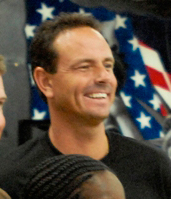
Andrew Jason Ashby is an American former professional baseball starting pitcher, who played for the Philadelphia Phillies, Colorado Rockies, San Diego Padres, Atlanta Braves, and Los Angeles Dodgers of Major League Baseball. Listed at 6' 1", 180 lb., Ashby batted and threw right-handed. He was born in Kansas City, Missouri. Andy is the uncle to professional player Aaron Ashby.
Jhumpa Lahiri, Indian American novelist and short story writer births

Nilanjana Sudeshna "Jhumpa" Lahiri is an American author known for her short stories, novels and essays in English, and, more recently, in Italian.
Guy Favreau, Canadian lawyer, judge, and politician, 28th Canadian Minister of Justice (b. 1917) deaths
Guy Favreau, was a Canadian lawyer, politician and judge.

The minister of justice and attorney general of Canada is a dual-role portfolio in the Canadian Cabinet.
Nadeem Aslam, Pakistani-English author births

Nadeem Aslam FRSL is a British Pakistani novelist. His debut novel, Season of the Rainbirds, won the Betty Trask and the Author's Club First Novel Award. His critically acclaimed second novel Maps for Lost Lovers won Encore Award and Kiriyama Prize; it was shortlisted for International Dublin Literary Award, among others. Colm Tóibín described him as "one of the most exciting and serious British novelists writing now".
Kentaro Miura, Japanese author and illustrator (d. 2021) births

Kentaro Miura was a Japanese manga artist. He was best known for his acclaimed dark fantasy series Berserk, which began serialization in 1989 and continued until his death. As of 2021, Berserk had more than 50 million copies in circulation, making it one of the best-selling manga series of all time. In 2002, Miura received the Award for Excellence at the 6th Tezuka Osamu Cultural Prizes.
Rod Strickland, American basketball player and coach births

Rodney Strickland is an American basketball coach and former professional basketball player. He is currently the head coach at Long Island University. Prior to LIU, he served as the program manager for the NBA G League's professional path. Strickland played college basketball at DePaul University, where he was awarded All-American honors. He then enjoyed a long career in the National Basketball Association (NBA), playing from 1988 to 2005. Strickland was an assistant coach for the South Florida Bulls, under Orlando Antigua from 2014 to 2017. He formerly served in an administrative role for the University of Kentucky basketball team under head coach John Calipari and was the director of basketball operations at the University of Memphis under Calipari. He is the godfather of current NBA player Kyrie Irving.
Ricky Warwick, Northern Irish musician births

Ricky Warwick is a Northern Irish musician and the lead singer of the rock bands Black Star Riders and Thin Lizzy. He is also the frontman for the Scottish hard rock band The Almighty, with whom he achieved chart success in the UK throughout the 1990s, although the band is currently on hiatus. Warwick has released several solo albums and performed with a variety of other bands and artists, and also fronts his own band, The Fighting Hearts, to showcase his solo material.
Delmore Schwartz, American poet and short story writer (b. 1913) deaths

Delmore Schwartz was an American poet and short story writer.
Tony Cottee, English footballer, manager, and sportscaster births

Antony Richard Cottee is an English former professional footballer and manager who now works as a television football commentator.
Ernesto Hoost, Dutch kick-boxer and sportscaster births
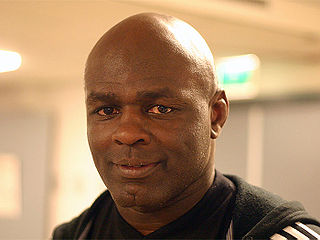
Ernesto Frits Hoost is a Dutch retired kickboxer. A four-time K-1 World Champion, Hoost is considered to be one of the greatest kickboxers of all time. Debuting in 1993 at the K-1 World Grand Prix 1993, where he came just one win short of the world title, Hoost announced his retirement thirteen years later on 2 December 2006 after the K-1 World GP Final tournament in Tokyo Dome, Japan. Hoost holds notable victories over Peter Aerts (4x), Branko Cikatić, Mirko Cro Cop (3x), Jérôme Le Banner (3x), Andy Hug (3x), Ray Sefo (3x), Musashi (2x), Mike Bernardo, Francisco Filho (2x), Sam Greco, Stefan Leko (3x), Mark Hunt, Cyril Abidi, and Glaube Feitosa.
Scott Shriner, American singer-songwriter and bass player births

Scott Gardner Shriner is an American musician best known as a member of the rock band Weezer, with whom he has recorded twelve studio albums. Joining the band in 2001, Shriner is the band's longest serving bass guitarist.
Craig Charles, English actor and TV presenter births

Craig Joseph Charles is an English actor, comedian, television and radio presenter. He is best known for his roles as Dave Lister in the science fiction sitcom Red Dwarf and Lloyd Mullaney in the soap opera Coronation Street. He presented the gladiator-style game show Robot Wars from 1998 to 2004, and narrated the comedy endurance show Takeshi's Castle. As a DJ, he appears on BBC Radio 6 Music.
Al MacInnis, Canadian ice hockey player and coach births

Allan MacInnis is a Canadian former professional ice hockey defenceman who played 23 seasons in the National Hockey League (NHL) for the Calgary Flames (1981-1994) and St. Louis Blues (1994-2004). A first round selection of the Flames in the 1981 NHL Entry Draft, he went on to become a 12-time All-Star. He was named the Conn Smythe Trophy winner as the most valuable player of the playoffs in 1989 after leading the Flames to the Stanley Cup championship. He was voted the winner of the James Norris Memorial Trophy in 1999 as the top defenceman in the league while a member of the Blues. In 2017 MacInnis was named one of the '100 Greatest NHL Players' in history.
Dean Richards, English rugby player and coach births
Dean Richards is a rugby union coach and former player for Leicester Tigers, England and British & Irish Lions. He was most recently the Director of Rugby at Newcastle Falcons, a position he held for ten years between 2012 and 2022.
Lisa Rinna, American actress and talk show host births
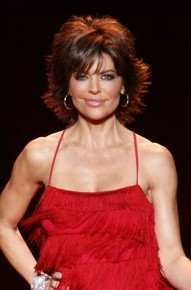
Lisa D. Rinna is an American actress and television personality. As an actress, she is best known for her roles as Billie Reed on the NBC daytime soap opera Days of Our Lives and Taylor McBride on Fox's television drama Melrose Place. Since 2014, Rinna has been a main cast member on Bravo's hit reality television series The Real Housewives of Beverly Hills. Other television credits include being a contestant on NBC's The Celebrity Apprentice and ABC's Dancing with the Stars, as well as guest-starring roles on series such as Entourage, The Middle, Veronica Mars, Community, and 8 Simple Rules. Rinna made her Broadway debut in Chicago as Roxie Hart in June 2007.
Gaétan Duchesne, Canadian ice hockey player (d. 2007) births
Gaétan Joseph Pierre Duchesne was a Canadian professional ice hockey player.
Pauline McLynn, Irish actress and author births
Pauline McLynn is an Irish character actress and author. She is best known for her roles as Mrs Doyle in the Channel 4 sitcom Father Ted, Libby Croker in the Channel 4 comedy drama Shameless, Tip Haddem in the BBC One comedy Jam & Jerusalem, and Yvonne Cotton in the BBC soap opera EastEnders. McLynn also appeared as a Garda in Sky One's Trollied.
Fumiya Fujii, Japanese music artist births
Fumiya Fujii is a Japanese musician, actor and former lead singer of The Checkers born in Kurume. His younger brother is Naoyuki Fujii, a musician and former sax player for The Checkers. His eldest son is Fuji TV announcer Kōki Fujii. He formerly belonged to Yamaha Music Foundation and Three Star Pro, and now he is part of a private agency, FFM Co.
Antony Jenkins, English banker and businessman births

Antony Peter Jenkins is a British business executive. Since 2016 he has been the chief executive officer of 10x Future Technologies, which he founded. He was the group chief executive of Barclays from 30 August 2012 until his dismissal on 8 July 2015.
David Baerwald, American singer-songwriter, composer, and musician births
David Francis Baerwald is an American singer-songwriter, composer, and musician.
Caroline Quentin, English actress births
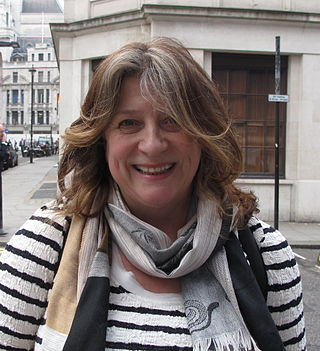
Caroline Quentin is an English actress, broadcaster and television presenter. Quentin became known for her television appearances: portraying Dorothy in Men Behaving Badly (1992–1998), Maddie Magellan in Jonathan Creek (1997–2000), and DCI Janine Lewis in Blue Murder (2003–2009).
Richie Sambora, American singer-songwriter, guitarist, and producer births

Richard Stephen Sambora is an American rock guitarist, singer, songwriter and producer, best known as the lead guitarist of the rock band Bon Jovi from 1983 to 2013. He and lead singer Jon Bon Jovi formed the main songwriting unit for the band. He has also released three solo albums: Stranger in This Town in 1991, Undiscovered Soul in 1998, and Aftermath of the Lowdown released in September 2012.
Suzanne Vega, American singer-songwriter, guitarist, and producer births

Suzanne Nadine Vega is an American singer-songwriter best known for her folk-inspired music. Vega's music career spans almost 40 years. She came to prominence in the mid-1980s, releasing four singles that entered the Top 40 charts in the UK during the 1980s and 1990s, including "Marlene on the Wall", "Left of Center", "Luka" and "No Cheap Thrill". "Tom's Diner", which was originally released as an a cappella recording on Vega's second album, Solitude Standing (1987), was remixed in 1990 as a dance track by English electronic duo DNA with Vega as featured artist, and it became a Top 10 hit in over five countries. The original a capella recording of the song was used as a test during the creation of the MP3 format. The role of her song in the development of the MP3 compression prompted Vega to be given the title of "The Mother of the MP3".
Charlie Parker, English cricketer, coach, and umpire (b. 1882) deaths

Charles Warrington Leonard Parker was an English cricketer, who stands as the third highest wicket taker in the history of first-class cricket, behind Wilfred Rhodes and Tich Freeman.
Stephanie Dabney, American ballerina (d. 2022) births
Stephanie Renee Dabney was an American dancer who performed as a prima ballerina with Dance Theatre of Harlem from 1979 through 1994. Dabney is best known for her performances in John Taras' The Firebird, which she performed all over the world, as well as at the opening ceremony of the 1984 Summer Olympics in Los Angeles.
Mark Lester, English actor births

Mark Lester is an English former child actor, osteopath, and acupuncturist who starred in a number of British and European films in the 1960s and 1970s. In 1968 he played the title role in the film Oliver!, a musical version of the Charles Dickens' novel Oliver Twist. Lester also made several appearances in a number of British television series. In 1977, after appearing in the all-star international action adventure film The Prince and the Pauper, he retired from acting. In the 1980s, he trained as an osteopath specialising in sport injuries.
Hugo Sánchez, Mexican footballer, coach, and manager births
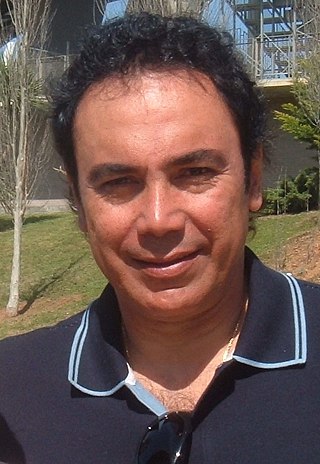
Hugo Sánchez Márquez is a Mexican former professional footballer and manager, who played as a forward. A prolific goalscorer known for his spectacular strikes and volleys, he is widely regarded as the greatest Mexican footballer of all time. In 1999, the International Federation of Football History and Statistics voted Sánchez the 26th best footballer of the 20th century, and the best footballer from the CONCACAF region. In 2004 Sánchez was named in the FIFA 100 list of the world's greatest living players. He is the fourth highest scorer in the history of La Liga, the third highest scoring foreign player after Lionel Messi and Cristiano Ronaldo, and is the seventh highest goalscorer in Real Madrid's history. He scored a total of 562 senior career goals for both club and country in 956 matches.
Johann Lamont, Scottish educator and politician births

Johann MacDougall Lamont is a Scottish Labour Co-operative politician who served as Leader of the Scottish Labour Party from 2011 to 2014. She was previously a junior Scottish Executive minister from 2004 to 2007 and Deputy Leader of the Scottish Labour Party from 2008 until her election to the leadership in 2011. In addition to her ministerial and leadership roles, she has been a campaigner on equality issues and violence against women throughout her political career.
Peter Murphy, English singer-songwriter births

Peter John Joseph Murphy is an English singer, songwriter, and musician. He is the vocalist for the post-punk goth rock band Bauhaus. After Bauhaus initially disbanded, Murphy formed Dali's Car with Japan's bassist Mick Karn and released one album, The Waking Hour (1984). He later went on to release a number of solo albums, including Should the World Fail to Fall Apart (1986) and Love Hysteria (1988). In 1990, he achieved mainstream success with his hit single "Cuts You Up", which topped the American Modern Rock Tracks for 7 weeks. His album Deep also reached No. 44 on the Billboard 200. In 1992, Murphy released Holy Smoke, which reached No. 108 on the Billboard 200 chart along with lead single "The Sweetest Drop", which peaked at No. 2 on the American Modern Rock Tracks chart. In 2002, Murphy released Dust with Turkish-Canadian composer and producer Mercan Dede, which utilizes traditional Turkish instrumentation and songwriting, abandoning Murphy's previous pop and rock incarnations, and juxtaposing elements from progressive rock, trance, classical music, and Middle Eastern music, coupled with Dede's trademark atmospheric electronics. In 2014, he released Lion, produced by Killing Joke's Youth, which reached No. 173 on the Billboard 200.
Patsy O'Hara, Irish Republican hunger striker (d. 1981) births
Patsy O'Hara was an Irish republican hunger striker and member of the Irish National Liberation Army (INLA).
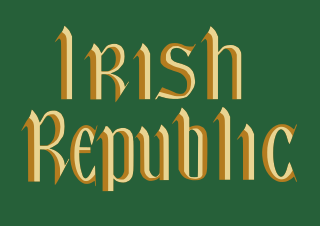
Irish republicanism is the political movement for the unity and independence of Ireland under a republic. Irish republicans view British rule in any part of Ireland as inherently illegitimate.
Michael Rose, Jamaican singer-songwriter births
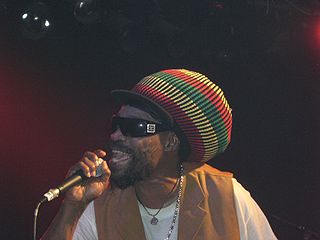
Michael Rose is a Grammy award-winning reggae singer from Jamaica. He is known for a successful tenure with Black Uhuru from 1977 to 1984, and he has worked regularly with Dennis Brown, Big Youth, The Wailers, Gregory Isaacs, Sly and Robbie, and others. He has also released more than twenty solo albums.
Amitav Ghosh, Indian-American author and academic births

Amitav Ghosh is an Indian writer. He won the 54th Jnanpith award in 2018, India's highest literary honor. Ghosh's ambitious novels use complex narrative strategies to probe the nature of national and personal identity, particularly of the people of India and South Asia. He has written historical fiction and also written non-fiction works discussing topics such as colonialism and climate change.
Robin Renucci, French actor and director births
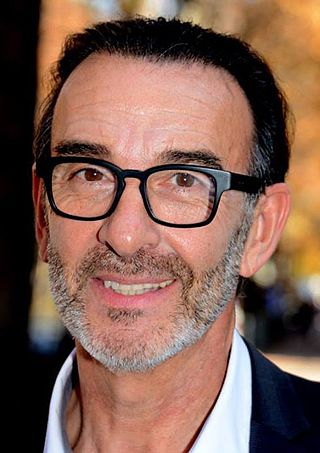
Robin Renucci is a French film and television actor and film director.
Sela Ward, American actress births

Sela Ann Ward is an American actress, author, and producer. Her breakthrough TV role was as Teddy Reed in the NBC drama series Sisters (1991–1996), for which she received her first Primetime Emmy Award for Outstanding Lead Actress in a Drama Series in 1994. She received her second Primetime Emmy Award and Golden Globe Award for Best Actress – Television Series Drama for the leading role of Lily Manning in the ABC drama series Once and Again (1999–2002). Ward later had the recurring role of Stacy Warner in the Fox medical drama House, also starred as Jo Danville in the CBS police procedural CSI: NY (2010–2013) and starred as Dana Mosier in the CBS police procedural series FBI (2018–2019).
Balaji Sadasivan, Singaporean neurosurgeon and politician, Singaporean Minister of Health (d. 2010) births
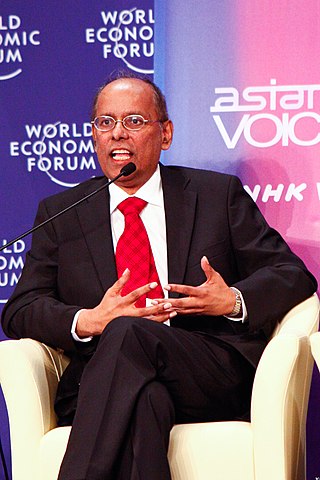
Balaji Sadasivan was a Singaporean politician and neurosurgeon. He attended Raffles Institution, Siglap Secondary School and National Junior College, and studied medicine at the University of Singapore. After graduating in 1979, he continued his education at the Royal College of Physicians and Surgeons of Glasgow, becoming a Fellow of the Royal College of Surgeons (F.R.C.S.) in 1984. He also trained at the Henry Ford Hospital in Detroit, Michigan, from 1985 to 1989, and became a Fellow of Harvard University in 1990. He worked as a neurosurgeon until 2001, publishing over 50 book chapters and journal articles.
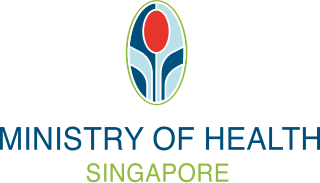
The Ministry of Health is a ministry of the Government of Singapore responsible for managing the public healthcare system in Singapore.
Julia King, English engineer and academic births

Julia Elizabeth King, Baroness Brown of Cambridge is a British engineer and crossbench member of the House of Lords, present Chair of the Carbon Trust and the Henry Royce Institute, and was the Vice-Chancellor of Aston University from 2006 to 2016.
Piyasvasti Amranand, Thai businessman and politician, Thai Minister of Energy births
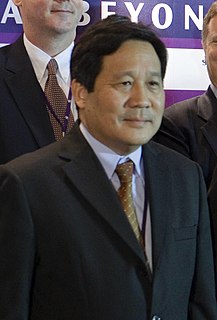
Piyasvasti Amranand, born 11 July 1953) was Thailand's Energy Minister between 9 October 2006 and 6 February 2008. He is former Secretary-General of the Thai National Energy Policy Office, Chairman of Kasikorn Asset Management, and Chairman of the Panel of Advisors to the CEO of Kasikornbank. He was President of Thai Airways International between October 2009 and June 2012 and Chairman of PTT Public Company Limited between July 2014 and 2018. He is currently Chairman of PTT Global Chemical plc., board member of Kasikorn Bank, board member of Pruksa Holding plc., and Chairman of Thai Airways Rehabilitation Plan Administrator. Piyasvasti plays active roles in three non-profit organizations as a founding and core member of the Energy Reform for Sustainability Group (ERS); Chairman of the Energy for Environment Foundation, a non-profit organization undertaking renewable energy and energy efficiency projects; and as president of the Ski and Snowboard Association of Thailand.

The Ministry of Energy of the Kingdom of Thailand is a cabinet ministry in the Government of Thailand. Its budget for fiscal year 2019 is 2,319 million baht.
Angélica Aragón, Mexican film, television, and stage actress and singer births

Angélica Espinoza Stransky, known as Angélica Aragón, is a Mexican film, television and stage actress and singer. She is daughter of the Mexican composer José Ángel Espinoza "Ferrusquilla". She is recognized for her performances in various Mexican film productions such as Cilantro y perejil (1997), Sexo, pudor y lágrimas (1999) and El crimen del Padre Amaro (2002) and in diverse American productions like A Walk in the Clouds (1995) and Dirty Dancing: Havana Nights (2002) among others. She is also famous for having starred in two famous Mexican telenovelas: Vivir un poco (1985) and Mirada de mujer (1997).
Peter Brown, American singer-songwriter and producer births
Peter Brown is an American singer-songwriter and record producer. Brown was a popular performer in the late 1970s and early 1980s. His biggest success was the release of the LP in 1977 called A Fantasy Love Affair which produced the disco hits "Do Ya Wanna Get Funky with Me" and "Dance With Me". He wrote, with Robert Rans, Madonna's hit "Material Girl".
Suresh Prabhu, Indian accountant and politician, Indian Minister of Railways births

Suresh Prabhakar Prabhu is an Indian politician, India's Sherpa to the G7 and Chancellor of Rishihood University. who was the Minister of Civil Aviation, Railways, Commerce & Industry in the First Modi ministry.

The Ministry of Railways is a ministry in the Government of India, responsible for the country's rail transport. The ministry operates the statutory body Indian Railways, an organisation that operates as a monopoly in rail transport and is headed by the Chairman and CEO of Railway Board. The Ministry of Railways along with the Railway Board is housed inside Rail Bhawan in New Delhi.
Patricia Reyes Spíndola, Mexican actress, director, and producer births

Patricia Verónica Núñez Reyes Spíndola is a Mexican actress, director, and producer. She has received four Ariel Awards, two for Best Actress, and two for Supporting Actress.
Leon Spinks, American boxer (d. 2021) births

Leon Spinks was an American professional boxer who competed from 1977 to 1995. In only his eighth professional fight, he won the undisputed heavyweight championship in 1978 after defeating Muhammad Ali in a split decision, in what is considered one of the biggest upsets in boxing history. Spinks was later stripped of the WBC title for facing Ali in an unapproved rematch seven months later, which he lost by a unanimous decision.
Mindy Sterling, American actress births

Mindy Lee Sterling is an American television, film and voice actress. She portrayed Frau Farbissina in the Austin Powers film series and starred in the web series Con Man, the latter of which earned her a Primetime Emmy Award nomination. She has had recurring roles as Miss Francine Briggs on the Nickelodeon series iCarly, Principal Susan Skidmore on the Disney Channel series A.N.T. Farm, and Linda Schwartz on the ABC series The Goldbergs.
Ivan Toms, South African physician and activist (d. 2008) births
Ivan Toms was a South African physician, who battled the Apartheid era government as a prominent anti-Apartheid and anti-conscription activist. At the time of his death in 2008, Toms was serving as the Director of Health for the city of Cape Town, South Africa.
Bramwell Tovey, English-Canadian conductor and composer births

Bramwell Tovey was a British conductor and composer.
Paul Weiland, English director, producer, and screenwriter births
Paul Weiland OBE is an English motion picture and television director, writer and producer. Weiland is a director and producer of television commercials in the UK, having made over 500 commercials, including a popular and long-running series for Walkers crisps. He has also directed several British television series, including Alas Smith and Jones (1989–1992) and Mr. Bean (1991–1992). His feature film credits include Made of Honor (2008), Sixty Six (2006), Blackadder: Back & Forth (1999), Roseanna's Grave (1997), City Slickers II: The Legend of Curly's Gold (1994) and Leonard Part 6 (1987).
Bill Barber, Canadian ice hockey player and coach births
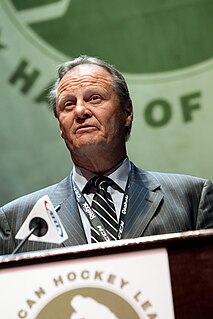
William Charles Barber is a Canadian former professional ice hockey forward who played twelve seasons for the Philadelphia Flyers in the National Hockey League (NHL). As part of the famed LCB line, Barber helped lead the Flyers to the franchise's two Stanley Cups in 1974 and 1975. He was inducted into the Hockey Hall of Fame in 1990. He is currently a scouting consultant with the Flyers.
Stephen Lang, American actor and playwright births

Stephen Lang is an American actor. He is known for roles in films including Manhunter (1986), Gettysburg, Tombstone, Gods and Generals (2003), Public Enemies (2009), Conan the Barbarian (2011), The Girl on the Train (2013) and Don't Breathe (2016). Outside of these roles, he has had an extensive career on Broadway, and has received a Tony Award nomination for his role in the 1992 production of The Speed of Darkness. He won the Saturn Award for Best Supporting Actor for his performance in James Cameron's Avatar (2009). From 2004 to 2006, he was co-artistic director of the Actors Studio.
Ed Ott, American baseball player and coach births

Nathan Edward Ott, nicknamed "Otter", is an American former professional baseball player, coach and manager. He played as a catcher in Major League Baseball (MLB) from 1974 to 1981, most notably as a member of the Pittsburgh Pirates with whom he won a World Series championship in 1979. He also played for the California Angels. Ott was a left-handed batter and threw right-handed.
Pervez Hoodbhoy, Pakistani physicist and academic births

Pervez Amirali Hoodbhoy is a Pakistani nuclear physicist and activist who serves as a professor at the Forman Christian College and previously taught physics at the Quaid-e-Azam University. Hoodbhoy is also a prominent activist in particular concerned with promotion of freedom of speech, secularism, scientific temper and education in Pakistan.
J. R. Morgan, Welsh author and academic births
John Robert Morgan is a British academic working at Swansea University in Wales. He is primarily known for writing books on Classics, and for contributing to a number of journals, often with colourful views.
Bonnie Pointer, American singer (d. 2020) births
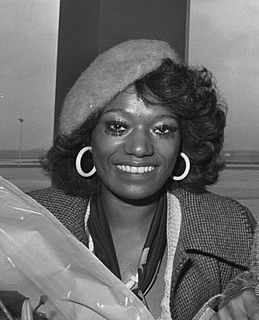
Patricia Eva "Bonnie" Pointer was an American singer, best known for having been a member of the vocal group, the Pointer Sisters. Pointer scored several moderate solo hits after leaving the Pointers in 1977, including a disco cover of the Elgins' "Heaven Must Have Sent You" which became a U.S. top 20 pop hit on September 1, 1979.
Jeff Hanna, American singer-songwriter, guitarist, and drummer births
Jeffrey R. Hanna is an American singer-songwriter and performance musician, best known for his association with the Nitty Gritty Dirt Band. His professional music career has spanned six decades.
Norman Lebrecht, English author and critic births

Norman Lebrecht is a British music journalist and author who specializes in classical music. He is best known as the owner of the classical music blog, Slipped Disc, where he frequently publishes articles. Unlike other writers on music, Lebrecht rarely reviews concerts or recordings, preferring to report on the people and organizations who engage in classical music. Described by Gilbert Kaplan as "surely the most controversial and arguably the most influential journalist covering classical music", his writings have been praised as entertaining and revealing, while others have accused them of sensationalism and criticized their inaccuracies.
Bo Lundgren, Swedish politician births

Bo Axel Magnus Lundgren is a Swedish politician. He was the leader of the Moderate Party from 1999 to 2003.
Martin Wong, American painter (d. 1999) births
Martin Wong was a Chinese-American painter of the late 20th century. His work has been described as a meticulous blend of social realism and visionary art styles. Wong's paintings often explored multiple ethnic and racial identities, exhibited cross-cultural elements, demonstrated multilingualism, and celebrated his queer sexuality.
Lou Hudson, American basketball player and coach (d. 2014) births
Louis Clyde Hudson was an American National Basketball Association (NBA) player, who was an All-American at the University of Minnesota and a six-time NBA All-Star, scoring 17,940 total points in 13 NBA seasons (1966–1979).
Michael Levy, Baron Levy, English philanthropist births

Michael Abraham Levy, Baron Levy, is a Labour Party peer. He is a former chartered accountant and was chairman and CEO of a large independent group of music companies. He now acts as a consultant for a number of companies and is also chairman of a finance company.
Patricia Polacco, American author and illustrator births
Patricia Barber Polacco is an American author and illustrator. Throughout her school years, Polacco struggled with reading but found relief by expressing herself through art. Polacco endured teasing and hid her disability until a school teacher recognized that she could not read and began to help her. Her book Thank You, Mr. Falker is Polacco's retelling of this encounter and its outcome. She also wrote such books as Mr. Lincoln's Way and The Lemonade Club.
Richard Carleton, Australian journalist (d. 2006) births
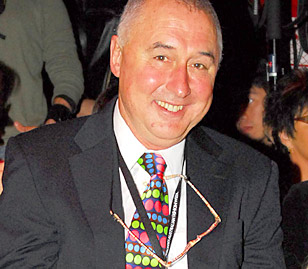
Richard George Carleton was a multiple Logie Award–winning Australian television journalist.
Howard Gardner, American psychologist and academic births

Howard Earl Gardner is an American developmental psychologist and the John H. and Elisabeth A. Hobbs Research Professor of Cognition and Education at the Harvard Graduate School of Education at Harvard University. He is currently the senior director of Harvard Project Zero, and since 1995, he has been the co-director of The Good Project.
Tom Holland, American actor, director, and screenwriter births

Thomas Lee Holland is an American screenwriter, actor, and director best known for his work in the horror film genre, penning the 1983 sequel to the classic Alfred Hitchcock film Psycho, directing and co-writing the first entry in the long-running Child's Play franchise, and writing and directing the cult vampire film Fright Night. He also directed the Stephen King adaptations The Langoliers and Thinner. He is a two-time Saturn Award recipient. Holland made the jump into children’s literature in 2018 when he co-wrote How to Scare a Monster with fellow writer Dustin Warburton.
Peter Jensen, Australian metropolitan births
Peter Frederick Jensen is a retired Australian Anglican bishop, theologian and academic. From 1985 to 2001, he was principal of Moore Theological College. From 2001 to 2013, he was the Archbishop of Sydney and Metropolitan of the Province of New South Wales in the Anglican Church of Australia. He retired on his 70th birthday, 11 July 2013. In late 2007, Jensen was one of the founding members of the Global Anglican Future Conference (GAFCON). which he served as General Secretary, stepping down in early 2019, to be succeeded by Archbishop Benjamin Kwashi, former archbishop of Jos in Nigeria.
Robert Malval, Haitian businessman and politician, 5th Prime Minister of Haiti births
Robert Malval is the former prime minister of Haiti, his tenure was from August 30, 1993 to November 8, 1994.

The prime minister of Haiti is the head of government of Haiti. The office was created under the 1987 Constitution; previously, all executive power was held by the president or head of state, who appointed and chaired the Council of Ministers. The current prime minister of Haiti is Ariel Henry, who was sworn into office on 20 July 2021.
Rolf Stommelen, German racing driver (d. 1983) births

Rolf Johann Stommelen was a racing driver from Siegen, Germany. He participated in 63 Formula One World Championship Grands Prix, achieving one podium, and scored a total of 14 championship points. He also participated in several non-Championship Formula One races.
Bill Boggs, American journalist and producer births
William Boggs III is an American television host and journalist.
Henry Lowther, English trumpet player births
Thomas Henry Lowther is an English jazz trumpeter who also plays violin.
Pai Hsien-yung, Chinese-Taiwanese author births

Kenneth Hsien-yung Pai is a Chinese writer from Taiwan who has been described as a "melancholy pioneer". He was born in Guilin, Guangxi at the cusp of the Second Sino-Japanese War. Pai's father was the Kuomintang (KMT) general Bai Chongxi, whom he later described as a "stern, Confucian father" with "some soft spots in his heart." Pai was diagnosed with tuberculosis at the age of seven, during which time he would have to live in a separate house from his siblings. He lived with his family in Chongqing, Shanghai, and Nanjing before moving to the British-controlled Hong Kong in 1948 as CPC forces turned the tide of the Chinese Civil War. In 1952, Pai and his family resettled in Taiwan, where the KMT had relocated the Republic of China after defeat by the Communists in 1949.
George Gershwin, American pianist, songwriter, and composer (b. 1898) deaths
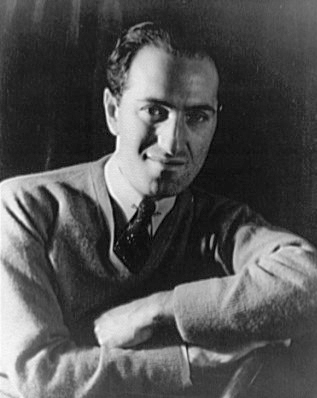
George Gershwin was an American composer and pianist whose compositions spanned popular, jazz and classical genres. Among his best-known works are the orchestral compositions Rhapsody in Blue (1924) and An American in Paris (1928), the songs "Swanee" (1919) and "Fascinating Rhythm" (1924), the jazz standards "Embraceable You" (1928) and "I Got Rhythm" (1930), and the opera Porgy and Bess (1935), which included the hit "Summertime".
Frederick Hemke, American saxophonist and educator (d. 2019) births
Fred Hemke, DMA (né Frederick Leroy Hemke Jr.; July 11, 1935 – April 17, 2019) was an American virtuoso classical saxophonist and influential professor of saxophone at Northwestern University. Hemke helped raise the popularity of classical saxophone, particularly among leading American composers and helped raise the recognition of classical saxophone in solo, chamber, and major orchestral repertoire. For a half century, from 1962 to 2012, Hemke was a full-time faculty music educator at Northwestern University's Bienen School of Music. In 2002, Hemke was named Associate Dean Emeritus of the School of Music. Hemke retired from Northwestern University in 2012. From the start of his career in the early 1960s, building on the achievements of earlier influential American teachers of classical saxophone — including those of Larry Teal, Joseph Allard, Cecil Leeson, Sigurd Raschèr, and Vincent Abato — Hemke, and a handful of peer American saxophonists — including Eugene Rousseau and Donald Sinta — helped build American saxophone repertoire through composers that included Muczynski, Creston, Stein, Heiden, and Karlins. Journalist and author Michael Segell, in his 2005 book, The Devil's Horn, called Hemke "The Dean of Saxophone Education in America." Hemke died on April 17, 2019.
Oliver Napier, Northern Irish lawyer and politician (d. 2011) births

Sir Oliver Napier was the first leader of the Alliance Party of Northern Ireland. In 1974 he served as the first and only Legal Minister and head of the Office of Legal Reform in the Northern Ireland power-sharing executive set up by the Sunningdale Agreement.
Giorgio Armani, Italian fashion designer, founded the Armani Company births
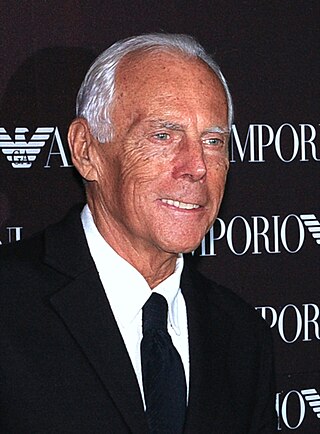
Giorgio Armani is an Italian fashion designer. He first gained notoriety working for Cerruti and then for many others, including Allegri, Bagutta and Hilton. He formed his company, Armani, in 1975, which eventually expanded into music, sport and luxury hotels. By 2001 Armani was acclaimed as the most successful designer of Italian origin, and is credited with pioneering red-carpet fashion. In 2010, he opened the Armani Hotel in Burj Khalifa, the world's tallest building. He is also the richest openly LGBT (bisexual) person in the world. According to Bloomberg Billionaires Index, Armani has an estimated net worth of US$9.53 billion, as of 2021.

Giorgio Armani S.p.A., commonly known as Armani, is an Italian luxury fashion house founded in Milan by Giorgio Armani which designs, manufactures, distributes and retails haute couture, ready-to-wear, leather goods, shoes, accessories, and home interiors. Armani licenses its name and branding to Luxottica for eyewear; L'Oréal for fragrances and cosmetics; and Fossil for watches and jewelry. It is considered Italy's second-biggest fashion group behind Prada.
Jim Carlen, American football player and coach (d. 2012) births

James Anthony Carlen III was an American football player, coach, and college athletics administrator. He served as the head football coach at West Virginia University (1966–1969) and Texas Tech University (1970–1974). He served as both the head football coach and athletic director of the University of South Carolina (1975–1981). Carlen compiled an overall career college football record of 107–69–6.
Frank Kelso, American admiral and politician, United States Secretary of the Navy (d. 2013) births

Frank Benton Kelso II was an admiral of the United States Navy, who served as Chief of Naval Operations from 1990 to 1994.

The secretary of the Navy is a statutory officer and the head of the Department of the Navy, a military department within the United States Department of Defense.
Alex Hassilev, French-born American folk singer and musician births

Alex Hassilev is an American folk musician who was one of the founding members of the group the Limeliters. Educated at Harvard and the University of Chicago, he is an actor with a number of film and television appearances to his credit. As a musician he plays the guitar and the banjo and is fluent in several languages. Although officially retired from the Limeliters, Hassilev remains active in the field of record production.
Jean-Guy Talbot, Canadian ice hockey player and coach births
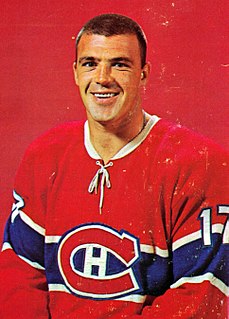
Jean-Guy Talbot is a Canadian former professional ice hockey defenceman and coach.
Dick Gray, American baseball player (d. 2013) births
Richard Benjamin Gray was an American professional baseball player. He was an infielder in Major League Baseball, playing mainly as a third baseman for the Los Angeles Dodgers and St. Louis Cardinals from 1958 through 1960. Listed at 5 feet 11 inches (1.80 m) tall and 165 pounds (75 kg), he batted and threw right handed.
Thurston Harris, American doo-wop singer (d. 1990) births
Thurston Harris was an American singer and songwriter, best known for his 1957 hit "Little Bitty Pretty One".
Tab Hunter, American actor and singer (d. 2018) births

Tab Hunter was an American actor, singer, film producer, and author. Known for his blond, clean-cut good looks, Hunter starred in more than forty films. He was a Hollywood heartthrob of the 1950s and 1960s appearing on the covers of hundreds of film magazines. Hunter's film credits include Battle Cry (1955), The Girl He Left Behind (1956), Gunman's Walk (1958), and Damn Yankees (1958). Hunter also had a music career in the late 1950s; in 1957, he released a number one hit single "Young Love". Hunter's 2005 autobiography, Tab Hunter Confidential: The Making of a Movie Star, was a New York Times bestseller.
Tullio Regge, Italian physicist and academic (d. 2014) births
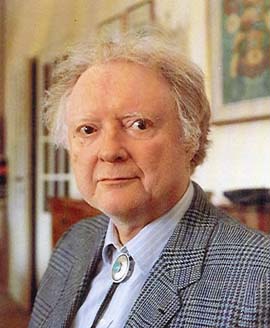
Tullio Eugenio Regge was an Italian theoretical physicist.
Jack Alabaster, New Zealand cricketer births
John Chaloner Alabaster is a former cricketer who played 21 Test matches for New Zealand between 1955 and 1972. A leg-spin bowler, he was the only New Zealander to play in each of the country's first four Test victories. In domestic cricket was often partnered at the crease for his provincial side Otago by his younger brother Gren, who bowled off-spin. A schoolteacher, he later served as Rector of Southland Boys' High School in Invercargill.
Harold Bloom, American literary critic (d. 2019) births

Harold Bloom was an American literary critic and the Sterling Professor of Humanities at Yale University. In 2017, Bloom was described as "probably the most famous literary critic in the English-speaking world." Following the publication of his first book in 1959, Bloom wrote more than 50 books, including over 40 books of literary criticism, several books discussing religion, and a novel. During his lifetime, he edited hundreds of anthologies concerning numerous literary and philosophical figures for the Chelsea House publishing firm. Bloom's books have been translated into more than 40 languages. Bloom was elected to the American Philosophical Society in 1995.
Trevor Storer, English businessman, founded Pukka Pies (d. 2013) births
Trevor Storer was a British businessman and founder of the Pukka Pies company in 1963, which was originally called Trevor Storer's Home Made Pies. He was the author of Bread Salesmanship, which became the training manual for Allied Bakeries in the 1960s. Originally making his pies in his own home, he built the company up until retiring at the age of 65, but remained chairman until his death. As of his time of his death, the company turned over £40 million a year.

Pukka Pies is a manufacturer of pies based in Syston, Leicestershire, England.
Ezra Vogel, American sociologist (d. 2020) births
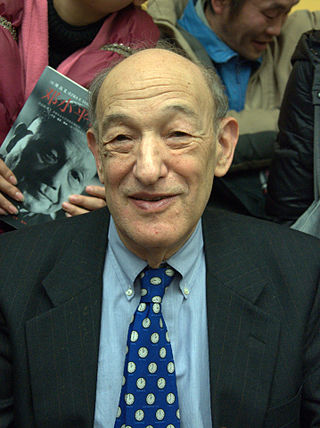
Ezra Feivel Vogel was an American sociologist who wrote prolifically on modern Japan, China, and Korea, and worked both in academia and the public sphere. He was Henry Ford II Professor of the Social Sciences at Harvard University.
Danny Flores, American singer-songwriter and saxophonist (d. 2006) births
Daniel Flores, also known by his stage name Chuck Rio, was an American rock and roll saxophonist. He is best remembered for his self-penned song "Tequila", which he recorded with The Champs, and which reached number one on the Billboard Hot 100.
David Kelly, Irish actor (d. 2012) births

David Kelly was an Irish actor who had regular roles in several film and television works from the 1950s onwards. One of the most recognisable voices and faces of Irish stage and screen, Kelly was known for his roles as Rashers Tierney in Strumpet City, Cousin Enda in Me Mammy, the builder Mr O'Reilly in Fawlty Towers, Albert Riddle in Robin's Nest, and Grandpa Joe in the film Charlie and the Chocolate Factory (2005). Another notable role was as Michael O'Sullivan in Waking Ned.
Billy Mosforth, English footballer and engraver (b. 1857) deaths

William Mosforth was an English footballer who played either as an inside or outside left. Born in Sheffield he played for several Sheffield clubs but the majority of his career was spent at The Wednesday. He later joined Sheffield United, playing in their first season in existence before retiring in 1890. He won nine caps for England between 1877 and 1882, which was a record at the time, scoring three goals for his country.
Greville Janner, Baron Janner of Braunstone, Welsh-English lawyer and politician (d. 2015) births

Greville Ewan Janner, Baron Janner of Braunstone, was a British politician, barrister and writer. He became a Labour Party Member of Parliament for Leicester in the 1970 general election as a last-minute candidate, succeeding his father. He was an MP until 1997, and then elevated to the House of Lords. Never a frontbencher, Janner was particularly known for his work on Select Committees; he chaired the Select Committee on Employment for a time. He was associated with a number of Jewish organisations including the Board of Deputies of British Jews, of which he was chairman from 1978 to 1984, and was later prominent in the field of education about the Holocaust.
Bobo Olson, American boxer (d. 2002) births

Carl Olson was an American boxer. He was the World Middleweight champion between October 1953 and December 1955, the longest reign of any champion in that division during the 1950s. His nickname, Bobo, was based on his younger sister's mispronunciation of "brother".
Andrea Veneracion, Filipina choirmaster (d. 2014) births
Andrea Ofilada Veneracion was a Filipino choral conductor and a recipient of the 1999 National Artist for Music award. She founded the Philippine Madrigal Singers in 1963. She was also an adjudicator in numerous international choral competitions and was an active force in choral music before her massive stroke in 2005.
Theodore Maiman, American-Canadian physicist and engineer (d. 2007) births

Theodore Harold Maiman was an American engineer and physicist who is widely credited with the invention of the laser. Maiman's laser led to the subsequent development of many other types of lasers. The laser was successfully fired on May 16, 1960. In a July 7, 1960 press conference in Manhattan, Maiman and his employer, Hughes Aircraft Company, announced the laser to the world. Maiman was granted a patent for his invention, and he received many awards and honors for his work. His experiences in developing the first laser and subsequent related events are recounted in his book, The Laser Odyssey, republished recently under a new title The Laser Inventor: Memoirs of Theodore H. Maiman.
Chris Leonard, English footballer (d. 1987) births
Christopher Leonard was an English footballer who made 26 appearances in the Football League playing as a centre half for Darlington in the 1950s. He also played non-league football for South Shields. He died in Wearhead, County Durham in 1987.
Frederick Buechner, American minister, theologian, and author (d. 2022) births

Carl Frederick Buechner was an American author, Presbyterian minister, preacher, and theologian. The author of thirty-nine published books, his work encompassed different genres, including fiction, autobiography, essays and sermons, and his career spanned more than six decades. He was best known for his novels, including A Long Day's Dying, The Book of Bebb, Godric, and Brendan, his memoirs, including The Sacred Journey and Telling Secrets, and his theological works, such as Secrets in the Dark, The Magnificent Defeat, and Telling the Truth.
Charles Chaynes, French composer (d. 2016) births
Charles Augustin Chaynes was a French composer.
Nicolai Gedda, Swedish operatic tenor (d. 2017) births

Harry Gustaf Nikolai Gädda, known professionally as Nicolai Gedda, was a Swedish operatic tenor. Debuting in 1951, Gedda had a long and successful career in opera until the age of 77 in June 2003, when he made his final operatic recording. Skilled at languages, he performed operas in French, Russian, German, Italian, English, Czech and Swedish, as well as one in Latin. In January 1958, he created the part of Anatol in the world premiere of the American opera Vanessa at the Metropolitan Opera. Having made some two hundred recordings, Gedda is one of the most widely recorded opera singers in history. His singing is best known for its beauty of tone, vocal control, and musical perception.
Peter Kyros, American lawyer and politician (d. 2012) births
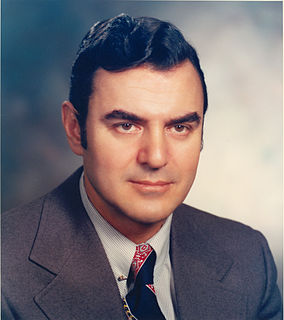
Peter Nicholas Kyros was a Democratic U.S. Representative from Maine from 1967 to 1975.
Sid Smith, Canadian ice hockey player and coach (d. 2004) births

Sidney James Smith was a National Hockey League left winger who played with the Toronto Maple Leafs for 12 seasons. He was the Leafs team captain from 1955 to 1956.
César Lattes, Brazilian physicist and academic (d. 2005) births

Cesare Mansueto Giulio Lattes, also known as César Lattes, was a Brazilian experimental physicist, one of the discoverers of the pion, a composite subatomic particle made of a quark and an antiquark.
Brett Somers, Canadian-American actress and singer (d. 2007) births

Brett Somers was a Canadian-American game-show personality, actress, and singer. Brett was best known as a panelist on the 1970s game show Match Game and for her recurring role as Blanche Madison opposite her real-life husband, actor Jack Klugman, on The Odd Couple.
Charlie Tully, Northern Irish footballer and manager (d. 1971) births
Charles Patrick Tully was a Northern Irish football player and manager who played for Celtic.
Oscar Wyatt, American businessman births
Oscar Sherman Wyatt, Jr. is an American businessman and self made millionaire. He was the founder of Coastal Corporation and a decorated bomber pilot in World War II. In 2007 the U.S. federal court in Manhattan tried him for illegally sending payments to Iraq under the Oil-for-Food Program.
Richard Pipes, Polish-American historian and academic (d. 2018) births

Richard Edgar Pipes was an American academic who specialized in Russian and Soviet history. He published several books critical of communist regimes throughout his career. In 1976, he headed Team B, a team of analysts organized by the Central Intelligence Agency (CIA) who analyzed the strategic capacities and goals of the Soviet military and political leadership. Pipes was the father of American historian Daniel Pipes.
Tun Tun, Indian actress and comedian (d. 2003) births
Tun Tun was the screen name of Indian playback singer and actress-comedienne, Uma Devi Khatri, who was called "Hindi cinema's first-ever comedienne".
Gene Evans, American actor (d. 1998) births

Eugene Barton Evans was an American actor who appeared in numerous television series, television films, and feature films between 1947 and 1989.
Fritz Riess, German-Swiss racing driver (d. 1991) births

Fritz Riess or Rieß was a racing driver from Germany. He participated in one Formula One World Championship Grand Prix, on 3 August 1952. He finished seventh, scoring no championship points as only the first five finishers scored points at that time.
Yul Brynner, Russian actor and dancer (d. 1985) births

Yuliy Borisovich Briner, known professionally as Yul Brynner, was a Russian-born actor. He was best known for his portrayal of King Mongkut in the Rodgers and Hammerstein stage musical The King and I, for which he won two Tony Awards, and later an Academy Award for Best Actor for the film adaptation. He played the role 4,625 times on stage and became known for his shaved head, which he maintained as a personal trademark long after adopting it for The King and I. Considered one of the first Russian-American film stars, he was honored with a ceremony to put his handprints in front of Grauman's Chinese Theatre in Hollywood in 1956, and also received a star on the Hollywood Walk of Fame in 1960.
Zecharia Sitchin, Russian-American author (d. 2010) births
Zecharia Sitchin was an author of a number of books proposing an explanation for human origins involving ancient astronauts. Sitchin attributed the creation of the ancient Sumerian culture to the Anunnaki, which he stated was a race of extraterrestrials from a planet beyond Neptune called Nibiru. He asserted that Sumerian mythology suggests that this hypothetical planet of Nibiru is in an elongated, 3,600-year-long elliptical orbit around the Sun. Sitchin's books have sold millions of copies worldwide and have been translated into more than 25 languages.
Venetia Burney, English educator, who named Pluto (d. 2009) births

Venetia Katharine Douglas Burney was an English accountant and teacher. She is remembered as the first person to suggest the name Pluto for the dwarf planet discovered by Clyde Tombaugh in 1930. At the time, she was 11 years old.

Pluto is a dwarf planet in the Kuiper belt, a ring of bodies beyond the orbit of Neptune. It is the ninth-largest and tenth-most-massive known object to directly orbit the Sun. It is the largest known trans-Neptunian object by volume, by a small margin, but is slightly less massive than Eris. Like other Kuiper belt objects, Pluto is made primarily of ice and rock and is much smaller than the inner planets. Compared to Earth's moon, Pluto has only one sixth its mass and one third its volume.
Mortimer Caplin, American tax attorney, educator, and IRS Commissioner (d. 2019) births

Mortimer Maxwell Caplin was an American lawyer and educator, and the founding member of Caplin & Drysdale, Chartered.
Hans Maier, Dutch water polo player (d. 2018) births
Hans Maier was a Dutch water polo player who competed in the 1936 Summer Olympics. Born in Madioen, Dutch East Indies, he was part of the Dutch team which finished fifth in the 1936 tournament, playing in all seven matches. He died in November 2018 at the age of 102.
Alexander Prokhorov, Australian-Russian physicist and academic, Nobel Prize laureate (d. 2002) births

Alexander Mikhailovich Prokhorov was an Australian-born Soviet-Russian physicist known for his pioneering research on lasers and masers in the Soviet Union for which he shared the Nobel Prize in Physics in 1964 with Charles Hard Townes and Nikolay Basov.

The Nobel Prize in Physics is a yearly award given by the Royal Swedish Academy of Sciences for those who have made the most outstanding contributions for humankind in the field of physics. It is one of the five Nobel Prizes established by the will of Alfred Nobel in 1895 and awarded since 1901, the others being the Nobel Prize in Chemistry, Nobel Prize in Literature, Nobel Peace Prize, and Nobel Prize in Physiology or Medicine. Physics is traditionally the first award presented in the Nobel Prize ceremony.
Reg Varney, English actor and screenwriter (d. 2008) births

Reginald Alfred Varney was an English actor, entertainer and comedian. He is best remembered for having played the lead role of bus driver Stan Butler in the LWT sitcom On the Buses (1969–73) and its three spin-off feature films. Having performed as a music hall entertainer, Varney first came to national recognition as factory foreman Reg Turner in the BBC sitcom The Rag Trade (1961–63). He appeared in further sitcoms including Beggar My Neighbour (1966–1968) and On the Buses stardom facililated overseas cabaret tours.
Gough Whitlam, Australian lieutenant, lawyer, and politician, 21st Prime Minister of Australia (d. 2014) births

Edward Gough Whitlam was the 21st prime minister of Australia, in office from 1972 to 1975. The longest-serving federal leader of the Australian Labor Party (ALP), he was the head of a reformist administration that ended with his removal as prime minister after controversially being dismissed by the governor-general of Australia, Sir John Kerr, at the climax of the 1975 Australian constitutional crisis. Whitlam is the only Australian prime minister to have been removed from office in this manner.

The prime minister of Australia is the head of government of the Commonwealth of Australia. The prime minister heads the executive branch of the federal government of Australia and is also accountable to federal parliament under the principles of responsible government. The current prime minister is Anthony Albanese of the Australian Labor Party, who became prime minister on 23 May 2022.
Paul Gibb, English cricketer (d. 1977) births
Paul Antony Gibb was an English cricketer, who played in eight Tests for England from 1938 to 1946. He played first-class cricket for Cambridge University, Yorkshire and Essex, as a right-handed opening or middle order batsman and also kept wicket in many matches.
Cordwainer Smith, American sinologist, author, and academic (d. 1966) births

Paul Myron Anthony Linebarger, better known by his pen-name Cordwainer Smith, was an American author known for his science fiction works. Linebarger was a US Army officer, a noted East Asia scholar, and an expert in psychological warfare. Although his career as a writer was shortened by his death at the age of 53, he is considered one of the more talented and influential science fiction authors.
Sergiu Celibidache, Romanian conductor and composer (d. 1996) births
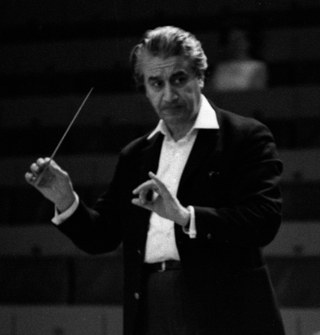
Sergiu Celibidache was a Romanian conductor, composer, musical theorist, and teacher. Educated in his native Romania, and later in Paris and Berlin, Celibidache's career in music spanned over five decades, including tenures as principal conductor of the Munich Philharmonic, Berlin Philharmonic, Sicilian Symphony Orchestra and several other European orchestras. Later in life, he taught at Mainz University in Germany and the Curtis Institute of Music in Philadelphia, Pennsylvania.
Peta Taylor, English cricketer (d. 1989) births
Mary Isabella "Peta" Taylor, married name Mary Jager, was an English cricketer who played as a right-arm medium bowler. She appeared in seven Test matches for England between 1934 and 1937, including the first ever women's Test match. She played domestic cricket for various composite XIs, as well as South Women.
William F. Walsh, American captain and politician, 48th Mayor of Syracuse (d. 2011) births
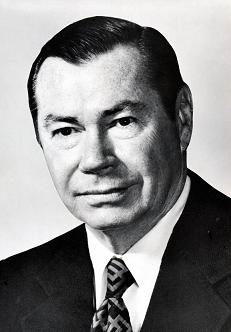
William Francis Walsh was a Republican-Conservative member of the United States House of Representatives from New York State.

This is a complete list of mayors of Syracuse, New York.
Erna Flegel, German nurse who was still present in the Führerbunker when it was captured by Soviet troops (d. 2006) births
Erna Flegel was a German nurse. In late April 1945 she worked at the emergency casualty station at the Reich Chancellery in Berlin, and was one of the final occupants of the Führerbunker before she was captured by the Red Army on 2 May 1945.
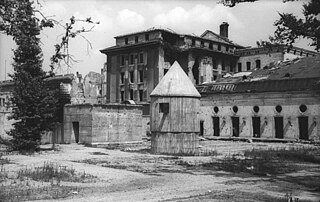
The Führerbunker was an air raid shelter located near the Reich Chancellery in Berlin, Germany. It was part of a subterranean bunker complex constructed in two phases in 1936 and 1944. It was the last of the Führer Headquarters (Führerhauptquartiere) used by Adolf Hitler during World War II.
Sally Blane, American actress (d. 1997) births

Sally Blane was an American actress who appeared in over 100 movies.
Irene Hervey, American actress (d. 1998) births

Irene Hervey was an American film, stage, and television actress who appeared in over fifty films and numerous television series spanning her five-decade career.
Jacques Clemens, Dutch catholic priest (d. 2018) births
Jacques Clemens was a Dutch Catholic priest. He was the parish priest of The Bultia from 1958. Between 2016 and his death on 7 March 2018 at the age of 108 he was thought to be the oldest living priest.
Simon Newcomb, Canadian-American astronomer and mathematician (b. 1835) deaths

Simon Newcomb was a Canadian–American astronomer, applied mathematician, and autodidactic polymath. He served as Professor of Mathematics in the United States Navy and at Johns Hopkins University. Born in Nova Scotia, at the age of 19 Newcomb left an apprenticeship to join his father in Massachusetts, where the latter was teaching.
Friedrich Traun, German sprinter and tennis player (b. 1876) deaths

Friedrich Adolf "Fritz" Traun was a German athlete and tennis player. Born into a wealthy family, he participated in the 1896 Summer Olympics and won a gold medal in men's doubles. He committed suicide after being accused of fathering a child out of wedlock.
Harry von Zell, American actor and announcer (d. 1981) births

Harry Rudolph von Zell was an American announcer of radio programs, and an actor in films and television shows. He is best remembered for his work on The George Burns and Gracie Allen Show.
Herbert Wehner, German politician, Minister of Intra-German Relations (d. 1990) births

Herbert Richard Wehner was a German politician. A former member of the Communist Party, he joined the Social Democrats (SPD) after World War II. He served as Federal Minister of Intra-German Relations from 1966 to 1969 and thereafter as chairman of the SPD parliamentary group in the Bundestag until 1983.

The Federal Minister of Intra-German Relations was a federal cabinet minister of the Federal Republic of Germany. The office was created under the title of Federal Minister of All-German Affairs in 1949, being also in charge of the German lands east of the Oder–Neisse line which had been put under Polish or Soviet administration. In 1951, the first Minister of All-German Affairs Jakob Kaiser openly raised claim to even greater territories including Austria, parts of Switzerland, the Saar area and Alsace-Lorraine.
Betty Allan, Australian statistician and biometrician (d. 1952) births
Frances Elizabeth Allan (1905–1952) was an Australian statistician. She was known as the first statistician at the Commonwealth Scientific and Industrial Research Organisation (CSIRO), as "the effective founder of the CSIRO Division of Mathematics and Statistics", and for her advocacy of biometrics.
Biostatistics are the development and application of statistical methods to a wide range of topics in biology. It encompasses the design of biological experiments, the collection and analysis of data from those experiments and the interpretation of the results.
Muhammad Abduh, Egyptian jurist and scholar (b. 1849) deaths
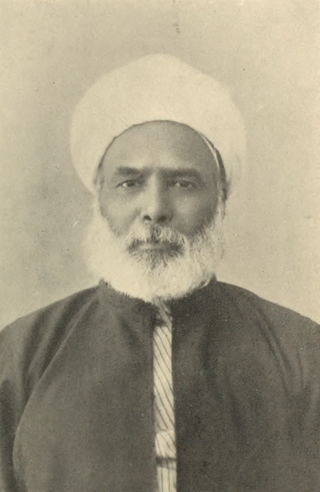
Muḥammad ʿAbduh was an Egyptian Islamic scholar, journalist, teacher, author, editor, judge, and Grand Mufti of Egypt. He was a central figure of the Arab Nahḍa and Islamic Modernism in the late 19th and early 20th centuries.
Niño Ricardo, Spanish guitarist and composer (d. 1972) births

Manuel Serrapí Sánchez, better known as Niño Ricardo, was a Flamenco composer, considered by some sources as the most accomplished flamenco player of his day. He played a significant part in the evolution of the flamenco guitar. He lived in the city center of Sevilla. A child guitar prodigy, his early audiences referred to him as the son of Ricardo, leading to his stage-name Niño [de] Ricardo.
Rudolf Abel, English-Russian colonel (d. 1971) births

Rudolf Ivanovich Abel, real name William August Fisher, was a Soviet intelligence officer. He adopted his alias when arrested on charges of conspiracy by the FBI in 1957.
Sidney Franklin, American bullfighter (d. 1976) births

Sidney Franklin was the first American to become a successful matador, the most senior level of bullfighter.
Gwendolyn Lizarraga, Belizean businesswoman, activist, and politician (d. 1975) births

Gwendolyn Margaret Lizarraga, MBE commonly known as Madam Liz, was a Belizean businesswoman, women's rights activist and politician. She was the first woman elected to the British Honduras Legislative Assembly and the first woman to serve as a government minister in British Honduras, now Belize.
Wilfrid Israel, German businessman and philanthropist (d. 1943) births

Wilfrid Berthold Jacob Israel was an Anglo-German businessman and philanthropist, born into a wealthy Anglo-German Jewish family, who was active in the rescue of Jews from Nazi Germany, and who played a significant role in the Kindertransport.
E. B. White, American essayist and journalist (d. 1985) births

Elwyn Brooks White was an American writer. He was the author of several highly popular books for children, including Stuart Little (1945), Charlotte's Web (1952), and The Trumpet of the Swan (1970). In a 2012 survey of School Library Journal readers, Charlotte's Web came in first in their poll of the top one hundred children's novels. In addition, he was a writer and contributing editor to The New Yorker magazine, and also a co-author of the English language style guide The Elements of Style.
Bull Connor, American police officer (d. 1973) births

Theophilus Eugene "Bull" Connor was an American politician who served as Commissioner of Public Safety for the city of Birmingham, Alabama, for more than two decades. A member of the Democratic Party, he strongly opposed the Civil Rights Movement in the 1960s. Under the city commission government, Connor had responsibility for administrative oversight of the Birmingham Fire Department and the Birmingham Police Department, which also had their own chiefs.
Patrick Jennings, Irish-Australian politician, 11th Premier of New South Wales (b. 1831) deaths

Sir Patrick Alfred Jennings, was an Irish-Australian politician and Premier of New South Wales.

The premier of New South Wales is the head of government in the state of New South Wales, Australia. The Government of New South Wales follows the Westminster Parliamentary System, with a Parliament of New South Wales acting as the legislature. The premier is appointed by the governor of New South Wales, and by modern convention holds office by his or her ability to command the support of a majority of members of the lower house of Parliament, the Legislative Assembly.
Dorothy Wilde, English author and poet (d. 1941) births

Dorothy Ierne Wilde, known as Dolly Wilde, was an English socialite, made famous by her family connections and her reputation as a witty conversationalist. Her charm and humour made her a popular guest at salons in Paris between the wars, standing out even in a social circle known for its flamboyant talkers.
Erna Mohr, German zoologist (d. 1968) births

Erna W. Mohr was a German zoologist who made contributions to ichthyology and mammalogy. Mohr was long associated with the Zoological Museum Hamburg, where she was successively head of the Fish Biology Department, Department of Higher Vertebrates, and Curator of the Vertebrate Department. She was a member of the Academy of Sciences Leopoldina and held an honorary doctorate from the University of Munich.
Thomas Mitchell, American actor, singer, and screenwriter (d. 1962) births

Thomas John Mitchell was an American actor and writer. Among his most famous roles in a long career are those of Gerald O'Hara in Gone with the Wind, Doc Boone in Stagecoach, Uncle Billy in It's a Wonderful Life, Pat Garrett in The Outlaw, and Mayor Jonas Henderson in High Noon. Mitchell was the first male actor to gain the Triple Crown of Acting by winning an Oscar, an Emmy, and a Tony Award.
Carl Schmitt, German philosopher and jurist (d. 1985) births
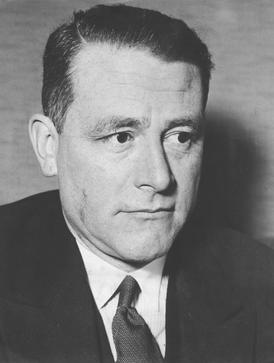
Carl Schmitt was a German jurist, political theorist, and prominent member of the Nazi Party. Schmitt wrote extensively about the effective wielding of political power. A conservative theorist, he is noted as a critic of parliamentary democracy, liberalism, and cosmopolitanism, and his work has been a major influence on subsequent political theory, legal theory, continental philosophy, and political theology, but its value and significance are controversial, mainly due to his intellectual support for and active involvement with Nazism. Schmitt's work has attracted the attention of numerous philosophers and political theorists, including Giorgio Agamben, Hannah Arendt, Walter Benjamin, Susan Buck-Morss, Jacques Derrida, Waldemar Gurian, Carlo Galli, Jaime Guzmán, Jürgen Habermas, Friedrich Hayek, Reinhart Koselleck, Chantal Mouffe, Antonio Negri, Leo Strauss, Adrian Vermeule, and Slavoj Žižek, among others.
Boris Grigoriev, Russian painter and illustrator (d. 1939) births

Boris Grigoriev was a painter, graphic artist, and writer.
James Larkin White, American miner, explorer, and park ranger (d. 1946) births
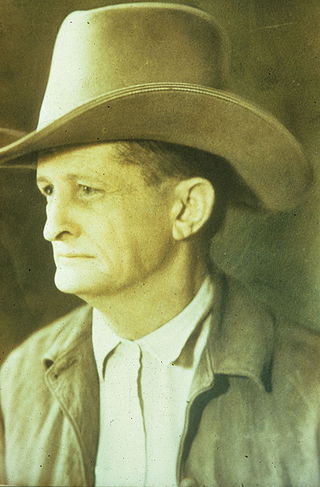
James Larkin White, better known as Jim White, was a cowboy, guano miner, cave explorer, and park ranger for the National Park Service. He is best remembered as the discoverer, early promoter and explorer of what is known today as Carlsbad Caverns in Carlsbad Caverns National Park, New Mexico.
Isabel Martin Lewis, American astronomer and author (d. 1966) births

Isabel Martin Lewis was an American astronomer who was the first woman hired by the United States Naval Observatory as assistant astronomer. In 1918, Lewis was elected a member of the American Astronomical Society. She was also a member of the Royal Astronomical Society of Canada and the Astronomical Society of the Pacific.
Friedrich Lahrs, German architect and academic (d. 1964) births
Johann Ludwig Friedrich Lahrs was a German architect and professor.
H. M. Brock, British painter and illustrator (d. 1960) births

Henry Matthew Brock was a British illustrator and landscape painter of the late nineteenth and early twentieth century. He was one of four artist brothers, all of them illustrators, who worked together in their family studio in Cambridge.
Princess Irene of Hesse and by Rhine (d. 1953) births

Princess Irene Luise Marie Anne of Hesse and by Rhine was the third child and third daughter of Princess Alice of the United Kingdom and Louis IV, Grand Duke of Hesse and by Rhine. Her maternal grandparents were Queen Victoria and Prince Albert of Saxe-Coburg and Gotha. Her paternal grandparents were Prince Charles of Hesse and by Rhine and Princess Elisabeth of Prussia. She was the wife of Prince Henry of Prussia, a younger brother of Wilhelm II, German Emperor and her first cousin. The SS Prinzessin Irene, a liner of the North German Lloyd was named after her.
Annie Armstrong, American missionary (d. 1938) births

Annie Walker Armstrong was a lay Southern Baptist denominational leader instrumental in the founding of the Woman's Missionary Union.
N. E. Brown, English plant taxonomist and authority on succulents (d. 1934) births
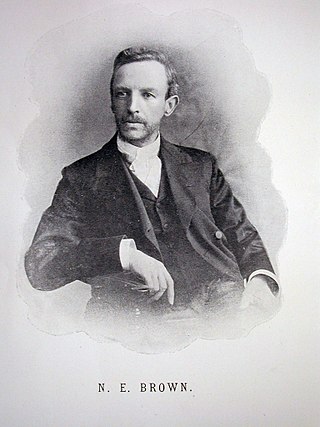
Nicholas Edward Brown was an English plant taxonomist and authority on succulents. He was also an authority on several families of plants, including Asclepiadaceae, Aizoaceae, Labiatae and Cape plants.
Léon Bloy, French author and poet (d. 1917) births
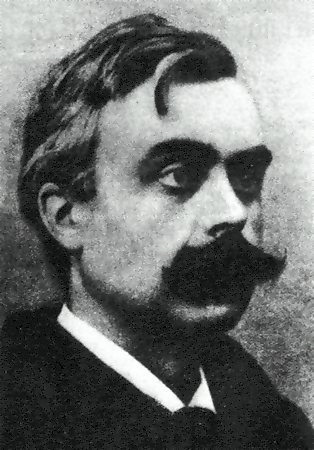
Léon Bloy was a French Catholic novelist, essayist, pamphleteer, and satirist, known additionally for his eventual defense of Catholicism and for his influence within French Catholic circles.
Yevgeny Baratynsky, Russian philosopher and poet (b. 1800) deaths

Yevgeny Abramovich Baratynsky was lauded by Alexander Pushkin as the finest Russian elegiac poet. After a long period when his reputation was on the wane, Baratynsky was rediscovered by Russian Symbolism poets as a supreme poet of thought.
Antônio Carlos Gomes, Brazilian composer (d. 1896) births

Antônio Carlos Gomes was the first New World composer whose work was accepted by Europe. He was the only non-European who was successful as an opera composer in Italy, during the "golden age of opera", contemporary to Verdi and Puccini and the first composer of non-European lineage to be accepted into the Classic tradition of music.
James Abbott McNeill Whistler, American-English painter and illustrator (d. 1903) births
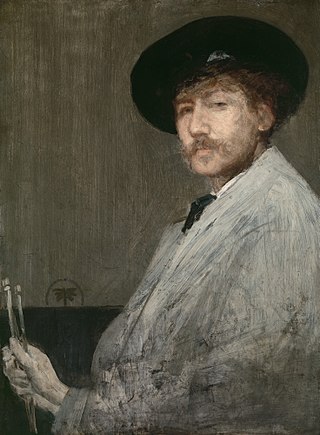
James Abbott McNeill Whistler was an American painter active during the American Gilded Age and based primarily in the United Kingdom. He eschewed sentimentality and moral allusion in painting and was a leading proponent of the credo "art for art's sake". His signature for his paintings took the shape of a stylized butterfly possessing a long stinger for a tail. The symbol combined both aspects of his personality: his art is marked by a subtle delicacy, while his public persona was combative. He found a parallel between painting and music, and entitled many of his paintings "arrangements", "harmonies", and "nocturnes", emphasizing the primacy of tonal harmony. His most famous painting, Arrangement in Grey and Black No. 1 (1871), commonly known as Whistler's Mother, is a revered and often parodied portrait of motherhood. Whistler influenced the art world and the broader culture of his time with his theories and his friendships with other leading artists and writers.
Charilaos Trikoupis, Greek lawyer and politician, 55th Prime Minister of Greece (d. 1896) births

Charilaos Trikoupis was a Greek politician who served as a Prime Minister of Greece seven times from 1875 until 1895.

The prime minister of the Hellenic Republic, colloquially referred to as the prime minister of Greece, is the head of government of the Hellenic Republic and the leader of the Greek Cabinet. The incumbent prime minister is Kyriakos Mitsotakis, who took office on 8 July 2019 from Alexis Tsipras.
Alexander Afanasyev, Russian ethnographer and author (d. 1871) births
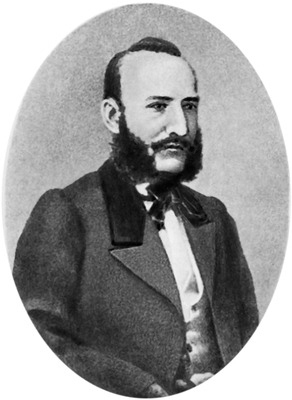
Alexander Nikolayevich Afanasyev was a Russian Slavist and ethnographer who published nearly 600 Russian fairy and folk tales, one of the largest collections of folklore in the world. The first edition of his collection was published in eight volumes from 1855 to 1867, earning him the reputation as being the Russian counterpart to the Brothers Grimm.
Thomas P. Grosvenor, American soldier and politician (b. 1744) deaths
Thomas Peabody Grosvenor was a United States representative from New York.
James Smith, Irish-American lawyer and politician (b. 1719) deaths
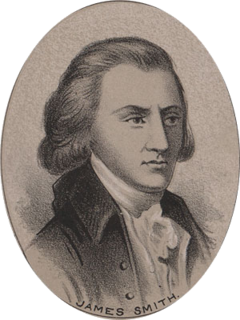
James Smith, a Founding Father of the United States, was an Irish/American lawyer and a signer to the United States Declaration of Independence as a representative of Pennsylvania.
Ienăchiță Văcărescu, Romanian historian and philologist (b. 1740) deaths
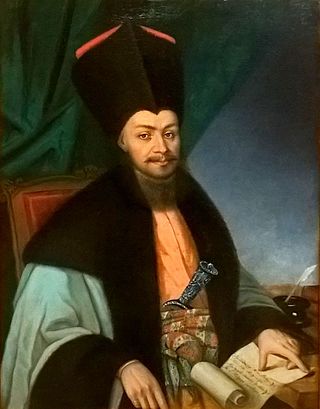
Ienăchiță Văcărescu was a Wallachian Romanian poet, historian, philologist, and boyar belonging to the Văcărescu family. A polyglot, he was able to speak Ancient and Modern Greek, Old Church Slavonic, Arabic, Persian, French, German, Italian, and Ottoman Turkish.
Simon Boerum, American farmer and politician (b. 1724) deaths
Simon Boerum was a farmer, miller, and political leader from Brooklyn, New York. He represented New York in the Continental Congress in 1774 and 1775. He signed the Continental Association.
Sir William Johnson, 1st Baronet, Irish-English general (b. 1715) deaths

Sir William Johnson, 1st Baronet of New York, was a British Army officer and colonial administrator from Ireland. As a young man, Johnson moved to the Province of New York to manage an estate purchased by his uncle, Royal Navy officer Peter Warren, which was located in territory of the Mohawk, one of the Six Nations of the Iroquois League, or Haudenosaunee. Johnson learned the Mohawk language and Iroquois customs, and was appointed the British agent to the Iroquois. Because of his success, he was appointed in 1756 as British Superintendent of Indian Affairs for all the northern colonies. Throughout his career as a British official among the Iroquois, Johnson combined personal business with official diplomacy, acquiring tens of thousands of acres of Native land and becoming very wealthy.
John Quincy Adams, American lawyer and politician, 6th President of the United States (d. 1848) births

John Quincy Adams was an American statesman, diplomat, lawyer, and diarist who served as the sixth president of the United States, from 1825 to 1829. He previously served as the eighth United States Secretary of State from 1817 to 1825. During his long diplomatic and political career, Adams also served as an ambassador, and as a member of the United States Congress representing Massachusetts in both chambers. He was the eldest son of John Adams, who served as the second president of the United States from 1797 to 1801, and First Lady Abigail Adams. Initially a Federalist like his father, he won election to the presidency as a member of the Democratic-Republican Party, and in the mid-1830s became affiliated with the Whig Party.

The president of the United States (POTUS) is the head of state and head of government of the United States of America. The president directs the executive branch of the federal government and is the commander-in-chief of the United States Armed Forces.
Peggy Shippen, American wife of Benedict Arnold and American Revolutionary War spy (d. 1804) births

Margaret "Peggy" Shippen was the highest-paid spy in the American Revolution, and was the second wife of General Benedict Arnold.

Benedict Arnold was an American military officer who served during the Revolutionary War. He fought with distinction for the American Continental Army and rose to the rank of major general before defecting to the British side of the conflict in 1780. General George Washington had given him his fullest trust and had placed him in command of West Point in New York. Arnold was planning to surrender the fort there to British forces, but the plot was discovered in September 1780, whereupon he fled to the British lines. In the later part of the conflict, Arnold was commissioned as a brigadier general in the British Army, and placed in command of the American Legion. He led the British army in battle against the soldiers whom he had once commanded, after which his name became synonymous with treason and betrayal in the United States.

The American Revolutionary War, also known as the Revolutionary War or American War of Independence, secured American independence from Great Britain. Fighting began on April 19, 1775, followed by the Lee Resolution on July 2, 1776, and the Declaration of Independence on July 4, 1776. The American Patriots were supported by the Kingdom of France and, to a lesser extent, the Dutch Republic and the Spanish Empire, in a conflict taking place in North America, the Caribbean, and the Atlantic Ocean.
Espionage, spying, or intelligence gathering is the act of obtaining secret or confidential information (intelligence) from non-disclosed sources or divulging of the same without the permission of the holder of the information for a tangible benefit. A person who commits espionage is called an espionage agent or spy. Any individual or spy ring, in the service of a government, company, criminal organization, or independent operation, can commit espionage. The practice is clandestine, as it is by definition unwelcome. In some circumstances, it may be a legal tool of law enforcement and in others, it may be illegal and punishable by law.
Thomas Bowdler, English physician and philanthropist (d. 1825) births

Thomas Bowdler, LRCP, FRS was an English physician known for publishing The Family Shakespeare, an expurgated edition of William Shakespeare's plays edited by his sister Henrietta Maria Bowdler. They sought a version they saw as more appropriate than the original for 19th-century women and children. Bowdler also published works reflecting an interested knowledge of continental Europe. His last work was an expurgation of Edward Gibbon's Decline and Fall of the Roman Empire, published posthumously in 1826 under the supervision of his nephew and biographer, Thomas Bowdler the Younger. The term bowdlerise or bowdlerize links the name with expurgation or omission of elements deemed unsuited to children, in literature and films and on television.
Jean-François Marmontel, French historian and author (d. 1799) births
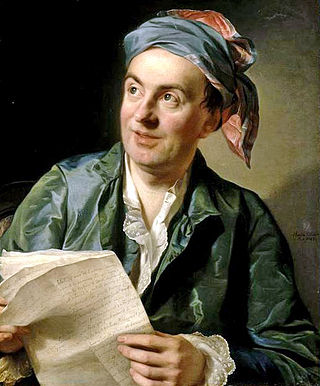
Jean-François Marmontel was a French historian, writer and a member of the Encyclopédistes movement.
Johan Gottschalk Wallerius, Swedish chemist and mineralogist (d. 1785) births

Johan Gottschalk Wallerius was a Swedish chemist and mineralogist.
Narai, Thai king (b. 1629) deaths

King Narai the Great or Ramathibodi III was the 27th monarch of Ayutthaya Kingdom, the 4th and last monarch of the Prasat Thong dynasty. He was the king of Ayutthaya Kingdom from 1656 to 1688 and arguably the most famous king of the Prasat Thong dynasty.
Maximilian II Emanuel, Elector of Bavaria (d. 1726) births
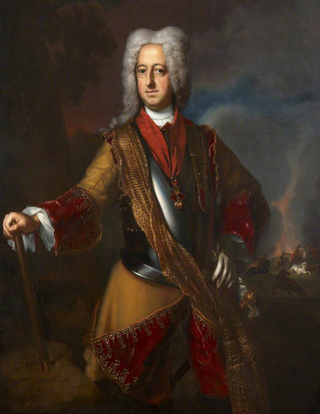
Maximilian II, also known as Max Emanuel or Maximilian Emanuel, was a Wittelsbach ruler of Bavaria and a Prince-elector of the Holy Roman Empire. He was also the last governor of the Spanish Netherlands and Duke of Luxembourg. An able soldier, his ambition led to conflicts that limited his ultimate dynastic achievements.
Frederick I of Prussia (d. 1713) births

Frederick I, of the Hohenzollern dynasty, was Elector of Brandenburg (1688–1713) and Duke of Prussia in personal union (Brandenburg-Prussia). The latter function he upgraded to royalty, becoming the first King in Prussia (1701–1713). From 1707 he was in personal union the sovereign prince of the Principality of Neuchâtel.
Sarah Good, American woman accused of witchcraft (d. 1692) births

Sarah Good was one of the first three women to be accused of witchcraft in the Salem witch trials, which occurred in 1692 in colonial Massachusetts.

Witchcraft traditionally means the use of magic or supernatural powers to harm others. A practitioner is a witch. In medieval and early modern Europe, where the term originated, accused witches were usually women who were believed to have attacked their own community, and often to have communed with evil beings. It was thought witchcraft could be thwarted by protective magic or counter-magic, which could be provided by cunning folk or folk healers. Suspected witches were also intimidated, banished, attacked or killed. Often they would be formally prosecuted and punished, if found guilty or simply believed to be guilty. European witch-hunts and witch trials in the early modern period led to tens of thousands of executions. In some regions, many of those accused of witchcraft were folk healers or midwives. European belief in witchcraft gradually dwindled during and after the Age of Enlightenment.
Tokugawa Mitsukuni, Japanese daimyō (d. 1701) births
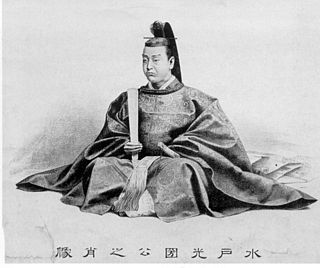
Tokugawa Mitsukuni also known as Mito Kōmon (水戸黄門) was a prominent daimyo who was known for his influence in the politics of the early Edo period. He was the third son of Tokugawa Yorifusa and succeeded him, becoming the second daimyo of the Mito Domain.
Kenelm Digby, English astrologer, courtier, and diplomat (d. 1665) births

Sir Kenelm Digby was an English courtier and diplomat. He was also a highly reputed natural philosopher, astrologer and known as a leading Roman Catholic intellectual and Blackloist. For his versatility, he is described in John Pointer's Oxoniensis Academia (1749) as the "Magazine of all Arts and Sciences, or the Ornament of this Nation".
Chōsokabe Motochika, Japanese daimyō (b.1539) deaths
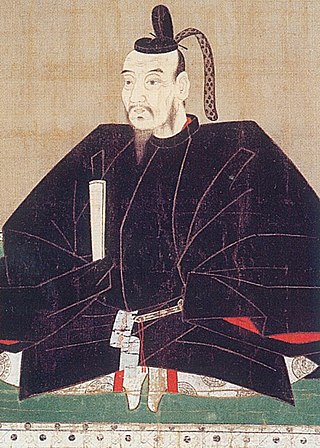
Chōsokabe Motochika was a prominent daimyō in Japanese Sengoku-period. He was the 21st chief of the Chōsokabe clan of Tosa Province, the ruler of Shikoku region.
Giuseppe Arcimboldo, Italian painter (b. 1527) deaths

Giuseppe Arcimboldo was an Italian painter best known for creating imaginative portrait heads made entirely of objects such as fruits, vegetables, flowers, fish and books.
Peder Skram, Danish admiral and politician (b. 1503) deaths

Peder Skram was a Danish Admiral and naval hero.
Luis de Góngora, Spanish cleric and poet (d. 1627) births

Luis de Góngora y Argote was a Spanish Baroque lyric poet and a Catholic priest. Góngora and his lifelong rival, Francisco de Quevedo, are widely considered the most prominent Spanish poets of all time. His style is characterized by what was called culteranismo, also known as Gongorismo. This style existed in stark contrast to Quevedo's conceptismo.
Robert Greene, English author and playwright (d. 1592) births
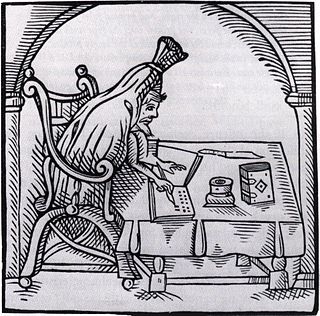
Robert Greene (1558–1592) was an English author popular in his day, and now best known for a posthumous pamphlet attributed to him, Greene's Groats-Worth of Witte, bought with a million of Repentance, widely believed to contain an attack on William Shakespeare. Robert Greene was a popular Elizabethan dramatist and pamphleteer known for his negative critiques of his colleagues. He is said to have been born in Norwich. He attended Cambridge where he received a BA in 1580, and an M.A. in 1583 before moving to London, where he arguably became the first professional author in England. Greene was prolific and published in many genres including romances, plays and autobiography.
Joachim I Nestor, Elector of Brandenburg (b. 1484) deaths

Joachim I Nestor was a Prince-elector of the Margraviate of Brandenburg (1499–1535), the fifth member of the House of Hohenzollern. His nickname was taken from King Nestor of Greek mythology.
Mino da Fiesole, Italian sculptor (b. c. 1429) deaths

Mino da Fiesole, also known as Mino di Giovanni, was an Italian Renaissance sculptor from Poppi, Tuscany. He is noted for his portrait busts.
Kaspar, Count Palatine of Zweibrücken, German nobleman (d. 1527) births
Kaspar, Count Palatine of Zweibrücken and Veldenz was Duke of Zweibrücken from 1489 to 1490.
Barbara of Cilli, Slovenian noblewoman deaths

Barbara of Cilli or Barbara of Celje, was the Holy Roman Empress and Queen of Hungary and Bohemia by marriage to Holy Roman Emperor Sigismund. She was actively involved in politics and economy of her times, independently administering large feudal fiefdoms and taxes, and was instrumental in creating the famous royal Order of the Dragon. She served as the regent of Hungarian kingdom in the absence of her husband four times: in 1412, 1414, 1416, and 1418.
William, Margrave of Hachberg-Sausenberg (d. 1482) births
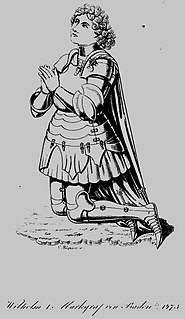
Margrave William of Hachberg-Sausenberg was the son of Margrave Rudolf III of Hachberg-Sausenberg and Anne of Freiburg-Neuchâtel. He ruled from 1428 to 1441, and abdicated on 21 June 1441 in favor of his infant sons, Rudolf IV and Hugo. As they were still infants, his cousin Count John of Freiburg-Neuchâtel took over the government as regent.
Nicole Oresme, French philosopher (b. 1325) deaths

Nicole Oresme, also known as Nicolas Oresme, Nicholas Oresme, or Nicolas d'Oresme, was a French philosopher of the later Middle Ages. He wrote influential works on economics, mathematics, physics, astrology and astronomy, philosophy, and theology; was Bishop of Lisieux, a translator, a counselor of King Charles V of France, and one of the most original thinkers of 14th-century Europe.
Anna von Schweidnitz, empress of Charles IV (b. 1339) deaths

Anna of Schweidnitz (Świdnica) was Queen of Bohemia, German Queen, and Empress of the Holy Roman Empire. She was the third wife of Emperor Charles IV.

Charles IV, also known as Charles of Luxembourg, born Wenceslaus, was the first King of Bohemia to become Holy Roman Emperor. He was a member of the House of Luxembourg from his father's side and the Bohemian House of Přemyslid from his mother's side; he emphasized the latter due to his lifelong affinity for the Bohemian side of his inheritance, and also because his direct ancestors in the Přemyslid line included two saints.
Ulrich III, Count of Württemberg (b. c. 1286) deaths

Ulrich III Count of Württemberg from 1325 until 1344.
Robert II, Count of Artois (b. 1250) deaths
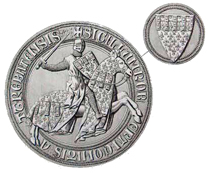
Robert II was the Count of Artois, the posthumous son and heir of Robert I and Matilda of Brabant. He was a nephew of Louis IX of France. He died at the Battle of the Golden Spurs.
Pierre Flotte, French politician and lawyer deaths
Pierre Flotte or Pierre Flote was a French legalist, Chancellor of France and Keeper of the Seals of Philip IV the Fair. He was taught Roman law at the University of Montpellier, and was considered one of the best lawyers and legalists of his time. He led negotiations with the Roman Curia, England and Germany.
Robert the Bruce, Scottish king (d. 1329) births

Robert I, popularly known as Robert the Bruce, was King of Scots from 1306 to his death in 1329. One of the most renowned warriors of his generation, Robert eventually led Scotland during the First War of Scottish Independence against England. He fought successfully during his reign to regain Scotland's place as an independent kingdom and is now revered in Scotland as a national hero.
Otto I Wittelsbach, Duke of Bavaria (b. 1117) deaths
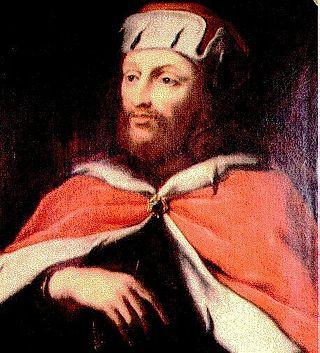
Otto I, called the Redhead, was Duke of Bavaria from 1180 until his death. He was also called Otto VI as Count Palatine of Bavaria from 1156 to 1180. He was the first Bavarian ruler from the House of Wittelsbach, a dynasty which reigned until the abdication of King Ludwig III of Bavaria in the German Revolution of 1918.
Amalric I of Jerusalem (b. 1136) deaths
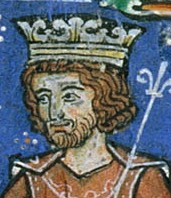
Amalric or Amaury I was King of Jerusalem from 1163, and Count of Jaffa and Ascalon before his accession. He was the second son of Melisende and Fulk of Jerusalem, and succeeded his older brother Baldwin III. During his reign, Jerusalem became more closely allied with the Byzantine Empire, and the two states launched an unsuccessful invasion of Egypt. He was the father of three future rulers of Jerusalem, Sibylla, Baldwin IV, and Isabella I.
Olga of Kiev (b. 890) deaths
Olga was a regent of Kievan Rus' for her son Sviatoslav from 945 until 960. Following her baptism, Olga took the name Elenа. She is known for her subjugation of the Drevlians, a tribe that had killed her husband Igor of Kiev. Even though it was her grandson Vladimir who converted the entire nation to Christianity, because of her efforts to spread Christianity through Rus', Olga is venerated as a saint in the Eastern Orthodox Church with the epithet "Equal to the Apostles". Her feast day is 11 July.
Rudolph II of Burgundy (b. 880) deaths
Rudolph II, a member of the Elder House of Welf, was King of Burgundy from 912 until his death. He initially succeeded in Upper Burgundy and also ruled as King of Italy from 922 to 926. In 933 Rudolph acquired the Kingdom of Lower Burgundy (Provence) from King Hugh of Italy in exchange for the waiver of his claims to the Italian crown, thereby establishing the united Kingdom of Burgundy.
Anthemius, Roman emperor (b. 420) deaths

Procopius Anthemius was western Roman emperor from 467 to 472.
Bardaisan, Syrian astrologer, scholar, and philosopher (d. 222) births
Bardaisan, known in Arabic as Ibn Daisan and in Latin as Bardesanes, was a Syriac-speaking Assyrian or Parthian Christian gnostic and founder of the Bardaisanites. A scientist, scholar, astrologer, philosopher, hymnographer, and poet, Bardaisan was also renowned for his knowledge of India, on which he wrote a book, now lost.
Christian Feast Day: Benedict of Nursia

Benedict of Nursia was an Italian Christian monk, writer, and theologian who is venerated in the Catholic Church, the Eastern Orthodox Church, the Oriental Orthodox Churches, the Anglican Communion and Old Catholic Churches. He is a patron saint of Europe.
Christian Feast Day: Olga of Kiev
Olga was a regent of Kievan Rus' for her son Sviatoslav from 945 until 960. Following her baptism, Olga took the name Elenа. She is known for her subjugation of the Drevlians, a tribe that had killed her husband Igor of Kiev. Even though it was her grandson Vladimir who converted the entire nation to Christianity, because of her efforts to spread Christianity through Rus', Olga is venerated as a saint in the Eastern Orthodox Church with the epithet "Equal to the Apostles". Her feast day is 11 July.
Christian Feast Day: Pope Pius I
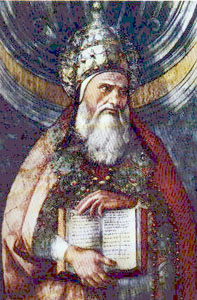
Pope Pius I was the bishop of Rome from c. 140 to his death c. 154, according to the Annuario Pontificio. His dates are listed as 142 or 146 to 157 or 161, respectively. He is considered to have opposed both the Valentinians and Gnostics during his papacy. He is considered a saint by the Catholic Church and the Eastern Orthodox Church with a feast day in 11 July, but it is unclear if he died as a martyr.
Christian Feast Day: July 11 (Eastern Orthodox liturgics)

July 10 - Eastern Orthodox Church calendar - July 12
China National Maritime Day (China)
China National Maritime Day, officially referred to as Maritime Day of China, also known as China Maritime Day, Maritime Day in China, Chinese: 中国航海日; pinyin: hanghairi, is celebrated July 11, 2005, commemorating marked Zheng He's first voyage. The date marks the 600th anniversary of the ocean voyages of Zheng He, the Ming dynasty (1368–1644) navigator, who went on seven voyages to show China's might to the rest of the world, under the command of Yongle Emperor. These voyages sought to prove to the Chinese people that the usurper Yongle was worthy of the throne and the gods accepted him with the Mandate of Heaven. The celebration's creation honors China's commitment to the International Maritime Organization, of which it is a member.

China, officially the People's Republic of China (PRC), is a country in East Asia. It is the world's most populous country, with a population exceeding 1.4 billion, slightly ahead of India. China spans the equivalent of five time zones and borders fourteen countries by land, the most of any country in the world, tied with Russia. China also has a narrow maritime boundary with the disputed Taiwan. Covering an area of approximately 9.6 million square kilometers (3,700,000 sq mi), it is the world's third largest country by total land area. The country consists of 22 provinces, five autonomous regions, four municipalities, and two Special Administrative Regions. The national capital is Beijing, and the most populous city and financial center is Shanghai.
Day of the Bandoneón (Argentina)

Bandoneón Day is celebrated on 11 July each year in Argentina. This date was chosen to mark the birth of the man who is considered the "Supreme Bandoneón of Buenos Aires", the musician Aníbal Troilo.

Argentina, officially the Argentine Republic, is a country in the southern half of South America. Argentina covers an area of 2,780,400 km2 (1,073,500 sq mi), making it the second-largest country in South America after Brazil, the fourth-largest country in the Americas, and the eighth-largest country in the world. It shares the bulk of the Southern Cone with Chile to the west, and is also bordered by Bolivia and Paraguay to the north, Brazil to the northeast, Uruguay and the South Atlantic Ocean to the east, and the Drake Passage to the south. Argentina is a federal state subdivided into twenty-three provinces, and one autonomous city, which is the federal capital and largest city of the nation, Buenos Aires. The provinces and the capital have their own constitutions, but exist under a federal system. Argentina claims sovereignty over the Falkland Islands, South Georgia and the South Sandwich Islands, and a part of Antarctica.
Day of the Flemish Community (Flemish Community of Belgium)
The Day of the Flemish Community of Belgium is an annual commemoration in the Flemish Community in Belgium on 11 July which marks the anniversary of the Battle of the Golden Spurs (Guldensporenslag) in 1302.

The Flemish Community is one of the three institutional communities of Belgium, established by the Belgian constitution and having legal responsibilities only within the precise geographical boundaries of the Dutch-language area and of the bilingual area of Brussels-Capital. Unlike in the French Community of Belgium, the competences of the Flemish Community have been unified with those of the Flemish Region and are exercised by one directly elected Flemish Parliament based in Brussels.

Belgium, officially the Kingdom of Belgium, is a country in Northwestern Europe. The country is bordered by the Netherlands to the north, Germany to the east, Luxembourg to the southeast, France to the southwest, and the North Sea to the northwest. It covers an area of 30,528 km2 (11,787 sq mi) and has a population of more than 11.5 million, making it the 22nd most densely populated country in the world and the 6th most densely populated country in Europe, with a density of 376 per square kilometre (970/sq mi). The capital and largest city is Brussels; other major cities are Antwerp, Ghent, Charleroi, Liège, Bruges, Namur, and Leuven.
Eleventh Night (Northern Ireland)

In Northern Ireland, the Eleventh Night or 11th Night, also known as "bonfire night", is the night before the Twelfth of July, an Ulster Protestant celebration. On this night, large towering bonfires are lit in Protestant loyalist neighbourhoods, and are often accompanied by street parties and loyalist marching bands. The bonfires are mostly made of wooden pallets. They originally celebrated the Williamite conquest of the 1690s, which began the Protestant Ascendancy in Ireland. Eleventh Night events are regularly condemned for sectarianism or ethnic hatred against Irish Catholics and Irish nationalists, such as the burning of Irish tricolours, and for damage and pollution caused. Some are controlled by loyalist paramilitaries, and authorities may be wary of taking action against controversial bonfires. Not all bonfires are controversial however, and there have been attempts to de-politicize some bonfires and make them more family-friendly and environmentally-friendly. In 2021, there were about 250 Eleventh Night bonfires.

Northern Ireland is a part of the United Kingdom, situated in the north-east of the island of Ireland, that is variously described as a country, province or region. Northern Ireland shares a border to the south and west with the Republic of Ireland. In 2021, its population was 1,903,100, making up about 27% of Ireland's population and about 3% of the UK's population. The Northern Ireland Assembly, established by the Northern Ireland Act 1998, holds responsibility for a range of devolved policy matters, while other areas are reserved for the UK Government. Northern Ireland cooperates with the Republic of Ireland in several areas.
Free Slurpee Day (Participating stores of the 7-Eleven chain in North America)
7-Eleven, Inc., stylized as 7-ELEVEn, is a multinational chain of retail convenience stores, headquartered in Dallas, Texas. The chain was founded in 1927 as an ice house storefront in Dallas. It was named Tote'm Stores between 1928 and 1946. After 70% of the company was acquired by an affiliate Ito-Yokado in 1991, it was reorganized as a wholly owned subsidiary of Seven & I Holdings.
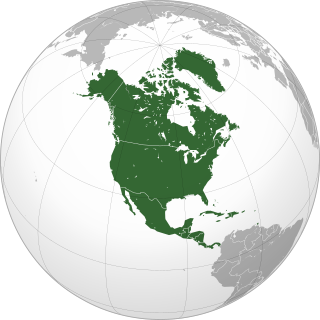
North America is a continent in the Northern Hemisphere and almost entirely within the Western Hemisphere. It is bordered to the north by the Arctic Ocean, to the east by the Atlantic Ocean, to the southeast by South America and the Caribbean Sea, and to the west and south by the Pacific Ocean. Because it is on the North American Tectonic Plate, Greenland is included as a part of North America geographically.
National Day of Remembrance of the victims of the Genocide of the Citizens of the Polish Republic committed by Ukrainian Nationalists (Poland, established by the 22 July 2016 resolution of Sejm in reference to the July 11, 1943 Volhynian Bloody Sunday)
The National Day of Remembrance of the victims of the Genocide of Citizens of the Polish Republic committed by Ukrainian Nationalists is an official commemorative date in Poland, celebrated on July 11. It is not a day off. The day of July 11 was chosen because it was July 11, 1943, that became the apogee of the Massacres of Poles in Volhynia and Eastern Galicia when armed units of Ukrainian nationalists simultaneously attacked 99 settlements inhabited by ethnic Poles.
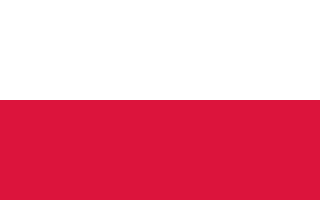
Poland, officially the Republic of Poland, is a country in Central Europe. It is divided into 16 administrative provinces called voivodeships, covering an area of 312,696 km2 (120,733 sq mi). Poland has a population of over 38 million and is the fifth-most populous member state of the European Union. Warsaw is the nation's capital and largest metropolis. Other major cities include Kraków, Wrocław, Łódź, Poznań, Gdańsk, and Szczecin.

The Sejm, officially known as the Sejm of the Republic of Poland, is the lower house of the bicameral parliament of Poland.

On Sunday July 11, 1943, the OUN-UPA death squads aided by the local Ukrainian peasants simultaneously attacked at least 99 Polish settlements within the Wołyń Voivodeship of the prewar Second Polish Republic under the German occupation. It was a well-orchestrated attack on people gathered for a Sunday mass at Catholic churches. The towns affected included Kisielin, Poryck, Chrynów, Zabłoćce, Krymn, with dozens of other towns attacked at different dates with tens of churches and chapels burned to the ground. The Volhynian massacres spread over four prewar voivodeships including Wołyń with 40,000- 60,000 victims, as well as Lwów, Stanisławów and Tarnopol in Lesser Poland with 30,000- 40,000 Poles murdered for the total of 100,000 Polish victims of UPA terror. The Bloody Sunday of July 11, 1943 is not to be confused with the Stanisławów Ghetto Bloody Sunday massacre of 10,000 to 12,000 Polish Jews on October 12, 1941, before the Stanisławów Ghetto announcement.
Gospel Day (Kiribati)
The following are public holidays in Kiribati. Dates refer to 2002.

Kiribati, officially the Republic of Kiribati, is an island country in Oceania in the central Pacific Ocean. The permanent population is over 119,000 (2020), more than half of whom live on Tarawa atoll. The state comprises 32 atolls and one remote raised coral island, Banaba. There is a total land area of 811 square kilometres dispersed over 3.5 million km2 (1.4 million sq mi) of ocean.
Imamat Day (Isma'ilism)
Imamat Day, also known as Khushali, is celebrated by Nizari Ismaili Shiʿi Muslims to mark the anniversary of the day that their present (Hazar) Imam Aga Khan IV succeeded his predecessor to become the Imam of the Time.

Isma'ilism is a branch or sub-sect of Shia Islam. The Isma'ili get their name from their acceptance of Imam Isma'il ibn Jafar as the appointed spiritual successor (imām) to Ja'far al-Sadiq, wherein they differ from the Twelver Shia, who accept Musa al-Kadhim, the younger brother of Isma'il, as the true Imām.
National Day of Commemoration, held on the nearest Sunday to this date (Ireland)
In Ireland, the National Day of Commemoration commemorates all Irish people who died in past wars or United Nations peacekeeping missions. It occurs on the Sunday nearest 11 July, the anniversary of the date in 1921 that a truce was signed ending the Irish War of Independence. The principal ceremony is held at the Royal Hospital Kilmainham, Dublin, Ireland.
The first day of Naadam (July 11–15) (Mongolia)

Naadam is a traditional festival celebrated in Mongolia, Inner Mongolia and Tuva Republic. The festival is also locally termed "eriin gurvan naadam", "the three games of men".

Mongolia is a landlocked country in East Asia, bordered by Russia to the north and China to the south. It covers an area of 1,564,116 square kilometres, with a population of just 3.3 million, making it the world's most sparsely populated sovereign nation. Mongolia is the world's largest landlocked country that does not border a closed sea, and much of its area is covered by grassy steppe, with mountains to the north and west and the Gobi Desert to the south. Ulaanbaatar, the capital and largest city, is home to roughly half of the country's population.
World Population Day (International)

World Population Day is an annual event, observed on July 11 every year, which seeks to raise awareness of global population issues. The event was established by the Governing Council of the United Nations Development Programme in 1989. It was inspired by the public interest in Five Billion Day on July 11, 1987, the approximate date on which the world's population reached five billion people. World Population Day aims to increase people's awareness on various population issues such as the importance of family planning, gender equality, poverty, maternal health and human rights.
Lists of holidays by various categorizations.